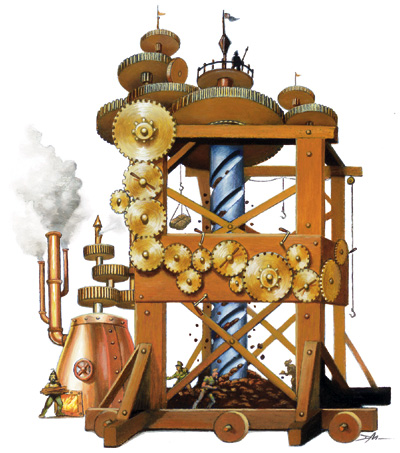Dragonlance Campaign Setting by Libertad!
Introduction
Original SA post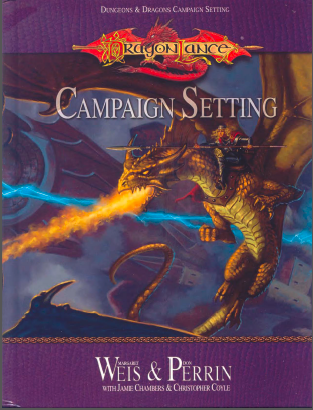
Ah, Dragonlance, a grand setting with humble beginnings. The setting's creators, Margaret Weis and Tracy Hickman, came up with the fictional world during a car trip, and were hired later by TSR to write adventures. Around this time there was plenty of information on dungeons in RPG sourcebooks, but not so much on Dragons. Hickman suggested a series of linked adventures, and the design team decided that a series of novels should accompany it.
And thus the Dragonlance Chronicles were born. The setting proved wildly popular, even beyond the Dungeons & Dragons fandom, earning a spot on the New York Times' Bestseller list. For a time it even shared a spotlight with the established Forgotten Realms as a popular setting.
Of course the series had its controversy as well. Many chided the original modules as railroady, the kender race proved a hit with disruptive Chaotic Stupid players, and the "update" to the setting's 5th Age and temporary abandonment of the D&D ruleset rivaled our modern Edition Wars in dividing the fanbase. But the world and its stories still holds a place in the hobby's history for being revolutionary for its time, examining what a world functioning under the D&D ruleset would be like, and popularizing the "epic journey to save the world" model as a campaign concept.
Love it or hate it, there are few other settings like Dragonlance.
The Dragonlance Campaign Setting is a 3.5 sourcebook, published by Wizards of the Coast in 2003. Technically a 1st-party book, it received no further official support, with the production of future sourcebooks delegated to Margaret Weis in charge of Sovereign Press. It was this book I was first introduced to the world of Dragonlance.
Introduction
quote:
Welcome, friend, to the world of Krynn. Step into the River of Time and let it carry you along its slow-moving current as it wends its way through the history of the continent of Ansalon. Be a part of that history, as you join the never-ending struggle between chaos and order. On Krynn, the Gods of Good and Evil war eternally, joined in the battle by mortal beings such as yourself and Krynn's true children-the dragons.
You may journey with wizards as they risk their lives to take the test that can grant them great power. You may quest with brave knights to prove their honor and worth or discover heroes in ordinary people who fight for their homes and loved ones. Your travels will take you through lands of mysterious ruins populated by terrifying creatures. You may fly on the backs of dragons in the service of your cause, be it good or evil.
The continent of Ansalon is a land of marvelous beauty with a rich and fascinating history. You can choose to fight on the side of good, serve the cause of evil, or work to maintain the balance of the world. You may restore lost knowledge to the people or search for powerful magic artifacts to aid your struggle. You will face the awesome power of enemy wyrms and soar the skies on the backs of dragons that serve your cause.
Welcome to the Dragonlance campaign.
The book's beginning gives an overview of Dragonlance and its major themes, along with some pertinent setting information. Basically the history of the world is divided into Five Ages: the Age of Starbirth, an era of prehistory when there were only Gods and souls creating the world; the Age of Dreams, a distant age of legend, rise and fall of the first empires, discovery of magic, birth of the mortal races, etc; the Age of Might, when the mighty Empire of Istar rose and fell in its zeal to cleanse the world of evil; the Age of Despair, begun when the wrath of the Gods brought about the Cataclysm and retreated from the world; and the Age of Mortals, the current age where the people now no longer need rely upon the Gods for magic, an era where five titanic Dragon Overlords reshaped the land to their whims. The last two Ages (Despair and Mortals) are the ones with the most in-game support and detail, both within living memory (the Age of Mortals began 30 years before the current date).
The setting takes place on the continent of Ansalon, which is on the planet of Krynn. Ansalon is located in the southern hemisphere and measures 1,300 miles west to east and 1,000 miles north to south. It was a large, unbroken landmass originally, but the Cataclysm at the end of the Third Age fractured it. Despite its relatively small size there are many unexplored regions, from monster-filled wilderness to inhospitable wastelands and mountain ranges. The continent of Taladas is far to the northeast of Ansalon, home to many of the same races, though the societies have progressed separately. The good-aligned metallic dragons claim the Dragon Isles to the north of Ansalon as their ancestral homeland, and almost all of them left Ansalon in a self-imposed exile during the Age of Despair.
There's also a short blurb on Krynn's races, but since they're part of Chapter One we'll skip that and talk about the Campaign.
Two themes are integral to Dragonlance. Epic Fantasy is a genre of high adventure, where the PCs take part in grand struggles and whose deeds pass into myth and legend. Even small adventures can have wider consequences down the line, and PCs who attain higher levels have the chance to make a living mark upon Krynn's history.
The other major theme is the Conflict of Good and Evil. Although Dragonlance uses the nine-fold Alignment axis, Good, Evil, and Balance (Neutrality) are the major cosmic forces. Neither can exist without the other, and even if one side appears victorious for long (such as in the Age of Might or Despair), the cosmic pendulum might swing to the other side. Individuals are chosen to champion the cause of moral forces, even in an unwitting role. But even then mortals can defy the gods and forge their own destinies, like Raistlin did in the Legends trilogy. Although Good and Evil are absolute forces, the workings of the world and the choices people make can redeem corrupt villains or even corrupt causes with good intent.
Libertad's Notes: This is what separates Dragonlance from many other settings, for both good and ill. While one could probably try running a "standard" D&D campaign of dungeon delvers, it isn't really designed for it. However, as evidenced by the Original Chronicles and Key of Destiny, it is a very friendly setting to world-saving heroics and PCs deciding the fate of Ansalon long-term. The game is a low-magic world, and although PCs encounter plenty of magic and monsters, a lot of the setting was designed to make the major events stand out that much more. There's no real magic item shops beyond spell components and scrolls/potions/wand stuff, as permanent magic items are supposed have their own legacies and stories behind them. Arcane magic is tightly regulated by the Wizards of High Sorcery for its destructive potential, although the mages of the remaining Tower of Wayreth have enough power to even repel a would-be Godling. Several countries are idyllic and go through periods of peace, only to be besieged by a hostile outside force for the PCs to protect them against (Silvanesti, Solamnia, Hylo). In the non-eventful times they're not really packed with adventure opportunity, sort of like the Shire in the Lord of the Rings.
Basically, Dragonlance is suited for a more epic, Tolkienish style of gameplay in comparison to settings like Eberron, where danger and intrigue lurks behind every corner and greed and glory are just as reasonable motivations as heroism. I would not describe it as a weakness so much as a quirk which distinguishes the setting style.
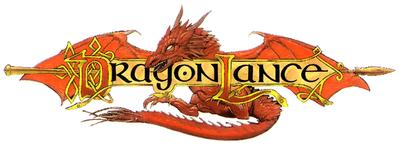
Dragonlance Campaign Setting Chapter One: Races
Now we start into the book proper. Here we look at the major (and some minor) races of Krynn and briefly into their personalities and culture.
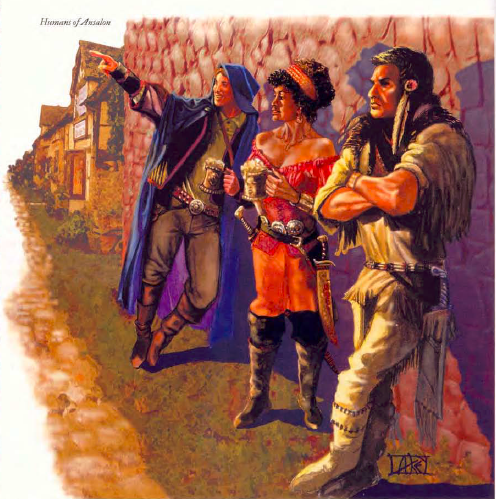
The Humans are one of the three elder races of Krynn. Created by Gilean and the Gods of Balance, humans were the first race to be gifted with free will and are known for their variety and ambitiousness in contrast with their short lives. Generally humans are divided into the categories of "Civilized" (agricultural, urban and higher technology level) and "Nomadic" (hunter-gatherer, closer to nature spirits) humans, but even then these are more arbitrary categories. The Nomadic humans might be viewed as more primitive and barbarous, but have just as intricate histories and customs, and some even have their own great cities (the Khur in particular). Nomadic humans, however, are more suspicious of outsiders given that their homes traditionally did not have as much contact with other groups.
Prominent civilized human groups include the Abanisinians (frontier folk, have a history of turning to false gods), Ergothians (powerful nation of mariners in western Ansalon), Kharolians (southwest Ansalon, friendlier to Wizards due to close proximity to the Tower, keep extensive genealogical records), Solamnics (lawful good nation of chivalric knights), Nerakans (descendents of the ancient Istarans, live in Neraka and are the "bad guy" nation of the setting), and Nordmen (live in humid jungles of the north, known for their horses).
Prominent nomadic human groups include Abanisinian Plainsfolk (based off of real-world Great Plains Native Americans), the Khurish people (based off of nomadic Arab tribes), Nordmaarian Horselords (live in the plains of Nordmaar), Sea Folk (or Saifhumi, ply the waters of northeast Ansalon), the Ice Folk (far south of Ansalon, live in igloos and navigate tundras with giant wind-powered sleds), and Taman Busuk nomads (live in the mountains of Neraka, recruited into the Dragon Empire's armies during the Age of Despair). Nomads are also more likely to worship Chislev, goddess of nature.
All humans, both civilized and nomadic, speak Common and one regional dialect. There isn't much more to say about humanity as a whole without delving into the various ethnic groups. I might detail them later in Chapter Six: Geography of Ansalon.
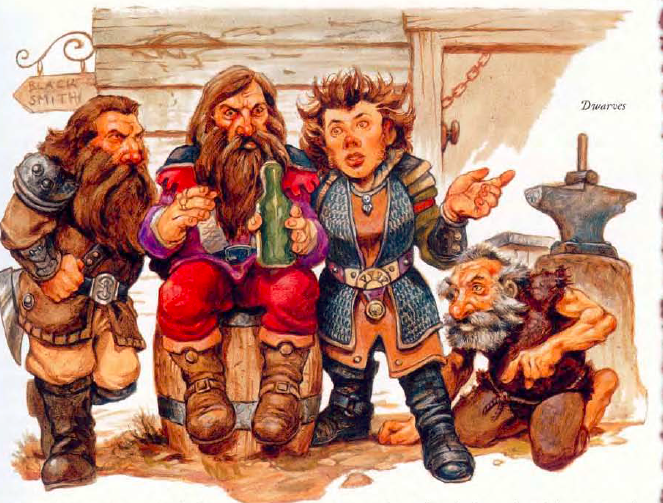
The Dwarves are an industrious people who traditionally live in underground kingdoms. They were one of the races created when the Graygem of Gargath cracked in the Age of Dreams from Gnomish stock. Dwarves are proud of their facial hair, have extensive ties to family and clan, and are primarily Lawful Neutral (as opposed to Lawful Good in most settings). The primary dwarven kingdoms are Thorbadin and Thoradin, although there are scattered communities across Ansalon. Reorx, God of the Forge, is their most popular deity. "By Reorx's beard!" is a common saying uttered in dwarven halls.
Dwarves are further divided into mountain dwarves, hill dwarves, dark dwarves, and gully dwarves. Mountain dwarves are those clans who remained within Thorbadin. They include the Hylar (Highest), the oldest of the clans and are the nobles of the mountain dwarves; the Daewar (Dearest), a clan of proud warriors; and the Klar, a clan of hill dwarves trapped within Thorbadin when the realm was sealed off from the rest of the world. They were an oppressed underclass, allowed only most menial jobs and confined to impoverished sections of town, and their wiry beards and darting eyes gave them an undeserved reputation as madmen.
The Hill Dwarves are all of the Neidar (Nearest) clan. When the Cataclysm rocked the world, many dwarves living above Thorbadin rushed to the kingdom in desparate need of food. The kingdom did not have enough resources to care for them, and kept them out. This led to bitterness and hatred which erupted into the Dwarfgate Wars as the Neidar attempted to fight their way into Thorbadin, but failed. A people without a home, the Neidar lived among non-dwarven communities and in their own towns, nursing a longstanding grudge against their mountain dwarf brethren.
The wizard Fistandantalus, who fought on the Neidar side, betrayed them and created a magical cataclysm which killed thousands on both sides. Thus the overall dwarven hatred and distrust for wizards.
The Dark Dwarves are two clans of mountain dwarves who live deeper than others, completely in darkness. They are known for being evil and treacherous, and are much paler than others of their kind. The Theiwar (Thankless) clan became allergic to sunlight sometime around the Age of Dreams. They are very fair-skinned and have a knack for arcane magic. The Daegar (Deepest) clan were once noble mountain dwarves, but sided with rebel Theiwar and were banished with them to the deeper reaches.
Dark Dwarves have all the traits of PHB dwarves, except they have -4 Charisma, longer sight of Darkvision, racial bonuses on Hide, Listen and Move Silently checks, take penalties to rolls under bright sunlight, and have Rogue as a favored class. They’re definitely geared towards stealthier characters, but the light sensitivity is a big hindrance for most campaigns.
Which brings us to Gully Dwarves. They are of clan Aghar (Anguished), and are one of the 3 comic relief races of Dragonlance and thus hated by a lot of gamers. Basically gully dwarves are believed to be the result of gnome-dwarf interbreeding in the distant Age of Dreams, inheriting the worst traits of both. They earned their name for their poor status and living conditions.
Gully Dwarves live amid the ruins, sewers, and other places untouched by the other races of Ansalon. Their lives revolved around simple survival, of hunting and scrounging food most of the time. They are incredibly stupid, most being unable to count past 2 (which is anything more than 1 to them). They believe themselves to be abandoned by Reorx and thus worship no Gods. They're mostly Chaotic Neutral, having no code of rules beyond survival and not cared for by either side of Good or Evil. Instead they appeal to ancestral spirits they believe live in objects; a dead rat or lizard or wooden spoon might have wondrous powers (which don't exist) to a Gully Dwarf. They also only fight when backed into a corner, pleading piteously to have their lives spared. None of the other races of Ansalon like them, and are usually chased out of communities or forced to live in forgotten spaces of cities.
Gully Dwarves as a race are incredibly underpowered. They have +2 Dexterity and Constitution, but -4 Intelligence and Charisma. They receive bonuses on stuff gully dwarves are good at (survival checks, diplomacy checks to convince enemies not to harm them), but they receive penalties against fear effects and Intimidation rolls for their cowardice. Gully dwarves make poor thieves and arcane casters due to their slow speed and intelligence/charisma penalties (plus kender have more relevant bonuses). They're not good melee brutes due to their small size, and overall lose much more than they gain in terms of racial traits. There's nothing a gully dwarf can do that an existing race can't do better.
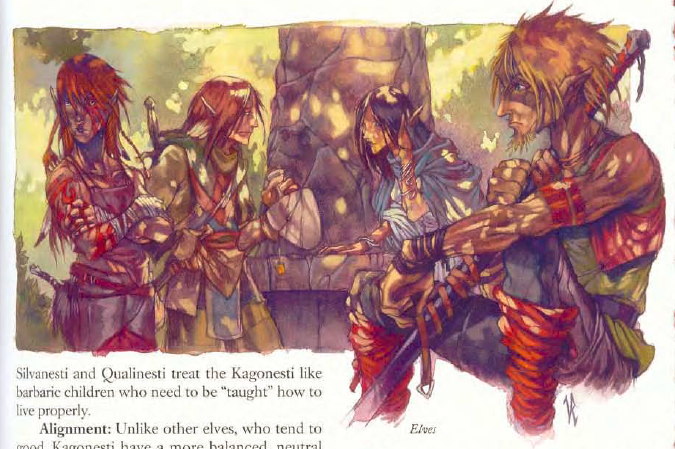
The Elves of Krynn are one of the three original mortal races, created by the good-aligned Gods of Light. As a people they have long lifespans and seek to live in harmony with nature. In addition to low-light vision and the common PHB elven racial traits, Dragonlance elves have Elfsight, which grants Darkvision up to 30 feet.
Qualinesti Elves live in the forest nation of Qualinost. They tend to have better relations with other races in comparison to their more xenophobic kin (+1 bonus on Diplomacy and Sense Motive), but even then they look down upon them as crude and unsophisticated. They're much more indivualistic, and their government is run by a Senate which elects their ruler, the Speaker of the Sun. Twice they had to leave their homeland, most recently after a battle with Beryl the Green Dragon Overlord turned their capital city to ruin. Like the Silvanesti they are a people living outside their ancestral home.
Kagonesti Elves, also known as Wilder Elves, live in the forests of Southern Ergoth. They are a technologically primitive, hunter-gatherer society and believe that every aspect of the world possesses a spirit. They decorate their bodies with feathers, paint, tattoos, leather fringe, and other accessories for symbolic meanings (family history, honoring spirits and granting good fortune, etc). They persevered through Ergothian incursions, the depredations of the Dragonarmies, the Dragon Overlord Gellidus, and even enslavement at the hands of Qualinesti and Silvanesti. This has made them resentful of humans and other elves for constant attacks on their way of life.
Oh, did I mention that the "high" elves in this setting are total dicks? Yeah, every negative stereotype about elves in Tolkienish fantasy has been done tenfold in Dragonlance.
Kagonesti have +2 Dexterity, -2 Intelligence and Charisma, +1 bonus on Knowledge (Nature) and Survival, and are proficient with the longspear instead of the longsword. Their favored class is Ranger.
Silvanesti Elves are isolationist, arrogant people who are extremely racist against everyone else. They are the most beautiful of the elves and have one of the most advanced societies in terms of scholarly and magical might, but their cold aloofness makes it hard for others to appreciate this. They view half-elves as abominations, Kagonesti as savage children, and Qualinesti as "poor, uncultured cousins." They have one of the most strict caste systems in Ansalon, where a person's House determines their station and occupation in life. They traditionally lived in the forest nation of Silvanesti in southeast Ansalon, but after a joint Dark Knight/minotaur invasion drove them out they've been forced to live in the arid regions of Khur and the Plains of Dust. They are strongly lawfully-aligned.
quote:
Silvanesti are aligned with good, but they believe so highly in their own purity that goodness can be taken to extremes.
Racism: an extreme form of Good.
In terms of game stats they have standard elf stuff, but +2 Dexterity and Intelligence, and -2 to Constitution and Charisma. They have +1 on Knowledge (Arcana) and Spellcraft checks.
Half-elves are treated as outcasts by both humans and elves. For a long time elven-human relations were not very good, and most children between the two post-Age of Might were borne out of rape by human bandits. As such, half-elves grow up unwanted and tend to be more likely to reject society and authority. They too have Elfsight of 30 foot darkvision like their elven parents.
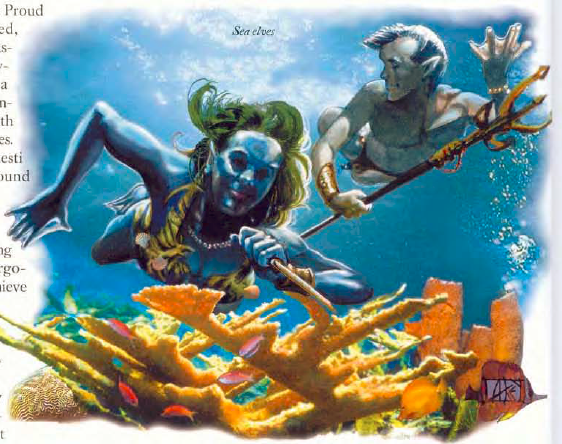
Sea Elves live in Krynn’s many oceans. They are separated into two groups, the Dargonesti (Deep Elves), who stick to deep water and the Dimernesti (Shoal Elves), who live closer to the surface and coastlines near coral reefs. They are very tall, ranging six to seven feet on average, and have webbed fingers and toes and gill slits on their necks. Dargonesti have many deep-sea citadels and a glorious kingdom, Watermere, while the Dimernesti mostly have small family units. Also, Dargonesti have such a fearsome reputation as aquatic warriors that many sailors fear them more than sharks!
Sea elves of both varieties have standard elf traits, plus they can swim as fast as a human walks on land and can breathe underwater and sense their depth intuitively. They are instead proficient with the trident, net and longspear, and while they can live on land they dehydrate quickly and suffer penalties on rolls if they don’t soak in water for an hour or two. Dargonesti can change shape into a porpoise, Dimernesti into a sea otter. Dargonesti also get some spell-like abilities which aid in concealment and misdirection (darkness, obscuring mist, blur, and dancing lights). The traits are very flavorful and make the sea elves the most unique of the bunch.
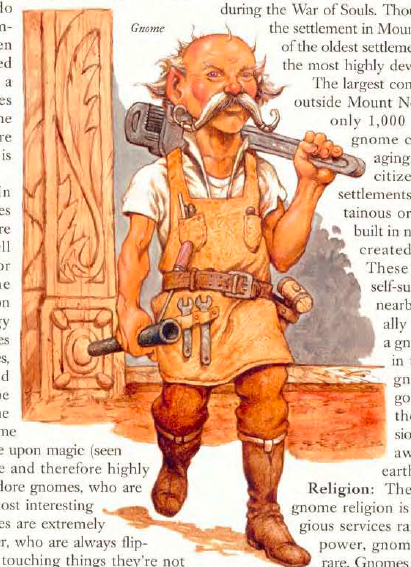
Gnomes are the tinkers and inventors of Krynn. Originally they were human worshipers of Reorx changed into gnomes by said deity for their arrogance. Today gnomes pursue all manner of scientific innovation in their home of Mount Nevermind, a dormant volcano. The gnomes are the most technologically advanced civilization in Ansalon, having mastered the secrets of steam power, electricity, and intricate mechanical clockwork devices. Their use among the other races is limited, as gnomes love to experiment just to experiment and most of their contraptions are needlessly complex and subject to unexpected quirks. Gnomes view this as the inevitable consequence of progress, that a project’s failure can give rise to an insightful new lead for further development.
An important aspect of Gnomish culture is the Life Quest. It is a singular goal a gnome dedicates his life to achieving, more important than anything else. It can range from all manner of subjects, although all of them relate to the pursuit and expansion of knowledge. A gnome who completes his or her Life Quest is said to earn an honored position by Reorx in the afterlife, although gnomes who complete 3 or more Life Quests are exiled from the community for making everyone else look bad. On that note, gnomes of evil alignment have a tendency to be literally catapulted out of their communities; gnomish cities also use catapults as a means of transportation in lieu of elevators and stairs.
Gnomes tend to be very talkative and obsessed with their studies, often getting overexcited and running words together to express their thoughts at the moment before they’re lost. They’re capable of speaking and listening to others at the same time, and conversations with other races tends to be a frustrating affair for both parties.
Mechanics-wise gnomes have +2 Dexterity and Intelligence but -2 to Strength and Wisdom (the archetypical absent-minded professor). They also gain a bonus on alchemy checks and a single craft, profession, and knowledge skill depending upon their Guild. Intense dedication to Life Quests has made them strongly determined, granting them a +2 bonus on Will Saves.
There are also “mad” gnomes, who do not have the gnomish inspiration for tinkering or the passion for Life Quests. They tend to be outcasts or pitied, but they’re closer to humans in mentality and speech. They lose their Intelligence and Wisdom modifiers, along with Will Saves, but they gain +2 on Disable Device and Open Locks since they’re skilled at building smaller, more compact, and more reliable machinery.
A lot of gamers hate gnomes along with kender and gully dwarves, but I honestly like them. Their behavior is not going to be disruptive to parties if role-played out, and their advanced technology provides Dungeon Masters the excuse to insert steampunk and mad science stuff into their sessions without it jarring the rest of the setting.
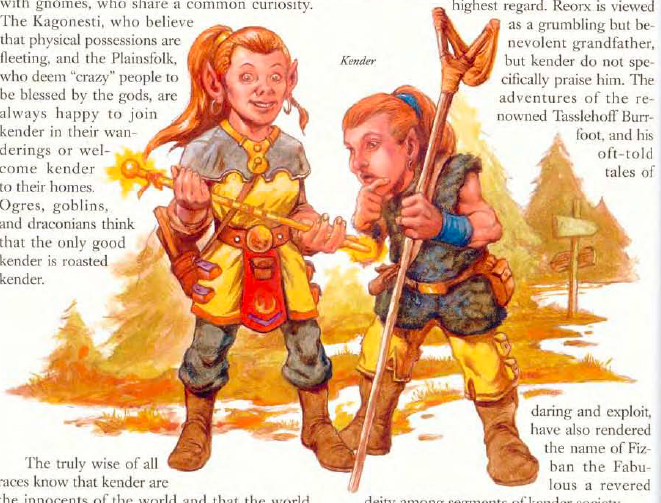
Oh boy, Kender. Basically kender are the children of the races of Krynn. They approach life and new things with intense curiosity, often without regard to their own safety. Every day is a new opportunity for adventure, every locked door a beckoning to find out what’s behind it, every neat-looking object to be fondled and absent-mindedly forgotten in their pocket without any regard to its original owner.
On that last note, this bit of Kender behavior is known as “borrowing.” Hickman and Weis were uncomfortable with having a traditional greedy thief character in their story, so instead they made Tasslehoff Burrfoot and the kender. When a kender finds something cool, they appropriate something which captures their eye. The concept of private property and privacy are alien to their minds, and they get so easily distracted they constantly forget what they took. They resent accusations of thievery, and have a handy list of excuses for why someone’s item ended up in their possession (such as “I was keeping it safe in my possession. You never know when somebody might steal it.”) It’s implied that this behavior is inherent to their race and not the result of cultural conditioning, meaning that any attempts to teach them will be fruitless. Kender also don’t really feel fear, although they understand that certain behavior might result in their deaths. The text also waffles between the Kender being likable and getting along with everyone to them being common pests who drive people crazy and are chased away all the time.
Mechanics-wise they have +2 Dexterity but -2 Strength and Wisdom. They’re immune to fear and intimidation and gain +2 on Spot, Sleight of Hand, and Open Lock skills (the latter two they can make untrained). They’re also great at pissing people off and gain a +4 racial bonus on taunt checks. Taunt is a new application of the bluff skill where a successful check inflicts -1 on attack rolls and Armor Class. They’re also bad at concentration, making them poor spellcasters (-4 on Concentration checks).
The problem with Kender is that a lot of players view them as the perfect excuse to engage in douchebag behavior, such as stealing items from fellow PCs for themselves (despite the fact that kender don’t care for an objects monetary/practical value). The 3rd Edition fluff text doesn’t really help, as the excuses come off more as deliberate lies when caught in the act. Overall, Kender make for great thief characters.
There is also Afflicted Kender, who were traumatized by Malystryx’s devastation of their home and lost their Kender innocence. They lose their fear immunity, but suffer no concentration penalties or Bluff bonuses, and have +2 to Climb, Hide, Jump, and Move Silently checks. Overall I’d say that they’re an improvement over “true” Kender for the skill bonuses (which ironically make them even better thieves).
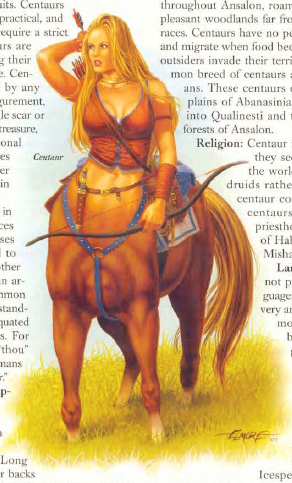
Centaurs live in Ansalon’s plains, savoring life’s simple pleasures in hedonistic bliss. They are organized into nomadic herds and speak an archaic version of common (“thou” and “thy” instead of “you” and “your”). They traditionally lived in Abanasinia but migrated south into Qualinesti and then throughout the forests of Ansalon. They are very vain, and decorate their bodies with jewelry, flowers, and other aesthetically pleasing baubles.
Centaurs have a lot of powerful traits and racial hit die, effectively making them higher level characters even before they take their first class. Monster PCs in 3rd Edition use a Level Adjustment system, where abilities grant effective “shadow” levels on top of existing ones in addition to Hit Dice monsters of their race have. Centaurs are considered 6th level before they gain any class levels. Centaurs are fast and have some good ability modifiers (+8 Strength, +4 Dexterity, +4 Constitution, -2 Intelligence, +2 Wisdom), but that’s all they really have going for them. In practice the Level Adjusment system makes centaurs and other monsters underpowered. Their quadrupedal form and large size makes it awkward for them to maneuver in a lot of places, and they don’t gain any unique class features or spellcasting ability (and what caster levels they do gain will be outclassed by the normal races).
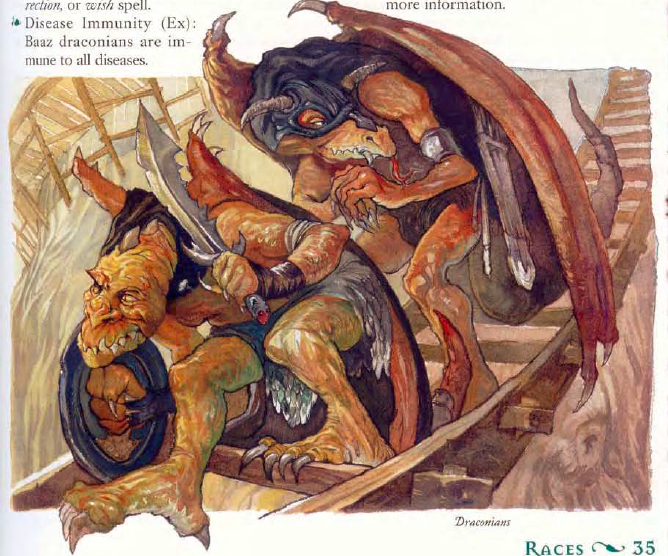
Another of the “monstrous” races, Draconians are a Dragonlance staple. In the Age of Despair the Dragon Empire used an unholy ritual on the eggs of metallic dragons to turn the hatchlings into humanoid dragon-people. They deliberately kept the female eggs unhatched to control the population, who served in the Empire’s military forces. A Draconian general by the name of Kang managed to retrieve the female eggs and defected, forming the nation of Teyr. Due to their history of conquest and subjugation, they are disliked by many of the races of Krynn, and even the Empire’s later incarnations (Knights of Takhisis, Knights of Neraka) still view them as servants which need to be controlled.
There are five breeds of “normal” draconians, but only two of them are deemed suitable for PC use: the Baaz (created from brass dragon eggs), and the Kapak (created from copper dragon eggs). Baaz are brutish and have a penchant for drinking and revelry, partying as hard as they fight. Given their military background their communities tend to adopt such trappings (including military slang and jargon), and their names derive from the Nerakan language as opposed to Draconic. Kapaks were bred as scouts and assassins, and they shared a fierce rivalry with the Baaz as both groups tried to prove themselves to higher-ranking human officers (although in battling together against a hostile world has made these tensions almost forgotten in recent years). Kapaks have glands in their mouths which exude poison (for the men) or saliva which can heal wounds (the women).
Draconians also suffer “death throes” when they die, deliberately designed to inconvenience enemy troops. Baaz’s bodies solidfy, trapping any sharp weapons inside, while Kapaks burst into a pool of acid.
Mechanics-wise both draconian breeds are of the Dragon type, death throes, have bite and claw natural attacks, immunity to disease of all kinds, vestigial wings which grant them limited flight, run as a bonus feat, spell resistance, and the ability to survive on 1/10th the normal food and drink thanks to their low metabolisms. They both have 2 racial hit dice and +1 and +2 Level Adjustment for Baaz and Kapaks respectively. Overall they’re quite a solid choice, monster-wise, as they both have a lot of useful abilities and their Dragon type grants them several immunities. As long as you stick to their strengths (don’t be a spellcaster!) they should keep up with their fellow humanoid PCs.
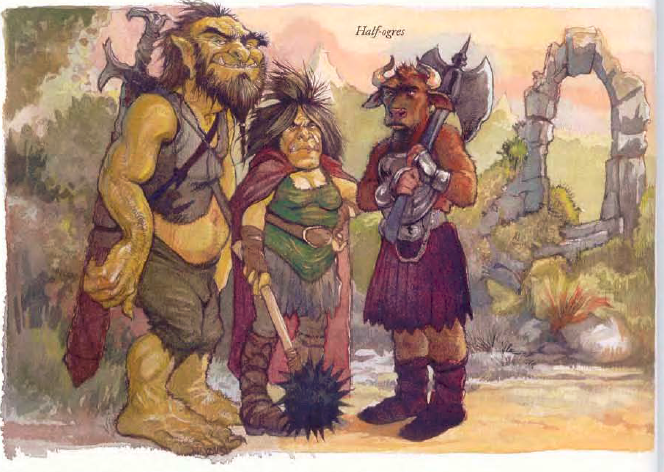
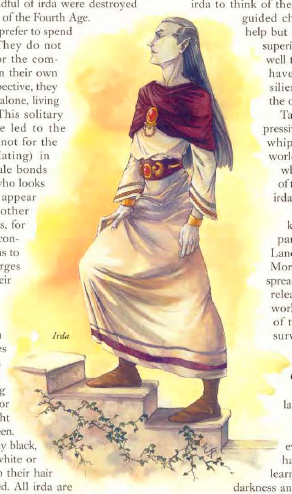
Ogres and ogrekin are one of the three elder races, this one favored by the Gods of Darkness. The ogres in the Age of Dreams built the first civilization and empire as they enslaved the humans through superior might. Back then they were physically and mentally gifted, yet lacking in mercy and compassion. Some Ogres learned of compassion and were exiled before the empire’s fall, becoming the Irda (or High Ogres), while ogres warped by the Graygem of Gargath became minotaurs. Eventually the ogres of the empire were cursed for their wicked ways, transformed into the huge, ugly, and brutish creatures of today.
The Irda escaped this curse, dedicated to Good and living in a remote island off the coast of Ansalon. Irda prefer to spend their time in solitude, disguising themselves as other races when forced to interact with them. All Irda still feel the pangs of evil due to their ogre blood, and thus adopted strict regimens of self-control (and are also vegetarians to further reject ogre cultural norms). They are blue-skinned and extraordinarily graceful and beautiful in their undisguised forms. In recent years the Irda rediscovered the Graygem and accidentally broke it, releasing the evil primordial god Chaos into the world and thus beginning the Chaos War, an act that fills them with shame and regret.
Mechanics-wise Irda are Medium size, have +2 Intelligence and Charisma but -2 Constitution, low-light vision, can take the form of a humanoid creature Small to Large size 3 times a day (duration is indefinite), and can cast several minor level 0 spells as spell-like abilities once per day each (detect magic, flare, ghost sound, dancing lights, light, and mage hand). They have a +2 Level Adjustment, which to me is too high (I don’t think that they deserve a Level Adjustment at all, personally).
Traditional, or “Fallen,” Ogres are a cruel and evil race who believe that might makes right. They tend to be warlike scavengers and raiders who prey on each other and the other races of Krynn, who they feel wronged by historically in different ways (they fought dwarves over territory, human slaves overthrew their empire, elves are the children of the Gods of Light and thus the enemy, etc). Most of them live in the nations of Kern and Blode, living among the ruins of their once-proud empire and doing their best to emulate what little they remember of its ways.
Ogres are effectively Level 6 before adding class levels. They are pretty much geared towards melee roles, having a massive Strength and Constitution bonus (+10 and +4) but penalties to almost all other ability scores (-2 Dexterity, -4 Intelligence and Charisma). They are Large Size and have increased melee reach in combat but nothing in the way of racial bonuses to skills, saves, or anything else in the way of special traits. Overall they’re kind of a boring option.
Half-ogres have ogre and human blood, often rejected by both societies. The ogres for being “soft and weak,” the humans who suspect them of being inherently violent and evil. Half-ogres tend to have mixed attitudes towards both races, alternatively rejecting and accepting one or both societies. Most other races aren’t fond of them, except for kender who keep an open mind. They are naturally inclined towards the adventuring life, welcome in few places.
Mechanics-wise they are Medium size (but very tall around 7 feet), have +4 Strength and +2 Constitution but -2 Intelligence and Charisma. They have a +1 natural armor bonus and low-light vision, but nothing else. They have +1 Level Adjustment, which is too high when you compare them to the minotaurs who don’t even have one. As a race Half-ogres feel bland, nothing much beyond “outcasts.”
Minotaurs are a seafaring race and are most prominent in eastern Ansalon. Their society is militaristic, holding the ideals of honor, bravery, and physical and mental strength as highest virtues. They are strongly lawfully-aligned with a tendency towards evil due to their worship of Sargonnas (god of vengeance). Their empire is a chain of islands across the Blood Sea, with the two largest being Mithas and Kothas which contain the majority of their population. Minotaurs make natural adventurers as the pursuit of glory through danger and violence lines up with their societal ideals. Many minotaurs sold their services as mercenaries in many of Ansalon’s wars, and their expansive expeditions of the seas of eastern Ansalon make them a well-traveled people.
They also have an annual Great Circus in the capital, where minotaur contestants have their skills tested in martial gladiatorial combat, chariot racing, and other risky physical activities to the delight of crowds.
Minotaurs are Medium size with +4 Strength but -2 Dexterity, Intelligence, and Charisma. They have exceptionally thick hides (+2 Armor Class) and horns as natural weapons which do more damage in a charge. They can gain the Scent quality by taking it as a feat, allowing them to detect nearby hidden opponents, and +2 on Intimidate, Swim, and Use Rope checks. And no Level Adjustment, and overall a solid race, one which was popular among my players who liked to play bruisers. They gain a lot more stuff than the poor half-ogres.
And that’s it for races!
Thoughts so far: I have mixed feelings about this chapter. On the one hand Dragonlance does a great job of balancing the line between cliché stock fantasy tropes and applying a new spin on them. The variety of subraces for the main groups, such as the dwarven clans, is well-done. The presence of monstrous races as character options, plus their usability in certain realms on Ansalon, is a neat addition as well.
On the other hand, the races are not balanced against each other. Some races are clearly better choices than others, while some have stats which box them into a specific and narrow class role. The Gully Dwarf can’t really do anything good which isn’t highly situational, and the “monstrous” races overall have too high Level Adjustments.
Next time, Chapter Two: Classes & Feats!
Classes & Feats
Original SA post
Dragonlance Campaign Setting Chapter Two, Part One: Classes & Feats
This chapter overviews the existing Player’s Handbook classes and how they fit (or don’t fit) in Dragonlance, as well as some new core classes, prestige classes, and feats.
Barbarians are not much different; they number among nomadic humans, Kagonesti elves, and ogres. They are warriors skilled in wilderness survival and tend to revere the three nature deities or practice various forms of animism and ancestor worship (although most aren’t devoutly religious).
Bards are the historians and folklorists of Krynn, keeping the memory of legends alive by incorporating their deeds into song and poetry. They are common among any race who practices musical and oral traditions, and their magic is ambient magic like that of sorcerers. As such, they can only cast spells in the Fifth Age onwards, and cannot cast healing spells at all because those are they exclusive province of the Gods.
Clerics are the worshipers of the 21 Gods of Light, Balance, and Darkness. No true Cleric serves an abstract cause, philosophy, or false deity. Clerics who don’t worship a deity cannot cast spells or turn undead. The gods of Krynn created the world and are the original source of all magical power. Additionally, every holy symbol is a Medallion of Faith, an outward sign of their devotion. Without the medallion the Cleric cannot cast or prepare spells higher than 3rd level. Additionally, they can be used to create other Medallions for new Clerics, even those of another deity (although good clerics can’t create medallions for evil deities and vice versa). Secondly, any attempts to forcibly remove a medallion from a Cleric’s neck deals 2d4 points of divine damage to the aggressor.
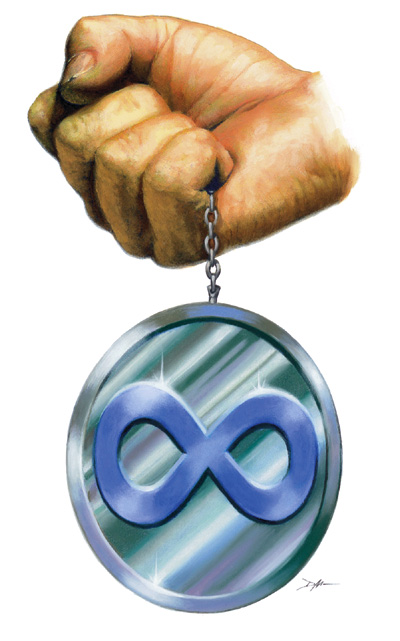
Druids are specialized priests of nature, worshiping either Habbakuk (neutral good deity of the circle of life), Chislev (neutral deity of nature itself), or Zeboim (chaotic evil deity of wrath and the sea), although the sourcebook Holy Order of the Stars reveals that druids can also worship Morgion (neutral evil deity of disease, decay, and pestilence). Druids do not need a Medallion of Faith, and they are most common among nomadic humans, centaurs, and Kagonesti elves.
Fighters are not much different than in other settings except that it mentions that most members of the 3 major Knighthoods have levels in this class (Paladins don’t really exist on Krynn.)
Monks are rare and isolated, sticking to self-sufficient communities in their pursuit of enlightenment. Most monks on Krynn are Lawful Good or Lawful Neutral and worship Majere (god of wisdom), part of a sect called Claren Elian. Monks are most common among humans, half-elves, and minotaurs.
Paladins are normally unavailable, as the Knights of Solamnia already fill their role aesthetically in the setting. However, the text mentions that the DM might allow them for distinguished champions of one of the Gods of Light (such as Kiri-Jolith). If they’re allowed they need to worship a deity to gain spells.
Rangers are those people who explore the wild reaches of Ansalon. They must worship one of the deities of nature to gain spells. New thing, they can choose organizations instead of monsters for their favored enemies. Of course, the examples provided are very prominent and iconic examples, such as the Knights of Neraka or the Order of the White Robes.
Rogues are thieves, swindlers, highwaymen, and others who make their way through life via underhanded means. Most of the new stuff talks about “Handlers,” Kender rogues, and how they differ from traditional thieves (basically nothing, except that they take stuff regardless of monetary value and forget to return it).
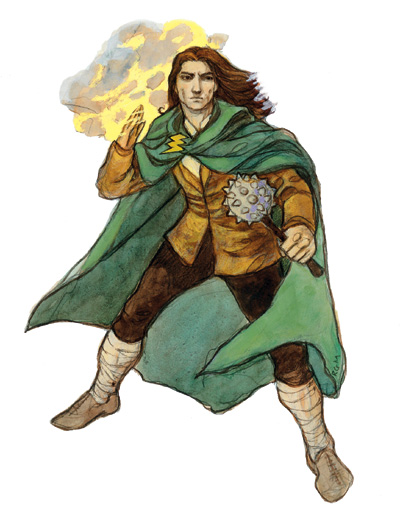
Sorcerers , also known as Primal Sorcerers, are arcane asters who can cast their spells without relying upon the Moons of Magic. Basically the world of Krynn was created with ambient magic, and a sorcerer extends their awareness into their surroundings to tap into this energy. Their art is called “Primal Sorcery” in comparison to the more focused “High Sorcery” of the Wizards. Primal Sorcery is the oldest form of arcane magic, but its influence waned among the mortal races when the three Gods of Magic helped create the Orders of High Sorcery. When the Graygem was cracked and summoned Chaos into the world, the levels of primal magic increased so that mortals could once again tap into it. Sorcerers do not derive their powers from bloodlines, in comparison to traditional D&D.
Wizards are arcane casters who draw their spells from one of the three Moons of Magic. One does not need to belong to the Orders of High Sorcery in order to be a Wizard. In fact, many hedge magicians ply minor spells without coming into contact with them, although wizards of sufficient power (can cast 3rd level or higher spells) are required by the Order to take the Test of High Sorcery and declare allegiance to one of the three factions (White, Red, or Black Robes) or risk being branded a renegade and hunted down. The Knights of Neraka boast a high number of renegade Wizards among their number in the Knights of the Thorn, and they derive their spells from all three Moons; such wizards are called the “Gray Robes” by some. Wizardry is a respected art among the elves and Irda, and Theiwar dark dwarves contain many among their number.
In regards to NPC Classes, Commoners, Experts, and Warriors are available and otherwise the same. Adepts do not exist, for magic is a rare and wonderful gift in Dragonlance, while the Aristocrat class has a PC variant known as the Noble.
On that note, we have two new core classes: the Mystic and the Noble.
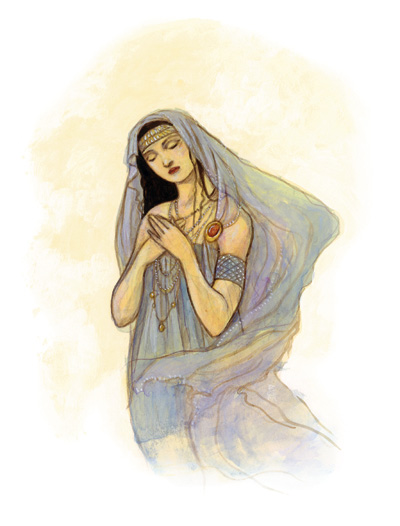
The Mystic is basically a divine sorcerer, capable of drawing upon divine magic without worshiping a deity. Mysticism was also re-introduced into the world with the release of Chaos. A mystic awakens to their magic via a process of introspection and self-discovery. They are a very diverse group, from necromancers to divinatory seers. A mystic can still worship a deity, but their spells are independent of said deity’s approval.
Mechanics-wise, mystics are much like clerics except that they’re not proficient with heavy armor and can’t turn undead, and they learn and cast spells much in a manner of a sorcerer. Instead of praying every day and choosing spells to prepare, they gain spells spontaneously upon leveling up, which they cast multiple times per day with spell slots exactly like a sorcerer. The Mystic can choose one cleric domain, gaining all its benefits and learning the spells as spells known. Mystics with the Sun domain can turn undead.
Overall this is a good, solid class in both flavor and mechanics. They can cast spells more often than Clerics, but they’re less versatile overall in that they’re more or less stuck with their spells known.
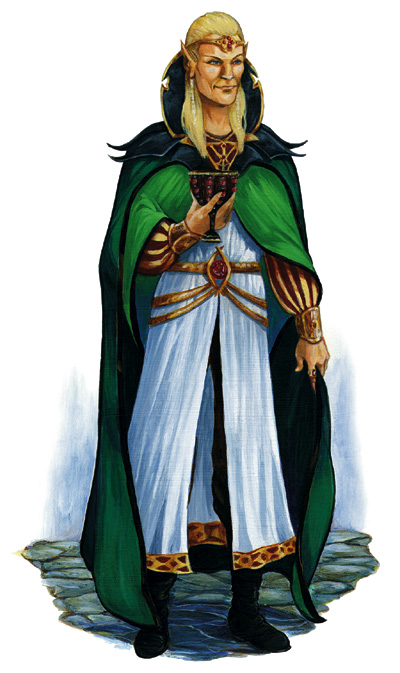
Nobles are the members of society’s upper class, be they ancestral lineages of regents and kings or even wealthy chieftains. Societies with fluid and extremely egalitarian social structures do not have people of the noble class, as one must be born into nobility in order to take the class (1st level). I feel that this is limiting. The noble is sort of a generic “leader with influence” class, and can accommodate a lot of things.
In terms of game mechanics, nobles are a poor man’s Bard. There’s nothing they can’t do a Bard can’t do better and with spells. They have average BAB, good Reflex and Will Saves, a robust skill list incorporating all the “social” and knowledge ones, and good proficiencies (simple and martial weapons, light armor, shields).
Their class features are lackluster: Bonus Class Skill grants one cross-class skill to the list, while Favor is an open-ended d20 roll against a DC to call in a service (DC 10 for simple stuff, DC 25 for dangerous and illegal favors), and favors which can circumvent adventure plots always fail. A noble gains a static bonus to the roll every few levels. Inspire Confidence is a limited per-day ability which grants bonuses to rolls for allies (bards can do this) for 5 rounds, while Inspire Greatness is largely the same as the bard’s except it grants bonuses to all saving throws and also lasts 5 rounds and is gotten 2 levels later. Coordinate grants additional bonuses for aid another checks every couple levels (+7 at 20th level), and that’s it.
The Noble is an unnecessary and underpowered class whose intended role can be done better by Bards and Paladins. If you want a noble PC, make it a backstory thing while being a Bard or Fighter or whatnot.
Prestige Classes
This section divides Prestige Classes into two groups: the first covers classes which are representative of Dragonlance’s most prominent organizations, while the second covers more generic archetypes. We’ll cover the organization PrCs first.
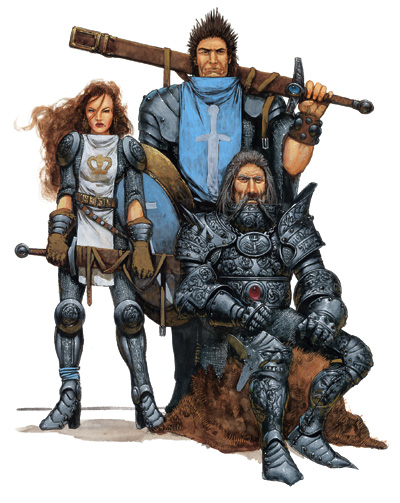
The Knights of Solamnia are an old and respected order responsible for many of Krynn’s greatest heroes, and serve as the ruling class of the nation of Solamnia. They are bound by the oath “Est Sularus Oth Mithas,” or “My Honor is My Life,” and seek to defend the weak and fight against Evil. During the Age of Despair the nation of Solamnia went through societal upheaval as peasants blamed them for the Cataclysm and overthrew many of their holds. Many Knights during this time abandoned their principles, either giving up their codes or following the letter of the law at the expense of its spirit, but they regained their honor after fighting valiantly against the forces of Takhisis in the War of the Lance. They are Lawful Good and revere the Gods of Light, especially Paladine and Kiri-Jolith. They are split into three major groups, and thus 3 Prestige Classes: the Knights of the Crown, Sword, and Rose.
The Knights of Solamnia are a hierarchal organization, meaning that in order to join the Sword you must have been accepted into the Crown, while for the Rose you must already be a Sword. This applies to the Prestige Classes as well, meaning that if you want to be a Sword of Rose you pretty much have to plan everything about your character from level 1. For example, Knight of the Rose can be taken no less than 10th character level, as you need 3 levels in Sword, 1 level in Crown, have Base Attack Bonus +8, cast 2nd level divine spells, among other things. As Cleric and Sword don’t grant full BAB progression, you need to make up those other 6 BAB points with 6 class levels. And that’s not counting the role-playing requirements and tests of moral character!
Knights of the Crown are the first tier and embody the virtues of honor and obedience. The class focuses around tough, heavily-armored fighters, with abilities which grant bonuses on initiative rolls, resistance and immunity to fear effects, heroic resolve which temporarily boosts physical ability scores, and treating heavy armor as medium armor for enhanced mobility. Their 10th level capstone ability grants them a heroic valor (combat buff spell) once per day and bonuses on all saving throws. They’re the “tanks” of the Knights.
Knights of the Sword are the warriors who fight to defend truth and justice, composed of clerics, crusaders, and are the religious arm of the knights. In order to enter must be able to cast divine spells and pass several tests (single combat against an evil worthy opponent, tests of wisdom, generosity, and courage, a journey of at least 500 miles, etc). As a class they can smite evil, turn undead, and gain enhanced caster levels as the god Kiri-Jolith grants them divine power. Their 10th level capstone ability grants them the ability to treat their weapons as holy and cast holy aura (protective spell from evil creatures’ attacks ) once per day. They’re sort of like a Paladin-lite class, but with full casting progression.
Knights of the Rose are the highest tier and leaders of the Knights, embodying the principles of wisdom and justice. They gain leadership-related abilities and bonuses to allies in tasks, along with full casting progression and some divination spell-like abilities reflecting their judgment and adherence to the Oath and Measure. Their capstone ability makes them a living embodiment of all the Knighthood stands for, and gains complete immunity to harmful compulsion spells and can cast foresight (preternatural awareness against all threats) once per day. Overall a good class, although the excessive multi-classing to get it can be a real chore.
Overall the Knight prestige classes were too clunky to be used by my own group, who instead opted for playing Paladins while retaining the same flavor. A later sourcebook Knightly Orders of Ansalon split them up into independent classes and revising them to be friendlier entries to classes other than Fighter and Cleric, and dispensed with the Tests for entry, instead being a role-playing thing determined by individual groups and DMs.
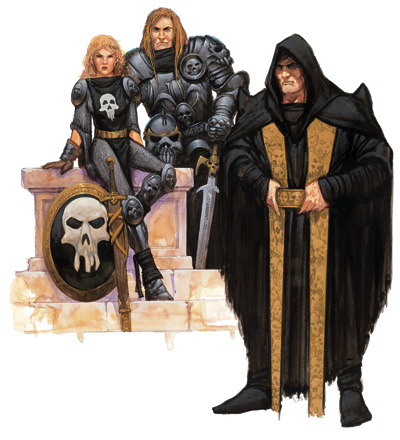
The Knights of Neraka, formerly the Knights of Takhisis, were formed by Ariakan, son of Emperor Ariakas of the now-fallen Dragon Empire. After being held and then released as a prisoner of war by the Solamnic, he learned much of their traditions and structure and decided to replicate it, albeit this time dedicated to Takhisis/Tiamat. The Knights of Takhisis were devoted to bringing all of Ansalon (and eventually the world) under their goddess’ heel, but after her death they became a more secular organization when mystics after many of their leaders mastered said magic during the War of Souls. The Knights are guided by 3 principles: the Vision, their ultimate goal of continental domination of Ansalon; the Blood Oath, the swearing of one's submission and life to the Knighthood (and formerly Takhisis when she lived); and the Code, a complex set of laws and rules for how the Knights should conduct themselves in relation to others.
Now known as the Knights of Neraka, they are split into 3 orders: the Knights of the Lily, the backbone of the order and their warriors; the Knights of the Skull, mystics specialized in intelligence-gathering and security purposes; and the Knights of the Thorn, sorcerers and renegade Wizards specializing in divination and cosmic awareness. Unlike the Knights of Solamnia one can take the Prestige Classes independently. For example, a Knight of the Thorn needs no levels in Skull or Lily. All Knights must be Lawful Evil, and gnomes, kender, and draconians are barred from entry (draconians are viewed as lowly servants).
The Knight of the Lily are a warrior PrC which grants Sneak Attack damage, resistance and immunity to fear effects, bonus against mind-affecting spells, armored mobility like a Knight of the Crown, and their 10th level capstone ability makes them immune to becoming flat-footed or surprise unless they and every other Knight of the Lilly within 100 feet is. Overall it’s not a very powerful class, as its abilities are too back-loaded and small to matter at higher levels, and the sneak attack progresses too slowly to add much damage.
The Knight of the Skull is a divine caster, gaining full progression except at 1st level, can smite good-aligned enemies, discern lies and rebuke undead (all of which are front-loaded in the first 3 levels), and at 10th level treats all weapons they wield as unholy. The class has the least amount of unique features of the Knights, but since they only sacrifice one caster level than they would as a Mystic they’re not losing anything.
The Knight of the Thorn are known as “gray robes” for their ash-colored garments. They are the pre-eminent organization of arcane spellcasters in Ansalon outside the Orders of High Sorcery, and as such are enemies of all three Orders. They are seers who use magic to learn how every person and even fits into their order’s designs.
Entry as a pure sorcerer/wizard is impossible, as a Thorn Knight needs a good base Fortitude Save (+4) and proficiency in all martial weapons and heavy armor. However, they more than make up for it with full casting progression, lower arcane spell failure while wearing armor (maximum of -20% at 8th level), automatically learning the augury (yes/no divination spell), divination, and commune spells at certain levels along with the ability to cast one more divination spell per day, one additional divination spell known or learned into their spellbook at each level, the ability to channel touch spells through their weapons, and at 10th level once per day can add their caster level as a bonus to a single d20 roll. Overall they gain a lot of good abilities, and their flavor is cool, too!
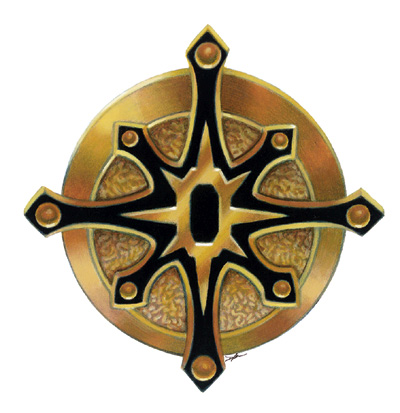
The Legion of Steel is the third major knightly order. They are the youngest of the three, formed after the Chaos War by Steel Brightblade and former Solamnic and Nerakan Knights disillusioned with their old orders. The Legion of Steel is more populist and working-class, allowing anybody to join regardless of race or social status, and they are organized into semi-independent cells across Ansalon instead of a formal hierarchy. Instead of a written code they follow an orally-spoken ideal known as Sara’s Legacy, which teaches to stand against injustice, gain strength through knowledge, to have the courage to do what is right, and help their communities.
As a prestige class they are very easy to qualify for: you must not be of evil alignment and easy to hit base attack and saving throw requirements, along with some ranks in Bluff and Diplomacy. It’s a 3-level prestige class which grants you Legion Knowledge (like Bardic Knowledge), 2 Favored Enemies (enemies of the Legion which include evil dragons, the other Knighthoods, and some monstrous races), bonus on interaction rolls with working-class and poor people, and an apprentice at 3rd level is works exactly as a cohort like the Leadership feat. It is supplementary to any existing cohorts.
This would be a weak class were it not for the apprentice, which can effectively be a 2nd PC for the player to control.
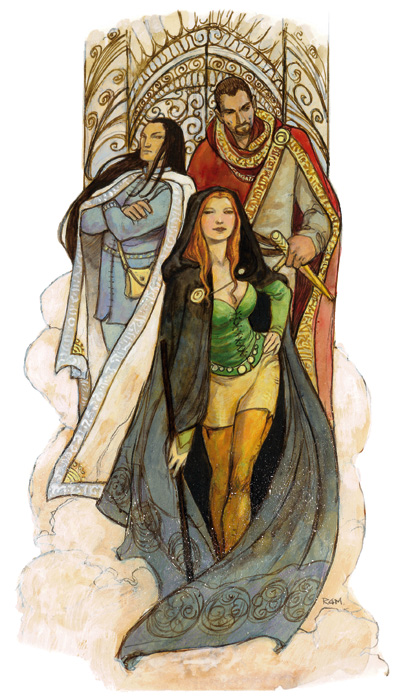
The Wizards of High Sorcery are one of the most venerable, powerful, and feared organizations in Ansalon. Back during the Age of Dreams the only mages were Scions, primal sorcerers and mystics; during the Second Dragon War they fought on the side of the elves and unleashed devastating magic in the battle. This overwhelming power killed many of the dragons, but countless innocents died in the crossfire. The three deities Solinari, Lunitari, and Nuitari realized that such power needs guidance and order to prevent such a catastrophe from happening again, and they assumed new mantles as the Gods of Magic and taught the Scions to channel their magic through the Moons. These Scions learned the arts of wizardry and formed the Order of High Sorcery, creating five Towers to help in the teaching and accumulation of magical knowledge.
The three orders are thus: the White Robes, good-aligned devotees of Solinari who are dedicated to using their magic to eliminating suffering and promoting good works; the Red Robes, the most numerous of the orders and the neutral-aligned devotees of Lunitari who encourage a balance between Good and Evil; and the Black Robes, who believe that magic should be pursued without moral or ethical restraints and have a Social Darwinist “only the most powerful mages deserve the riches of the world.” Despite alignment differences, all Orders vow a primary allegiance to magic above everything else.
Once a Wizard attains a certain level of power and completes a Test, they automatically gain a level in the prestige class. The prerequisites are easy enough for a Wizard to meet: appropriate alignment for the Robe to wear, able to prepare and cast spells from a school their Robed Order favors (abjuration and divination for white, illusion and transmutation for red, enchantment and necromancy for black), and two metamagic or item creation feats.
Mechanics-wise Wizards gain a free magic item after completing the Test, enhanced specialization in their school (if they’re a specialist) with additional spells per day and Save DCs, a variable modifier to their caster level depending upon the phase of their aligned Moon, and access to the libraries and laboratories of the Towers (although only Wayreth still exists). Additionally a Wizard can learn Secrets from their appropriate Order at every 3rd level. Basically secrets are unique abilities which are added to spells and thematically related to their order. For example, a Red Robe’s Magic of Deception makes his spells harder to detect with divination, while a Black Robe’s Magic of Darkness converts half of the damage of a spell to negative energy. They’re overall pretty cool, and a few can grant free metamagic abilities without increasing caster level, so that’s good, but the Black Robe in particular has a super-powerful secret: Magic of Hunger. This allows the Wizard the ability to prepare an additional spell per day by suffering Constitution damage equal to the spell level, and the damage has to be recovered naturally. As a Wizard’s power comes from their spells and how much they can cast them, a Black Robe PC playing his cards right effectively gains free spells.
A Wizard can also switch Robes and alignment, and must assign their specialized and prohibited schools anew. Additionally they can no longer learn Secrets of their abandoned order, and suffer a massive -20% penalty on experience points earned until the next level.
As of Age of Mortals Sourcebook onwards, a Wizard of High Sorcery no longer needs to specialize in a school to attain this prestige class. They do not gain enhanced school specialization, though.
Overall this is a very powerful prestige class, as it supplements the abilities of one of the most powerful core classes in 3rd Edition. Power-wise there is no reason you wouldn’t take this class and remain a plain ol’ single-classed Wizard, especially now that you don’t need to be a Specialist now with errata. Role-playing wise you might not be fond of being part of a centralized hierarchy overseeing you.
Thoughts so far: I like the prestige classes in terms of flavor, but when it comes to game mechanics the spellcasters get all the good stuff. Story of 3rd Edition.
Next time the rest of Chapter Two: Other Prestige Classes and Feats!
More Classes & Feats
Original SA post
Dragonlance Campaign Setting Chapter Two, Part Two: Classes & Feats
In this section, we’ll be covering the last four non-organization Prestige Classes and the new feats for the campaign setting.
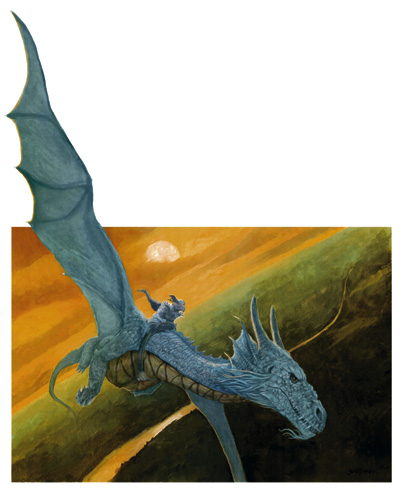
The Dragon Rider is our first one. In ages long past dragons battled alongside humanoid warriors, bearing them as mounts and fighting in tandem. This tradition entered into recent history during the War of the Lance, on both sides with chromatic and metallic dragons alike.
The Prestige Class has some late level requirements: Base Attack bonus of +10, meaning you’ll have to be a single-classed warrior if you want all ten levels, must have ridden a dragon, and Leadership, Mounted Combat, and Resist Dragonfear feats. The BAB’s the only real steep entry, and like the Knights it sort of requires the player and DM to plan things out together with the “ride a dragon” prerequisite.
In terms of game mechanics this is an awesome class. First you get a dragon mount as a cohort, although there are restrictions: first they must be no older than an adult (such dragons are too arrogant to cooperate with humanoids as mounts), no younger than the young age category (still under the care of their parents and too immature), and not in opposition to the rider’s alignment. Said dragon must also be big enough to hold the rider (one size category larger), and must be treated as an equal as opposed to a dumb beast or minion. In exchange, a dragon gains bonus hit dice, strength, and natural armor as the rider gains levels in the class, and bonus feats. Also, a rider and mount over time can act on the same initiative (this is great!), gain telepathic communication with each other in line, and become immune to flanking attacks when riding as both cover their blind spots. Also, the more powerful dragon types as mounts are available at later levels; at 11th level the only choices are wyvern, and young white, brass, and black dragons, with juvenile and young adult dragons around 18th and 19th level.
I had a PC in one of my games take this, and for a time it seems as though he was on par with the spellcasters. The ability to engage in flight covers a lot of melee fighter’s shortcomings, plus the Tremendous Charge feat (new one I’ll cover later) with a lance really sends one’s damage soaring. There’s also the fact that dragons have minor spellcasting capability, so this is a really great martial PrC all-around.
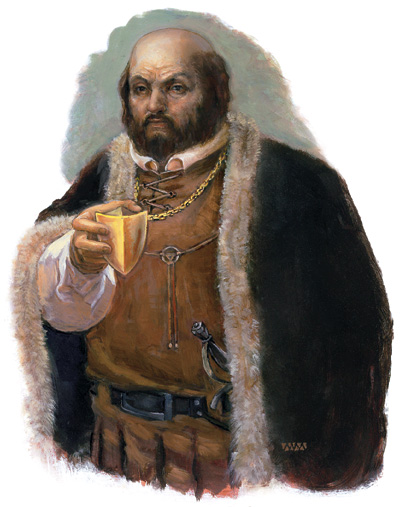
The Inquisitor is an all-around spy, investigator, and those who are experts at unearthing other people’s secrets. They’re really easy to enter, requiring ranks in 3 investigation-related skills (Sense Motive, Knowledge-Local, and Gather Information), a +3 BAB and a non-chaotic alignment. He’s like a Rogue but without offensive capabilities: the class grants trap sense and uncanny dodge progression, and their first ability is Extreme Focus which allows them to add their ranks in Concentration to a single Intelligence or Wisdom skill check once per day per Inquisitor level (a good one level dip), and he can apply a synergy bonus to a skill of his choice from a Knowledge skill they’re trained in. Their capstone 10th level ability grants a Sherlock Holmes-style Intuitive Logic, which replicates the Divination spell with an 80% chance of success. Honestly this class isn’t worth it aside from Extreme Focus.
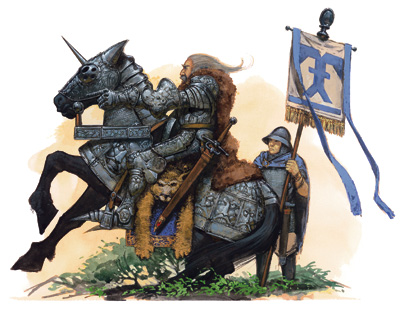
The Legendary Tactician is a leader of soldiers par excellence. The class’ iconic example is Laurana the Golden General, a PC from the original adventure path and book series, a Qualinesti elven princess who lead the Knights of Solamnia and other forces of Good against Takhisis’ army in the War of the Lance. The class has really easy pre-requisites: 4 ranks in Diplomacy, +5 Base Attack Bonus, the Leadership feat, and must have been involved in at least major skirmishes (at least ten people on each side), one of which must count as a defeat (why is failure necessary to become legendary?), and a group of at least five soldiers loyal to you. Trivial to earn with Leadership.
In terms of class features the Legendary Tactician grants buffs to his allies, such as inspire courage, rolling twice against fear-based effects, bonuses to Constitution checks on forced marches, and when retreating a morale bonus to Armor Class against attacks of opportunity. Only allies within a certain radius can be affected, usually either 30 feet per class level or just 30 feet for the higher-level abilities. It makes for a cool concept, but the bonuses are too small (usually +1) to matter unless they’re being stacked with a bunch of other bonuses.
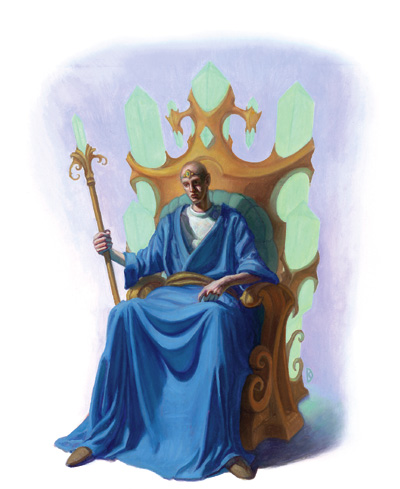
The Righteous Zealot is a fanatic to a certain cause, viewing themselves as saviors and hoping to recruit others to the fold and force their will upon the world. The iconic example is the last Kingpriest of Istar, pictured above, a man so consumed with wiping off Evil from the face of Krynn that he only brought about more suffering and misery and the destruction of his empire. The only pre-requisites are ranks in several social skills, with Concentration and Diplomacy being the only ones above 3 ranks (8 required, to be specific).
The class is meant for bards and clerics, but it doesn’t grant any spellcasting progression, limiting its usefulness severely. A Righteous Zealot’s signature ability is Oration, which is sort of like Bardic Music in that it’s a limited-use mind-affecting ability except that it’s based on Diplomacy instead of Perform. New oration abilities can be gained with levels, and include enthralling crowds to listen to you, bestowing the effects of a confusion spell through verbal obfuscation, instilling suggestions in the minds of enthralled people, and other enchantment-based spell effects (although this last one comes in really late, at 10th level). Other class features include bonuses to Leadership, against mind-affecting magic, add their Charisma modifier to a single saving throw, and reroll a single failed roll once per day at 10th level. This class is underpowered as the Orations can only be used once per day per level total, and when they come into play they can be replicated by lower-level spellcasters via spells. If you added a full casting progression then you might have something.
And that’s it for Prestige Classes. Flavor-wise my favorites are the Dragon Rider and the Knights of Solamnia, but when it comes to ones which I’d have the most fun playing they’d be Dragon Rider and Knight of the Thorn.
Feats
We don’t have many feats here, 13 to be exact, but the ones we do have a doozy, either ranging from “underpowered and highly situational” to “holy crap pick this one, PICK IT!”
The more ho-hum ones include Cornered Rat (for Gully Dwarves, gain +2 on an attack roll when someone Intimidates you), Honor-Bound (+2 on saves to avoid being forced to break an oath/promise/duty), and Resist Dragonfear (normal and Improved grant a stacking +4 bonus each on saves against a dragon’s Frightful Presence), and Spectacular Death Throes (for draconians, your death throes are more dangerous than normal, bad because it will never come into play until you die).
The rest of the feats are nifty and cool.
Draconian Breath Weapon (and Improved), which grants you a 3d8/6d8 damaging line or cone attack of your draconic ancestor’s energy type.
Hulking Brute can be taken by Half-Ogres and Minotaurs, and you’re treated as Large when it’s advantageous for opposed rolls.
Flyby Breath and Strafing Breath are for dragons, allowing them to use their breath weapon as a free action if they do nothing but move on their turn for the former, and the latter extending the area with increased mobility (covering their area up to half their fly speed in the latter one).
Spear of Doom is a Fighter bonus feat which allows you to deal charge damage with a spearlike weapon if you ready against a charging opponent, while Tremendous Charge allows you to substitute your mount’s Strength bonus for damage instead of your own when making a mounted charge. Both have easy to meet pre-requisites, potentially at 1st-level! This last one is great when combined with a true dragon mount.
And our final feat, lest we forget, is a treat for spellcasters. Reserves of Strength allows a spellcaster to increase their Caster Level on a spell by 1-3 in exchange for being stunned for a like number of rounds as they draw upon their own force of will. These increased caster levels can extend beyond normal maximums, meaning that a 9th-level Wizard casting a Fireball spell can deal up to 12d6 damage. Naturally this has led to all sorts of min-maxing shenanigans. And if you’re somehow immune to being stunned you take damage instead.
Thoughts so far: I enjoy the feats overall, as most of them are quite effective choices. I can’t say the same thing for the last 4 Prestige Classes, however. Only the Dragon Rider is not underpowered, and it’s the most interesting choice thematically for a Dragonlance campaign.
Next time, Chapter Three: Magic!
Magic of Krynn
Original SA post
Dragonlance Campaign Setting Chapter Three: Magic of Krynn
This chapter covers the different kinds of magic of Dragonlance. While there are some game mechanics in the forms of new spells, domains, and magic items, a significant amount is dedicated to the histories, origins, organizations, and practitioners of the various arts in the setting. I find it to be a nice touch for a D20 product, as a lot of settings either put the mechanics and setting in separate areas or just try to sell you the mechanics ("6 new races, and new cleric domains!") without giving the context of how it fits into the overall world. Despite its age I believe that more books should follow in its footsteps.
Arcane Magic
The purview of wizards and primal sorcerers, this form of magic involves the direct manipulation of creation. It has great destructive potential, so much so that the deities created the Curse of the Magi to limit its strength in the hands of mortals. Basically this is explicitly the "fire and forget" method of Vancian casting. Instead of permanently learning a spell and casting if forevermore, a spell leaves the wizard's mind upon casting, requiring hours of rest and restudying to learn it again. Sorcerers can sort of get around this limitation in that they intuitively "know" their spells, but even then it's physically taxing and they too must rest when they run out of spells per day.
High Sorcery
The art of wizardry, high sorcery is arcane magic channeled through the three moons of magic. The Orders of High Sorcery was created by the deities Solinari, Lunitari, and Nuitari, bound by three rules: "1: All wizards are brothers and sisters in their order. All orders are brothers and sisters in their power. 2: The places of High Sorcery are held in common among all orders and no sorcery is to be used in anger there against fellow wizards. 3: The world beyond the walls of the towers may bring brother against sister and order against order, but such is the way of the universe." These rules were implemented to discourage infighting among the orders, and to have the Towers as a "safe space" of sorts. The Towers were forged long ago in places believed to contain the greatest concentration of magical energy. As the wizards built their towers they attracted nearby communities, and from there grew some of the oldest and greatest cities of Ansalon: Daltigoth, Palanthas, and Istar. Each tower had a magically enchanted grove around it as a first line of defense, and each tower's master was taught a special secret spell which would allow a target to pass through unheeded. For example, the grove of Istar caused short-term memory loss of its boundaries, the grove of Daltigoth caused intruders to fall into a deep slumber, etc.
Only the towers of Wayreth and Goodlund were built in places of relative isolation. During the last years of Istar the Kingpriest led a crusade against the Orders, resulting in the destruction of all but Wayreth. Raistlin, one of the Heroes of the Lance, temporarily reclaimed the Tower of Palanthas.
During the early Fifth Age, when Takhisis stole the world, wizards lost their powers as the moons no longer hung in the sky and the Order disbanded. Many wizards during this time either turned to primal sorcery, gave up the practice entirely, and in some cases were murdered by enemies taking advantage of this. The Order was reformed when the deities returned, but these losses made them much less centralized.
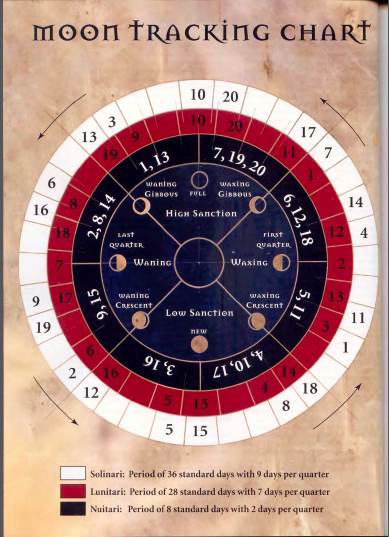
As wizards draw their magic from the Moons, ones with the Wizard of High Sorcery PrC have their magical power fluctuate with their patron moon. Basically the fuller the moon the better, and the less full the less powerful. During the waxing and waning periods around the quarter moon (half-full) they have normal caster level, but during High Sanction (waxing and waning gibbous and full) they cast at +1 Caster Level and +1 to Save DCs of their spells. Reverse for Low Sanction (waxing and waning crescent and new moon). However, the exception is when at least two moons' phases are in conjunction, and this stacks with existing bonues (penalties for low sanction moons don't apply in this case), so Solinari and Lunitari full moons grant +2 Caster Level and Save DC to White and Red Robes. The effects are even more powerful when three moons are aligned, which applies a +2 bonus instead during Low Sanction and +3 during High Sanction (this event is known as the Night of the Eye and occurs only once every 504 days).
As you can tell by the chart, Nuitari goes through its phases the fastest, Solinari the slowest. This can be a complicated book-keeping method, and our group never bothered with it. They do present an alternative for rolling a d20 to determine moon positions each time it matters, where the moon phase matches up with the number on the chart.
Primal Sorcery
Known as "wild magic," primal sorcery is the oldest form of magic on Krynn and is more difficult to harness. Instead of using the Moons of Magic as a conduit, the caster draws directly from the creative foundations of the world to power their spells.
Every dragon can use it, due to their close connection to the world. Non-dragons who rediscovered it after the Chaos War had to learn an entirely new form of magic with no lineage of learned practitioners, unlike wizardry. Palin Majere, cousin to Raistlin Majere, gathered a bunch of sorcerers to form an Academy of Sorcery in the town of Solace, but it was short-lived when the forces of the Dragon Overlord Beryllinthranox razed it to the ground. Before its destruction classes were less formal, more based upon peer review and "learning as you go" than teachers and study. Most sorcerers today remain isolated and in hiding, with the Knights of the Thorn remaining the only real centralized organization for them.
Sorcerers are seen as a threat by the gods of Magic and the orders of High Sorcery, who treat them as renegades if they don't join the Orders and obtain sufficient magic power. Although it hasn't happened yet, a primal sorcerer can take the Test and join one of the Orders (although only Wizards can gain levels in the Wizard of High Sorcery Prestige Class).
Divine Magic
Okay, so what makes Divine Magic different than wizardry? Well for one, a cleric draws their power from their faith in a deity and receive spells for their dedication. Wizards just use the Moons as a conduit, although official members of the Orders are required to pay respects to the deity aligned with their favored moon. Mysticism draws from a person's inner self, and from the surrounding life on Krynn.
An Abridged History of Krynn's religions
We get a brief overlay of Ansalon's religious history, from one extreme to the other. During the height of the Empire of Istar worship of Paladine and the Gods of Good were central, but after the Cataclysm belief in the true Gods waned in favor and eventually forgotten as the pantheon cut off ties from Krynn. The deities were absent except for Solinari, Lunitari, and Nuitari, leaving wizards the only people capable of casting spells; many disreputable mages used magic to mimic the "power of the gods," forming their own false religions and cults. Combined with the lingering memories of the Kingpriest's crusades, this caused many people to distrust and hate them (and the Orders were instrumental in breaking up such cults for this very reason).
Takhisis was the first deity to come back to Krynn, using the Foundation Stone in the destroyed Temple of Istar as a conduit and transporting the structure to the mainline shore. From there she attracted all manner of followers who were rewarded with loyalty and divine magic. Her followers set about conquering much of Ansalon in the newly-formed Dragon Empire; it wasn't until the Heroes of the Lance in the original adventures and Chronicles brought back knowledge of the Gods of Good and the secrets of the Dragonlances that her forces were repulsed and knowledge of the Gods of Good and Neutrality were brought back to Krynn.
Unfortunately this wasn't to last, as Takhisis managed to steal the world away after the Chaos War, making her the only deity in connection with Krynn. Even the moons of magic were gone, resulting in a world without any form of magic for decades (Takhisis was too weak after this to grant prayers). During this time mysticism (along with primal sorcery) was discovered, when Goldmoon (another Hero of the Lance) was able to call upon "miracles" again through the power of her inner self. Once Takhisis regained her power she picked a champion, a young girl named Mina, to spread word of the One God, supposedly a God who was always with Krynn and did not abandon them. Resentful of the deities leaving again and so soon, Mina's forces once again became prominent in Ansalon (albeit believing to worship a different, and new God), and helped kill off two Dragon Overlords.
Once the gods returned to Krynn Takhisis was punished with mortality and killed. Now that mortals no longer have to rely upon the Gods for magic, many people are considering forging their own path with sorcery and mysticism instead. Even those without the magical talent are resentful and distrustful of the Gods, feeling that they cannot be relied upon to be there during the worst of times. The pantheon of Krynn and its faithful need to work hard to regain the mortals' trust once again in this new age. Time will tell how the opposing forces react.
Holy Order of the Stars
The pantheon of the true gods (excepting the gods of magic), along with their cleric, druid, and ranger worshipers, are known as the Holy Order of the Stars (including the evil deities). The deities are grouped into three separate groups based upon moral alignment, and although they cooperate at times, each of them have their own overviews and portfolios. The Gods of Light seek the overall welfare of Krynn, while the Gods of Darkness seek to dominate and control Krynn and its people, while the Gods of Balance attempt to maintain equilibrium in the world, viewing the Gods of Light as idealistic and impractical while the Gods of Darkness are treacherous and untrustworthy. They tend to fight on the side of the underdogs when one group becomes too powerful (for example, they aligned against Takhisis' Dragon Empire during the War of the Lance).
People seeking to become clerics (or druids) must find within themselves a deep, abiding faith with one of the gods. They must then find a priest in good standing with that deity and prove their worth. The tests usually differ: for example, Mishakal might require one to look after the poor, sick, and old, while Sargonnas might require an applicant to take revenge against their hated enemy. If they are deemed worthy, a cleric creates a Medallion of Faith as proof of the new clerics' pact with the deity. They must live by the deity's tenets or risk falling out of favor. A first major violation is visited with a warning of 1d4 negative levels which can only be removed by making up for the transgression, while further violations cause them to lose their spells.
Mysticism
Mysticism is a form of divine magic which draws upon the life of Krynn itself, strengthened by an individual's heart and soul. Given that it relies upon faith in oneself, one cannot be a cleric and mystic at the same time. Being a cleric requires absolute faith in a deity, although mystics can worship a deity (they just can't gain spells from them). Unlike the relation between sorcerers and wizards, the one between clerics and mystics isn't as hostile, at least on the surface. Mysticism requires a strong sense of will to fully manifest, and as such it tends to be more easily accessible than primal sorcery.
The primary centers of learning for mysticism are the Citadel of Light on the Island of Schallsea, once headed by Goldmoon, and the Knights of the Skull. For the former, mystics are trained to see if any one domain is best suited for them, and once they find their one they must ascend the Silver Stair at the end of a hedge maze to confront their fears, which manifest along the journey. If they fail they can no longer advance further in rank (although I don't know if this means an actual leveling in magic power or just an advancement in the organization). The Silver Stair's a magical place believed in ancient times to have once ascended to the planar homes of the Gods:
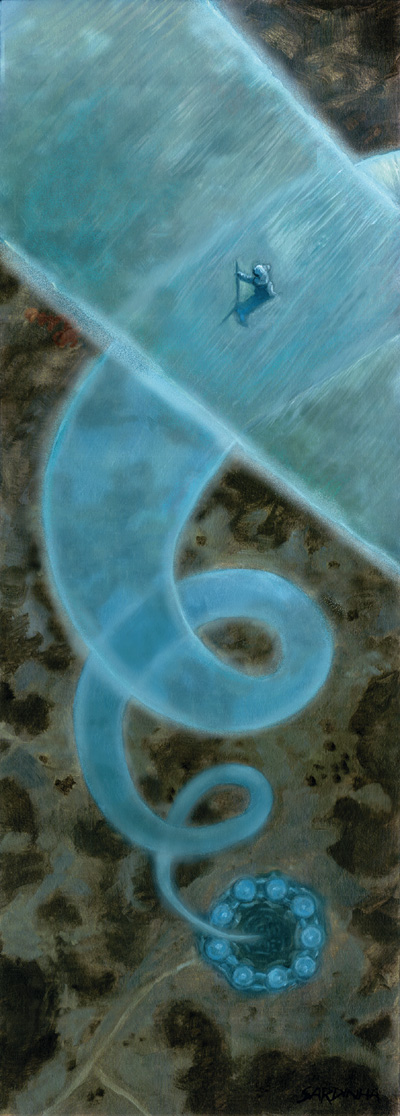
Other than that there's not much more on mysticism, although it has the least connection to the Gods: high sorcery and clerical spells are direct conduits, while the energies of primal sorcery were made from the magic used to create Krynn and enhanced by the essence of the god Chaos. But some argue that since life was created by the gods, mystics drawing upon life are therefore indirectly drawing upon their power.
The reasoning for their grouping in pairs (high and primal sorcery, clerical magic and mysticism) is that the effects are related. What can affect high sorcery effects primal sorcery as well, and many of their spells are virtually identical. The degrees of sameness are debated by magical scholars, but for the most part these principles overall hold true.
New Cleric Domains
Now we get to the crunch! In addition to a list of what existing cleric domains apply to which deities (magic isn't available, neither is Sun for non-mystics), we get some new ones! Mystics are have their own unique domains no present among the Gods, giving them a slight edge in variety to make up for their one less domain.
Alteration is a mystic domain which grants +1 Caster Level to transmutation spells, and grants such spells (enlarge person, gaseous form, polymorph, etc) in its domain.
Community focuses on the welfare of others, granting Calm Emotions and a bonus on Diplomacy checks and related spells (heroes' feast, telepathic bond) as domain spells.
Forge domain is all about creation, granting a bonus on craft checks and related spells (minor creation, wall of iron) as domain spells.
Insight grants uncanny dodge, and its domain spells include things like true strike, locate object, commune and the like.
Liberation grants a bonus on saves against fear-effecting spells and its domain spells involve the removal of negative conditions (freedom of movement, break enchantment, etc).
Meditation allows a caster to Empower a single spell once per day as per the metamagic feat but no increase in spell level, and its domain spells are self-improvementish (tongues, spell turning, mind blank, etc).
Mentalism is another mystic-only domain, focused on the powers of the MIND! You get a bonus on social skill checks, and mind-affecting domain spells (detect thoughts, greater command, dominate monster, etc).
Necromancy is mystic-only and grants them the ability to rebuke and command undead. It has death-related domain spells (animate dead, death knell, etc).
Passion allows one to act as if under a rage spell once per day, and its domain spells involve emotions (crushing despair, greater heroism, irresistable dance).
Pestilence makes you immune to all diseases, but you still act as a vector. Your domain spells involve summoning creatures of filth and inflicting debilitating conditions on your enemies (otyugh swarm, contagion, etc).
Restoration is sort of a Healing domain knock-off, even containing the same +1 caster level effect. Difference is that it's mystic-only and grants both Restoration spells and all the bring the dead back to life ones.
Storm is a cool domain, in that its spells are all weather-related (gust of wind, sleet storm, control weather), making for an effective battlefield controller build for a cleric. It's graned power of Electricity Resistance 5 is lackluster, though.
Sun domain is unaltered except that it just grants normal undead turning and is mystic-only.
Treachery domain's unique feature is that you effectively gain the sneak attack of a rogue once per day on a flat-footed melee attack. It's domain spells draw from multiple sources and are entrapment and deception based (glibness, magic jar, undetectable alignment as a 1st-level spell!).
Overall I most enjoyed the Storm and Forge domains, as they're very versatile and broad enough in focus that I can see them being used in other settings with little trouble. Necromancy and Restoration feel kind of superfluous, with the existence of Death and Healing already. Necromancy in particular feels that its only inclusion is to grant turning for the Mystic class and draws upon much of the same domain spells.
New Spells
There are 26 spells in total, drawn upon unique effects demonstrated by the heroes and villains of the book series. Most of them can be cast by anyone, but a rare few are only available to a limited number of spellcasters (such as Magius' Light of Truth, which is only taught to White Robe Wizards). For sheer volume I won't cover them all, instead focusing on some of the more interesting ones.
Bestow Greater Curse is a 6th-8th level spell variant of the normal kind, except its effects are permanent and greater in magnitude (reduce an ability score to 1, -8 penalty on rolls, etc). Additionally, the caster must specify a deed for the target to complete in order to remove its effects (must be something which the target can accomplish within one year). Overall a powerful debuff spell, but it requires touch range.
Deep Freeze is a 7th-level sorcerer/wizard spell which deals a small amount of subdual cold damage (6d6) per round, but unconscious opponents are frozen in a block of ice for one year per level and can only be freed by limited wish and greater magic. Bad damage, but a powerful save or suck spell to unleash at the right time.
Divine Retribution is a 9th-level cleric spell where the caster specifies an energy type. Any harmful effect of that type (breath weapon, spell, etc) dealt to her is converted to holy/unholy damage and reflected back upon the attacker. Its most famous use was when Mina, cleric of Takhisis, goaded Khellendros the blue Dragon Overlord into fighting her, using the spell to kill him with his own breath weapon. A good buff in the right place, but I feel that it's too high in level.
Earthen Shield is a 3rd level sorcerer/wizard spell which creates a small localized wall of earth from the ground 1 foot thick and 5 feet long in caster level, and can only be a maximum of 10 feet tall. It's really tough, with 100 hit points per foot of thickness and a Break DC of 15 + 5 per foot of thickness. Very useful battlefield control spell at an affordable level, as it lasts one minute per level.
Fistandantalus' Portal is an 8th-level sorcerer/wizard spell which opens a portal between two points in the same plane, 5 to 20 feet in diameter. It is subject to the limitations of the teleportation spell, in that the caster must have a good memory of the places in order to minimize mishaps. Considering that Greater Teleport accomplishes much of the same thing minus mishaps, it's rather underpowered for its level. The fact that it costs 500 experience points and 1,000 steel pieces in material components makes it a bad choice all around for spells.
Magius' Light of Truth is a 9th level sorcerer/wizard spell with the Lawful Descriptor. It was invented by Magius, one of the first wizards of high sorcery, and used by Palin Majere to fight the minions of Chaos in the Chaos War. It creates a cone of pure light which damages nonlawful creatures, banishes chaotic outsiders to their home plane, and can daze, stun, paralyze, and even kill chaotic creatures on a failed save. It requires an intelligent magic item of lawful alignment as a focus. This would be a cool spell were it not for its 500 experience point cost.
There's 3 new unique spells unique to the Pestilence domain. Looks like Morgion's faithful get a lot of fun!
Otyugh Swarm is a 9th level cleric spell which summons 3-12 normal otyughs to serve the caster for a year, or 1-3 advanced otyughs for one week. The spell requires 1,000 steel pieces worth of ruby dust per casting, and given that otyughs are mostly melee monsters of low CR, this spell is underpowered.
Plague of Rats is a 5th-level spell which summons 12 rat swarms for one minute per level. Given that rat swarms are automatic damage to people in their squares, this could be a good spell, but the rats are stationary and cannot move. I figure that this is for the best, as keeping track of 12 separate monsters can be tough on the DM.
Scourge is a 7th-level spell which sends a debilitating disease to one creature per level upon casting. It deals 1d3 strength and dexterity damage per day, and can only be cured magically. Not good in immediate combat, and the spell doesn't specify the methods of transference (is it airborne, spread only by touch, by bodily fluids?). Would be good for a "stop the plague" quest of an evil cleric, but we don't know if it's good even for that.
Share Animal's Mind is a 3rd level Cleric/Druid spell which allows the caster to forge a telepathic link with an animal for 1 minute per level and control them to a limited extent (can do anything the animal can physically do, but suicidal stuff forces a Will save on the animal's part). The caster is limited to a single move action for the duration of the spell, and the spell ends if either party is separated for more than 1 mile. A useful spell for scouting purposes, and it doesn't trigger anti-scrying defenses!
Spirit Walk is a 6th-7th level Cleric/Sorcerer/Wizard spell which allows you to project your body's spirit to an area you know. You cannot cast spells or interact with the environment. It's notable in that it has a 1 hour casting time, but a duration of 1 round per lvel, making the spell nearly useless.
Talons is a 1st level Cleric/Druid spell which transforms the caster's hands into talonlike claws. They can be used as natural weapons in combat, dealing 1d6 + Strength modifier points of damage, and the caster is still capable of fine manipulation. The caster can also fight with a weapon in their primary hand their claw as an off-hand; this is treating as a secondary attack, and the primary weapon suffers no penalty on attack or damage rolls! Since the spell lasts 1 minute per level, it's great for multi-weapon fighting builds!
Unbinding is a 9th level sorcerer/wizard spell and of the Liberation domain. It creates a 180 area burst radius, ending the effects of all forms of magical effects which contain, constrain, seal, and control. It negates charm and dominate effects of all types, spells with a duration longer than instantaneous which create physical and magical barriers, and ends the effects of magical spells which hold other spells within them (such as imbue with spell ability). It does not effect purely protective spells (protection from arrows, etc) or anti-magic fields, and only works on geas/quest if their caster level is greater than the caster of geas. Unbinding is powerful in that it does not allow for a saving throw, and its effects are very versatile and open-ended. And guess what, it requires no costly experience points or material components (lodestone and saltpeter)! Score!
We've also got a few straight damaging spells, most of which are the province of sorcerers/wizards. We got a lot of lightning-themed ones: Crackling Sphere, Electrical Storm, and Shocking Spark are much like electricity-themed versions of Flaming Sphere, Sleet Storm, and Scorching Ray respectively. Dalamar's Lightning Lance allows the caster to created and throw electrical javelins at opponents, all within the span of one round. It's got some cool artwork, too:
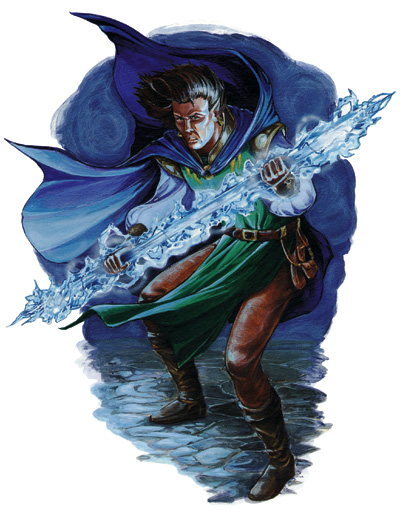
Rounding off we have Elemental Dart, which throws darts of energy types (except sonic) against foes, while Stone Shards turn normal rocks into exploding splash weapons.
I also notice that a lot of the spells have vague casting times, specifying "1 action." Well, what does that mean? A standard action, move action, or full-round action?
Overall a lot of the spells are limited for their level, but there are a few nifty ones, and more than a few tie into the setting's history, so I like that at least.
Special Materials of Ansalon
The final part of our chapters gives a brief overview of the unique materials of Ansalon used in the forging of mighty weapons and armor, along with game stats for the legendary Dragonlances! Wooh!
Dragonmetal can be found beneath the Stone Dragon monument in Foghaven Vale of Southern Ergoth. Formed as a liquid pool of metal, it was used in conjunction with the Silver Arm of Ergoth and the Hammer of Kharas to forge the dragonlances. Since then the spring has been used by the Knights of Solamnia to forge weapons and armor, bestowing it upon the worthiest of heroes. As such, dragonmetal items are always masterwork quality and never bought and sold in legitimate markets.
It's a glistening silver metal lighter than steel, and uses the game stats of mithril for the purposes of crafting armor and determining cost for forging. When fashioned into a weapon it grants a natural +2 enchancement bonus on attack and damage rolls which does not stack with magical or masterwork enhancements.
Star Metal is a blue ore of extraordinary strength and hardness found only in meteorites. It is prized by alchemists, craftsmen, and prospectors, and is treated as adamantine for the purposes of weapon and armor forging.
Ironwood comes from unique trees in the nations of Abanasinia and Qualinesti, known for being light as wood but as hard as steel. Its creation process is a closely guarded guild secret, and you guessed it, it's treated the same as Darkwood!
Silver and Cold Iron are largely the same in the setting.
Throughout the chapter we had several sidebars for new magic items. Given Dragonlance being a low-magic setting of rich history of days long past, none of these are "common" by any means.
Frostreaver is forged from the natural glaciers of southern Ansalon by the Ice Folk in their endless war against the thanoi walrusmen. Under temperatures of 40 degrees Farenheit it's a +4 greataxe, but higher temperatures transform it into a mere +1 weapon. There are several Frostreavers in existence, but they're all closely guarded by the Ice Folk.
The Staff of Magius is one of the most infamous magic items in Krynn. During the Age of Despair it was granted along with the Dagger of Magius to Raistlin after passing his Test. It was wielded by Palin Majere during the Chaos War, only to be lost and never seen again. It's a +2 Quarterstaff which can Enlarge spells that create light, manipulate air, or affect minds three times per day, and grants a +3 deflection bonus to armor class. It bestows a negative level on any non-arcane caster who wields it. Oddly, it seems to exhibit different qualities depending upon who wields it, but this is not reflected in game stats.

The Dagger of Magius is a +3 silver dagger which can never be discovered through magical or mundane searches while on a mage's person. Not much is known about its history other than that Magius crafted it.
The Nightjewel is a minor artifact granted by the master of the Tower of Palanthas, allowing one to pass through its Shoikan grove without succumbing to its effects. The Shoikan grove instills instense fear which can affect even kender, and is populated with all manner of undead creatures. The Nightjewel grants immunity to fear and can be used to turn undead creatures with the wielder's level as the effective cleric level. It's benefits disappear, however, if the wielder draws a weapon or casts a hostile spell within the grove.
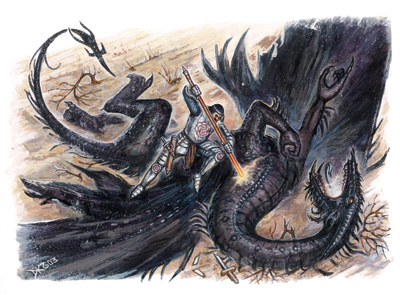
And now, last but not least, the legendary Dragonlances! First created during the Third Dragon War, these are weapons made for the express purpose of killing dragons. When the Solamnic Knight Human Dragonbane used it to fell Takhisis in her five-headed dragon form, the weapons and their wielders' status was cemented in history. After the War they had no more use, and thus the secrets of their creation were forgotten until the War of the Lance (where they proved essential to victory against the Dragon Empire). They also saw use later on during the Chaos War, proving effective against the primordial Gods' chaos-spawned dragons.
Dragonlances are valued beyond price, never bought or sold. They do have sample prices listed for the purposes of assigning treasure value only. The secret of forging them is god-granted, meaning that it can't be made using the typical means of crafting magic items in 3rd Edition.
A Lesser Dragonlance is a +2 Dragon Bane Lance that glows with a soft light. It is created from dragonmetal with either the Silver Arm of Ergoth or the Hammer of Kharas (if both are used during the forging, a Greater Dragonlance is created instead).
A Greater Dragonlance is a whole 'nother story. Forged with both the Silver Arm of Ergoth and the Hammer of Kharas, it is a +4 Dragon Bane Lance. When used against a dragon of evil alignment, it deals 1 point of permanent Constitution drain with every hit; on a critical hit it drains a number equal to the wielder's character level. It is also blessed by the Gods of Light, bestowing two negative levels on any evil creature which wields it (although its powers can still be used). Since Constitution drain reduces a number of hit points equal to the new modifier per hit die, a critical hit with one of these bad boys can really drop a dragon's health down fast!
Thoughts so far: The spells vary widely in balance and usefulness, but that's really the only bad part of the chapter. Departing from the standard dry mechanical text of other D20 Magic sections in books This chapter does a good job of explaining the history of magic and how various organizations and societies adapted to it (especially with examples of famous figures using them in spell descriptions). The new Cleric domains are very versatile overall, and I enjoyed the sample magic items. Despite being a low-magic setting, or perhaps because of it, Dragonlance managed to impart a sense of greatness to it.
Next time, Chapter Four: Deities of Krynn!
Breaking Magic
Original SA post
So I promised to talk about how DLCS was basically God's Gift to Blasters in 3.5 when Reserves of Strength came up. That feat is a part of it, but it'd be worthless without the right spells, wouldn't it? After all, one of the issues with blasting is that it's just woefully inefficient, because it just kind of tickles monsters as you go up in levels in a wide area, which is worth less than hitting them with a Save or Die spell or applying some choice battlefield control like Solid Fog. Why does DLCS fix, and how? The answer is simple.

Yep. None other than the Lightning Lance. To see why, let's take a look. The potential for abuse should be readily apparent.
quote:
Dalamar’s Lightning Lance
Evocation [Electricity]
Level: Sor/Wiz 4
Components: V, S, M
Casting Time: 1 action
Range: Medium (100 ft. + 10 ft./level)
Effect: 1 lightning-lance/five levels
Duration: Instantaneous
Saving Throw: Fortitude half (see text)
Spell Resistance: Yes
You create a crackling lance of lightning that you can hurl at your foes. You must succeed at a ranged touch attack roll to hit. The lance deals 3d6 points of damage from the impact of the strike, plus 1d6 electricity damage per caster level (maximum 10d6). The impact damage is not subject to being reduced by protection from the elements (electricity), spark shield, and similar magic or effects, but the target is entitled to a Fortitude save to halve the electricity damage. You can create and hurl a second lightninglance at 10th level, and a third at 15th level. All bolts must be aimed at enemies within 30 feet of each other.
Material Component: An amber, crystal, or glass rod.
So from the get-go, you can see three things very clearly:
A) Each Lightning Lance you chuck is equivalent to applying three extra caster levels to a normal damage spell, because it does the usual 'CL up to 10' dance AND adds three dice on top.
B) Lightning Lance doesn't scale linearly because its power doubles at CL 10 then triples at 15.
C) Lightning Lance is very, very friendly to metamagic, because all effects you apply are multiplied by the number of lances. If you Twin the spell (launch it twice) you huck six lances. If you Empower it, you multiply every last die by 1.5.
So in other words, if you use Reserves of Strength on this little spell...well, for starters, you add 9d6 dice, which is pretty nice. On top of that, you also gain the ability to multiply any further CL boosts by 3. On top of that , by a certain reading, Reserves of Strength may also lift the cap on the number of lances you can throw, too, which means if you could push your CL up to, say, 25, you'd throw 5 lances, each doing 3d6+25d6 damage. Incidentally, similar shenanigans can be done with the PHB's Scorching Ray and Elemental Dart. If I was a blaster wizard, DLCS would be my very first book picked to select material from after finding one with a decent CL boosting Prestige Class.
Deities of Krynn
Original SA post
Dragonlance Campaign Setting Chapter Four: Deities of Krynn
There anything existed, there was only the High God and Chaos. The High God strove to bring order to Chaos, who in turn strove to undo the High God's creations. The High God brought three creations from the ether: Paladine, Gilean, and Takhisis, who in turn made other gods who aligned with them based upon their varying philosophies. A great triangle of Good, Evil, and Neutrality were the pillars upon which the world would be forged. Reorx struck his hammer against Chaos, the sparks from the blow creating the stars, and from their light came the first souls. The deities (except for the High God and Chaos) quarreled over these souls and what to do with them: Paladine and the Gods of Good sought to guide them on a proper course and eventually share dominion with them over the universe. Takhisis and the Gods of Evil sought to have dominion over the spirits. Gilean and the Gods of Neutrality valued free will, maintaining that it should be up to the souls who'd they'd follow.
Eventually the gods and their souls battled in what came to be referred to by mortals as the All-Saints War. Chaos delighted in this turmoil from afar, while the High God watched with worry and knew that if any were to fall all their work in the universe would be undone.
The High God called for a compromise to end the war, and bestow one gift upon the souls. The Gods of Good gave souls life and physical forms so that they could alter their reality and be more like the deities, the Gods of Neutrality free will, and the Gods of Evil hunger, thirst, and other limitations to satisfy their needs (so that they'd be more desperate to turn to them and thus be subjugated). The gods created the world of Krynn as a place for the physical beings to dwell.
And through it all, Chaos lurks at the edges of creation, still seeking to undo reality and all the deities' work.
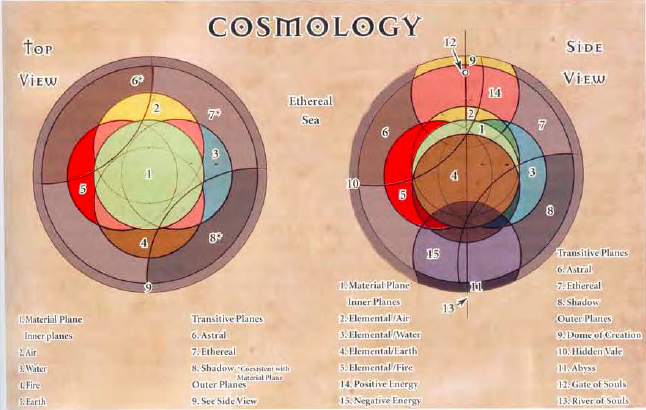
Cosmology-wise, Dragonlance has the Transitive and Inner Planes of normal 3rd Edition, with three Outer Planes home to the three groups of deities. None of the Outer Planes can be reached via mortal magic, and portals to the Abyss on Krynn are incredibly rare artifacts. The most common means of entering the outer planes is via the Gate of Souls, a portal for spirits which flows in a constant cycle of life and death on Krynn, through the Ethereal Sea. This phenomenon is referred to as the River of Souls. Additionally, the Ethereal Plane is but a smaller part of the greater place, the Ethereal Sea, which stretches beyond even the Gods' imaginings.
The Gods
Technically there are 21 Gods, 7 for each of the moral alignments. The High God is a distant entity whose plans are unknown even to the deities, while Chaos is a primordial element who doesn't grant prayers. It does have otherworldly minions infused with a bit of it's power during the Chaos War, and in Bestiary of Krynn there is a Scourge of Chaos Prestige Class focused around this.
The Gods of Good
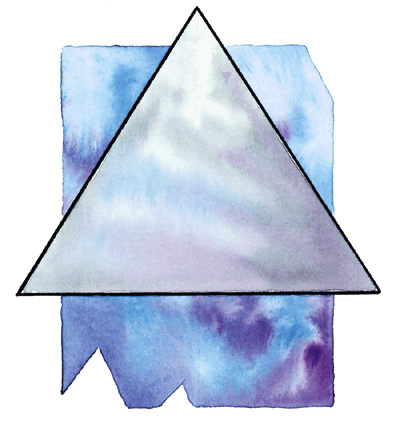
Paladine is the Lawful Good god of metallic dragons, good, law, light, and protection. He leads the other deities of Good by example, and his power is rivaled among the gods only by Gilean and Takhisis. All dragons, even the chromatic ones, are his children. His clerics helped fight against Takhisis' forces many times throughout history, and they acted as spiritual guides for the people. The believe that a just government is necessary for society, and historically acted as judges, barristers, and advisers. Paladine's favored weapon is the longsword, and his domains are Good, Law, Protection, and Sun. Clerics must be of any Good alignment to receive spells (an exception to the one-step rule). As of the Age of Mortals he is now mortal and can no longer grant spells.
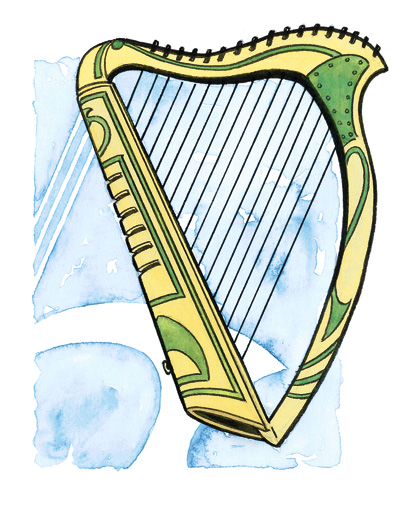
Branchala is the Chaotic Good god of music, poetry, bards, and art of all kinds. He brings joy to the world and its creatures through these concepts, and his clerics are charged with encouraging the written and spoken word to the peoples of Krynn. They are loosely-organized with few permanent ties, but are known for hosting and organizing holidays and celebrations, and are beloved in kender and elven communities. His favored weapon is the rapier, and his domains are Chaos, Good, Luck, and Trickery.
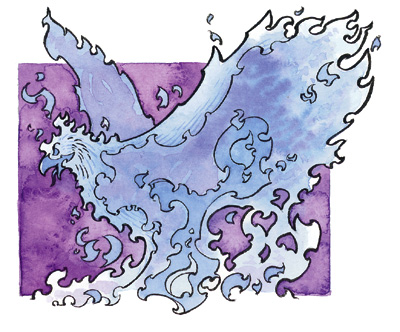
Habbakuk is the Neutral Good god of animals, water, passion, and rebirth. He is commonly known as the Fisher King, and looks over all of nature as his charges. Phoenixes are associated with him, and he's heavily associated with the sea and popular among coastal and fishing communities. His priesthood is evenly split between clerics and druids, and neither have a formalized hierarchy. Once during their lifetime, clerics must wander the land with nothing but a walking stick and the clothes on their back to better understand the ways of nature. The god's favored weapon is the scimitar, and his domains are Animal, Good, and Water.
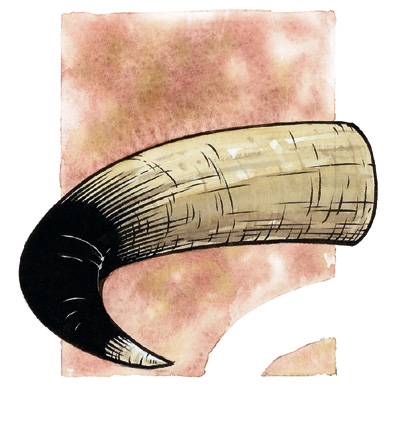
Kiri-Jolith is the Lawful Good god of honor, obedience, justice, and righteous warfare. He is popular among the knights of Solamnia, especially the Knights of the Sword of which he is patron, and his priesthood trains daily so that they can protect others from the depredations of evil, and actively seek out tyrants and wicked folk in positions of power to fight them. His favored weapon is the longsword, and his domains are Good, Strength, and War.
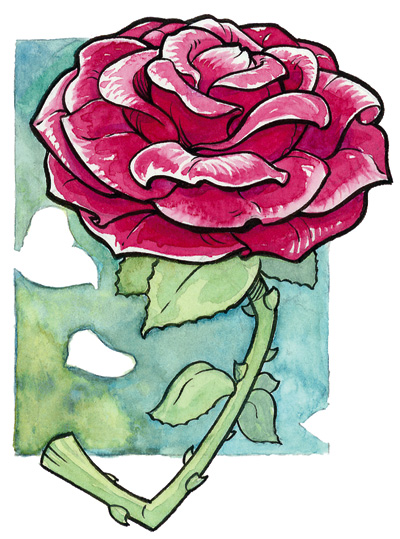
Majere is a Lawful Good god of discipline and loyalty. Of all the deities he has the best understanding of the High God's plans and acts as a sort of wise fatherly mentor to the other Gods of Good. His priesthood is small, but some of Krynn's greatest teachers and theologians come from his ranks, and their works have even influenced other good-aligned religious orders. Clerics live in isolated monasteries and follow a strict regimen of self-discipline and vows of poverty, obedience, and chastity so that they can better focus on enlightenment and the contemplation of Good. Many martial artists number among Majere's faithful, to better harness their self-discipline or for increased spiritual awareness. Majere's favored weapon is the unarmed strike, and his domains are Good, Law, and Meditation.
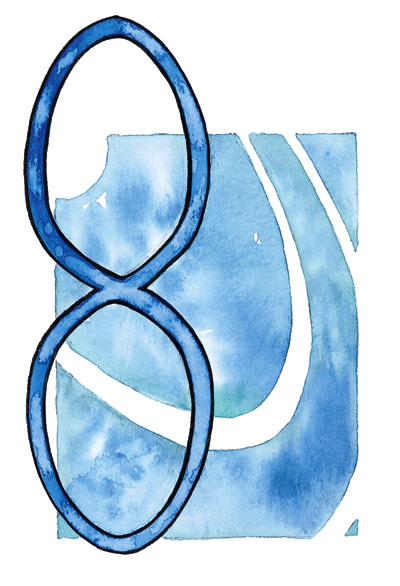
Mishakal is the Neutral Good goddess of healing, compassion, fertility, and community. She is very popular throughout Ansalon, as her clerics actively part in bettering their local communities and tending to the old, the injured, the sick, and other people unable to care for themselves. They're part not to withhold divine healing from everyone, even those of evil alignment, although their churches accept tithes in exchange for service for those who can afford it. The priesthood is more centralized and widespread than the other Gods of Good (with the exception of Paladine), and is led by the Chosen Prophet who is served by a council of priests representing various regions of Ansalon. They hate Morgion and his faithful, who seek to spread disease and decay. Her favored weapon is the quarterstaff, and her domains are Community, Good, Healing, and Protection.

Solinari is the Lawful Good god of magic and patron of the Wizards of the White Robes. His primary ambition is to spread magic throughout the world and bring more worthy mages to his Order. He teaches his wizards that magic is a gift to be shared with the world and worked for the benefit of all. They seek out lost libraries and magical items to expand their knowledge of magic, and promote good works. Solinari has no clerics, domains, or favored weapon, and he works closely with his siblings Lunitari and Nuitari to protect and foster magic on Krynn.
The Gods of Neutrality
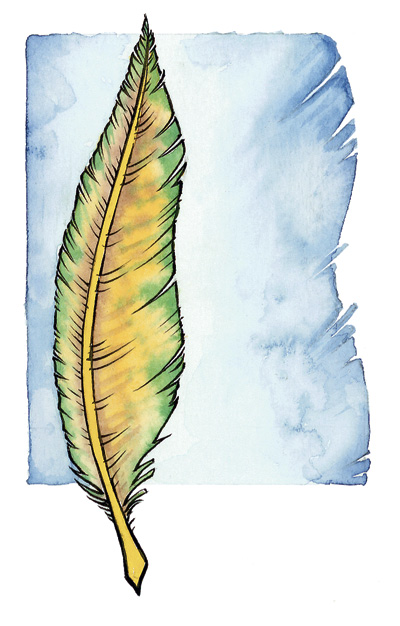
Chislev is the Neutral goddess of nature incarnate. Every animal and plant on Krynn reveres her, and according to legend the four seasons are manifestations of her moods. The priesthood is mainly comprised of druids who oversee and protect plots of land in the wilderness, and a few clerics live in small farming communities. Both do their best efforts to prevent people from despoiling the land through mundane or magical means, and many of them are doing their best to counter the changes wrought by the Dragon Overlords' magic. She has a good relationship with Habbakuk and hates Zeboim as the two fought during the All-Saints War. Her favored weapon is the shortspear, and her domains are Air, Animal, Earth, and Plant.
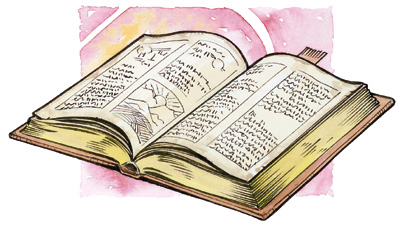
Gilean is the leader of the Gods of Neutrality and represents knowledge, free will, and the Balance. He is the keeper of the Tobril, the book gifted to him by the High God which contains his plans for creation. He is dispassionate, interfering only when the laws of Creation are being challenged. His priesthood usually acts as librarians, scribes, and historians. They're dedicated to the spread of information and knowledge, and as such oppose attempts to restrict education and burn books. His favored weapon is the quarterstaff, and his domains are Knowledge, Liberation, and Protection.
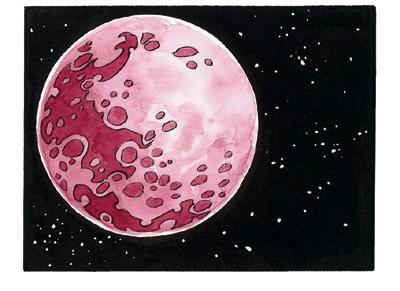
Lunitari is the Neutral goddess of magic and the Wizards of the Red Robes. Her primary ambition is to further the cause of magic in the world and maintain the delicate balance between good and evil. Her followers, the Red Robes, are more numerous than either the White or Red Robes, and are primarily concerned with knowledge and promotion of magic for the sake of it. She's also the daughter of Gilean and has a mischievous streak, using illusions to amuse and entertain herself and others.
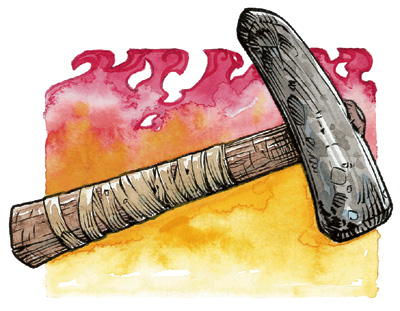
Reorx is the Neutral god of creation, engineering and technological innovation, and patron of the dwarves and gnomes. He has a strong following among the dwarves, and his priesthood has a significant influence among their communities. Within a dwarven thane, the Starmaster (head of the local church) has almost as much power as the thane (dwarven noble), and they have a say in most important aspects of dwarven life. They also produce some of the best weapons in the dwarven realms. The gnome branch of the faith isn't as influential among their respective race, but they still honor him as the greatest of gods. All clerics must create an object to honor Reorx during their lifetime, and as such usually takes years to complete. His favored weapon's the warhammer, and his domains are Earth, Fire, and Forge.
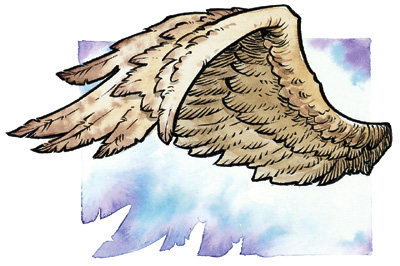
Shinare's the Lawful Neutral (that's a first!) goddess of commerce, industry, and wealth. Her followers are mercenaries, merchants, and traders. Her clerics are hard-working and industrious, and often use their business acumen for community growth. They must also pay their taxes and tithes on time, and taught not to pursue shady and selfish business practices which can lead to widespread suffering (that's Hiddukel's domain). As they're responsible for bringing prosperity to many communities, she is a respected and admired deity throughout most of Ansalon. She and her priests work closely with Reorx, due to the links between artisans and merchants, and she has a fond relationship with Sirrion. Her favored weapon is the light mace, and her domains are Law, Luck, and Travel.
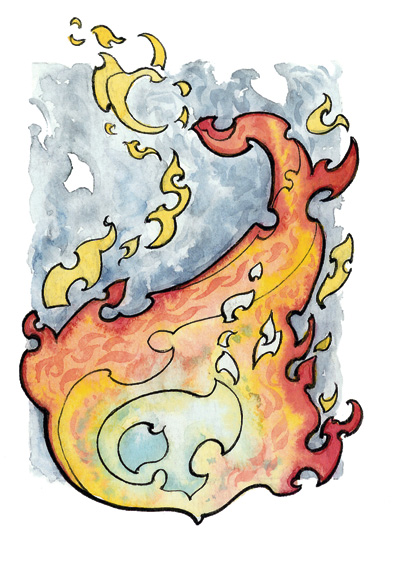
Sirrion is the Chaotic Neutral god of creativity, passion, and fire. He sculpts the fires of the soul into many forms and grants divine inspiration to artists and other creative sorts. His domain over fire is that of an element of cleansing, renewal, and transformation. Fire can destroy impurities, change objects from one state to another, and destroy old and dying trees to make way for new ones in nature. He doesn't much care for worshipers, only actively recruiting when his friendly rival and lover Shinare appears to be gaining the upper hand. His priesthood also helps combat out of control fires, and often act as matchmakers for those in love. His favored weapon is the heavy flail, and his domains are Chaos, Fire, and Passion.
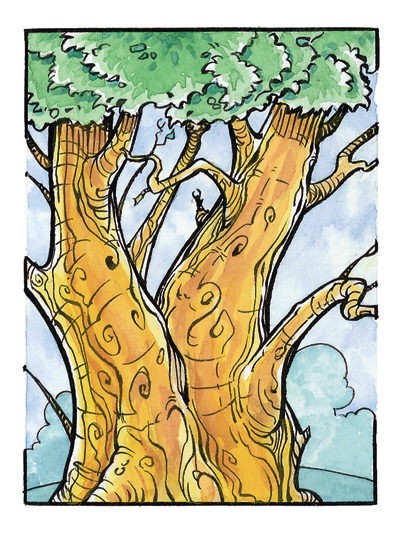
Zivilyn is the Neutral god of wisdom, foresight, and prophecy. His symbol is the World Tree and is the bearer of all insight in the universe. His branches reach into every time and place, and is the wisest and most calm of the gods. His priesthood is a hierarchal one, with older members in more prominent positions, and serve as counselors, mediators, philosophers, and diplomats, and in communities with no priests of Paladine as judges and advisers. He is married to Chislev, and works closely with Gilean as knowledge and wisdom are complementary forces. He doesn't really count any gods as his enemies, but he's not fond of Sargonnas' and Zeboim's emotional natures. His faithful have something of a rivalry with the church of Majere; Majere seeks understanding through understanding the will of the High God, while Zivilyn promotes people to look within themselves. His favored weapon is the quarterstaff (man, this is a really common weapon), and his domains are Insight, Knowledge, and Meditation.
The Gods of Evil
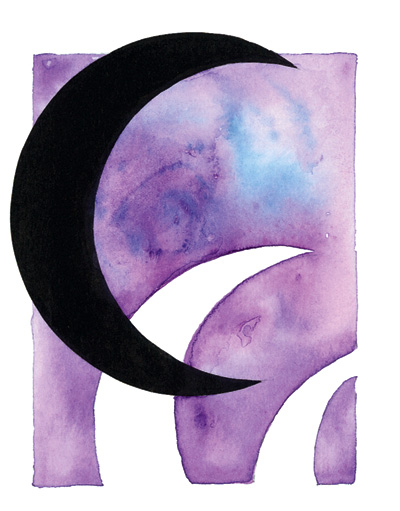
Takhisis is the (former) head of the Gods of Darkness and the embodiment of Evil, she is a Lawful Evil deity of hate, darkness, tyranny, and the chromatic dragons. Throughout her existence she sought to be the greatest and most powerful entity in the universe, and her followers carried out many ambitious plots on her behalf to achieve world domination of Krynn as its one and only deity. Many of her followers are nonhumans, especially among the ogres, goblins, and draconians during the War of the Lance. The chromatic dragons are her most favored, promising them a favored spot beside her the day she rules Krynn. In the Age of Mortals she was instrumental in stealing away the world and gaining followers as the One God, but she was killed by the elf Silvanoshei when she was cursed with mortality by the other deities for her crime. Her favored weapon is the heavy mace, and her domains are Destruction, Evil, Law, and Trickery; clerics must be of any evil alignment to worship her.
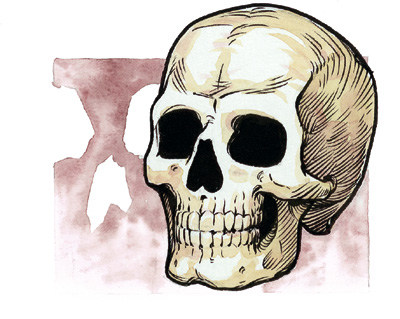
Chemosh is the Neutral Evil god of death, the undead, and murder. He was the first god to side with Takhisis in the All-Saints War, and he animates corpses and imprisons souls as his undead slaves by promising mortals with eternal "life." His priesthood works in secret and believes that there is no existence after death; Chemosh teaches that the other Gods are liars, that no souls exist in the afterlife and that he's the only god who can grant people everlasting existence. His church has no centralized hierarchy, and they're not fond of arcane necromancers (who either serve Nuitari as Black Robes, or are not giving Chemosh his proper respect). His favored weapon is the sickle, and his domains are Death, Evil, and Trickery.
In Dragonlance canon he's been rather active as a God of Evil (Takhisis hogged the spotlight most of the time): he is a major behind the scenes player in the Key of Destiny adventure path, and in the alternate where Raistlin becomes a God he collaborates with the mage to destroy the rest of the pantheon and absorb their divine essence for himself.
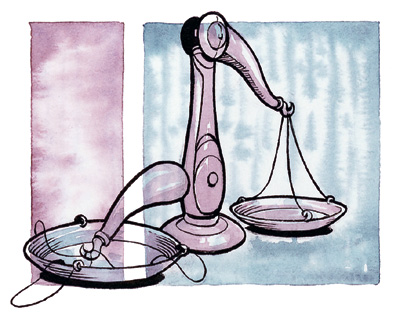
Hiddukel is the Chaotic Evil god of deception, ill-gotten wealth, and the patron deity of dishonest merchants and thieves. He constantly seeks bargains, promising people their heart's desire in exchange for servitude. Very few people willingly become a cleric of Hiddukel, usually tricked into it. Hiddukel encourages his unwitting followers to pursue material wealth and prestige by any means necessary, and he has no church as each cleric is pretty much on their own. He is an enemy of Shinare, who favors fair and honest deals with benefit the community, and as such Hiddukel encourages his faithful to destroy her temples and kill her priests.
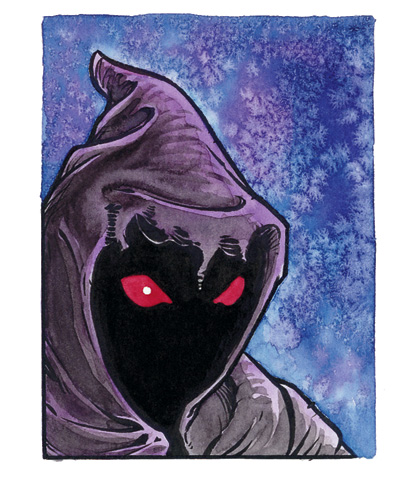
Morgion is the Neutral Evil god of decay, disease, and suffering. Even the other gods of Evil refuse to associate with him, and he keeps to himself in the Abyss in his Bronze Tower, where he plots and schemes in secret. He uses pestilence and plagues to spread fear among Ansalon, and virtually nobody worships hims of their own free will. His most common means of gaining clerics is visiting people ravaged by disease; he offers a deal, to grant immunity to the disease in exchange for servitude. Those who accept find themselves "cured," but for the rest of their days are required to do Morgion's work and spread more disease among communities, thus gaining more opportunities of recruitment for the deity. They must keep their affiliation secret, for they are welcomed nowhere. His favored weapon is the heavy flail, and his domains are Destruction, Evil, and Pestilence.
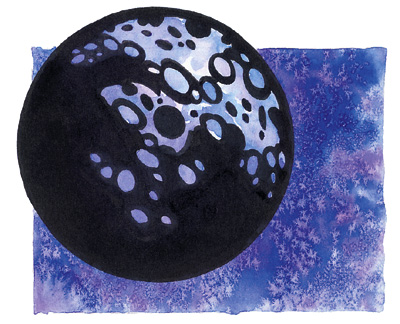
Nuitari is the Lawful Evil god of magic and the Wizards of the Black Robes. He gains followers by promising them more power than Solinari or Lunitari can give, and that magic is to be secret and coveted from the unworthy, and to use it for personal benefit. His moon is invisible, a black hole in the night sky, to all but the Wizards who follow him. The Black Robes claim that their moon's radiance is the brightest of them all.
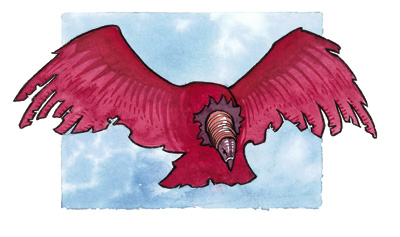
Sargonnas is the Lawful Evil god of vengeance, conquest, strength, and rage. He is a militant deity who demands strict obedience from those who follow him, and is worshiped among the Minotaurs (who call him Sargas and believe him to be an entirely separate deity). Among them, he is viewed as one who rewards the strong with power, while nonminotaurs often look to him as a deity of vengeance. His clerics are often sought out by individuals who feel wronged, and many turn to the god in times of hardship and war. His favored weapon is the greataxe, and his domains are Evil, Fire, Law, and War. I don't know where the Fire part comes in; I always figure that Strength is a more appropriate domain.
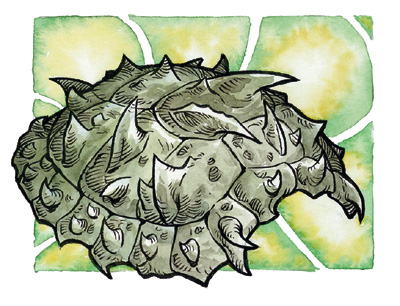
Zeboim is the Chaotic Evil goddess of wrath, the sea, and storms. She is feared by the civilizations of the sea and appeased by sailors hoping to stay her anger. Her priests alternatively extort sailors and shipowners into paying tithes in exchange for good weather, and serving on ships to assist passengers in paying proper respects to the goddess. She is hostile to the other two nature goddesses, and divine spellcasters who worship her often conduct elaborate ceremonies where they sacrifice material possessions to the depths of the ocean to the glory of the Sea Queen. Her favored weapon is the trident, and her domains are Chaos, Evil, Storm, and Water.
And that's it for the true Gods of Krynn!
Thoughts so far: I feel that the deities overall are a mixed bag. There are many innovating and interesting ones, but there's a sort of samey-ness to a lot of them. More than a few use the same favored weapons (quarterstaff being the biggest offender), and some of their portfolios feel like they overlap too much (such as Chemosh and Morgion, Paladine and Kiri-Jolith). On a more positive note, I like how they implemented Chemosh's teachings and the inability to travel to the afterlife with the Outer Planes to make undeath a more appealing state. It's the kind of thing you can see really desperate people reaching for. I also enjoy Sirron the most: his manifestation of fire as a multi-faceted element of renewal and transformation.
Next time, Chapter 5: Geography, where we finally cover the places and nations of Ansalon!
Geography
Original SA post
Dragonlance Campaign Setting Chapter Five: Geography
Note: The main book and wizards.com do not have a full-size detailed map, instead splitting the continent into 8 sections. I found a collection of them here so that you won't have to download them.
This chapter examines each of Ansalon's major nations in alphabetical order, detailing things such as the system of government, major population centers and the most prominent races, and important sites. In early 3rd Edition, each nation in a D&D setting had an Alignment descriptor. Supposedly it was to show the moral leaning of the government's leaders, but in Dragonlance it indicates the general tendency of the people of the land, with the most common one first. So a nation which is NG, LN has Neutral Good people the most common, followed by Lawful Neutral people. The histories of the nation are brief, generally covering 5th Age events.
Abanasinia is a frontier nation in southwestern Ansalon. The region's indigenous population are the Abanasinian Plainsmen, who are based off of real-world Great Plains Native Americans (such as the Sioux). They are united under chieftians and united into a confederation after the War of the Lance to better protect their numbers. The realm also boasts a sizable community of settlers and their descendants, ranging from Ergoth to Solamnia and lands beyond. Settler cities are relatively autonomous, each having their own distinct forms of government, with the village of Solace being the most iconic.
In fact, Solace gets the largest write-up by far. In the original Chronicles it was where the Heroes of the Lance began their adventure, at the cozy Inn of the Last Home just as the Dragonarmies came to invade. Solace is a city of trees, houses positioned in the safety of massive branches which can be easily traversed so that you never have to set foot on the ground. Solace has a huge refugee population outside its borders, of people fleeing the tyranny of the Dark Knights and Dragon Overlords.
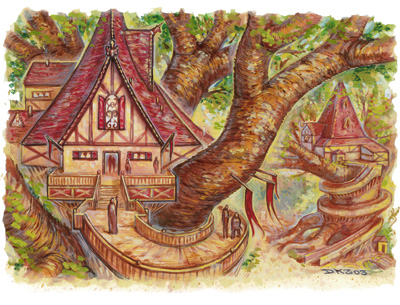
Balifor a region at the western end of Goodlund, and now encompasses The Desolation. The Red Dragon Overlord Malystryx transformed it into a volcanic wasteland of horrors, with only the most desperate and tough individuals remaining. The majority of its population are monsters such as ogres, dragonspawn, and draconians, but there are two small population centers, Port Balifor and Flotsam, on its extremities. Unlike the other Dragon Overlords who died, the region is not returning to its normal self, which greatly worries people.
The Blood Sea Isles dominated Ansalon's eastern end, and include the four isles of Saifhum, Karthay, Kothas, and Mithas. Its human inhabitants are the descendants of Istarians who found themselves stranded on islands after the Cataclysm, and adopted to sea life. A huge red storm the size of a small country known as the Maelstrom used to encompass the majority of open water, stifling trade, although it suddenly disappeared after the War of Souls.
Saifhum is inhabited by human mariners and pirates. It is a rocky island with little vegetation, and an extensive network of windsail-powered carts is used as a mode of travel. Mithas and Kothas are part of the Minotaur nation, who are a martial culture who decides most major events through ritual combat. They sail to Flotsam for supplies now and then, but prefer to raid Saifhum ships instead. The island of Karthay is an uninhabited land of hot, barren plains and tall mountains with rainforests at the top. It is home to the mysterous Kyrie, a race of winged humanoids who keep to themselves.
Estwilde is a forested, swampy nation in north-central Ansalon, to the west of Neraka and south of Nordmaar. It is a rural region, with most inhabitants living in tribal hunter-gatherer societies, and three powerful dragons claimed vast reaches of the realm for themselves. The 3 most common tribes are the Lor-Tai, who are good-hearted and peaceful, yet have an intricate system of taboos which prevents them from even speaking to outsiders or interacting with them in any significant fashion. The Lahutians live in the Lahue Forest, and practice cannibalism on outsiders; they are Chaotic Evil and view non Lahutians as no better than cattle to be eaten. The Mountain Barbarians are supposed to be bad guys, too, but the book poorly describes why they're bad. They're "surly and treacherous," trade with goblins and ogres, hate and fear the "strong-hearted" nation of Solamnia, and "lack the imagination to believe they need anything more than what their squalid lives offer." If anything they sound xenophobic more than anything.
Goodlund is the rest of the Desolation, and doesn't really have much more info than what Balifor provided. The major settlements are underground in ancient goblin catacombs, and includes a town of afflicted kender who make commando raids against Malystryx's remaining forces.
Hylo is a kender nation in the forested northern reaches of Northern Ergoth. Its natural terrain makes it a well-defended locale, with a mountain range to the west, open ocean to the east, empty wasteland to the north, and inhospitable desert to the south. The kender lived a trouble-free existence for centuries, being unaffected by the Cataclysm (yet saddened by the disappearance of the Gods). A huge population of afflicted kender refugees moved in and were accepted to the region, causing tension and strife between them and the "true" kender. The afflicted kender are distrustful and insist on shoring up Hylo's defenses, while the true kender believe them to be cursed (yet are still too good-hearted to oppress them). Interesting locations include the tree-city of Lookit, and a mysterious obsidian structure known only as "the Tower" which a bunch of true kender live inside. A magical sentience lives within the Tower, and nobody knows its true origins, but the "true" kender regard it as their best friend.
Icereach is less a nation than a region encompassing the far southern reaches of Ansalon. Composed entirely of arctic tundra, it remains mostly unexplored and is home to human nomads known as the Ice Folk, and evil walrus-men known as the thanoi. The two have warred against each other since the Cataclysm, and neither side is willing to give up; it's pretty much a way of life by now. Two white dragons, Cryonisis and Frisindia (both female wyrms) are the closest thing the land has to a superpower, and both claim western and eastern terrain as their domain. A few interesting places include the abandoned city of Frozen Past, the ruins of the huldrefolk (the first and oldest fey on Krynn), and the ruins of Icewall Castle (once home to Feal-Thas, the dark elf White Dragon Highlord of the Dragon Empire in the War of the Lance).
Kharolis is a nation of southwestern Ansalon which was once claimed by the Green Dragon Overlord Beryllinthranox. In recent years the Knights of Neraka took over the region and know rule the land under an iron fist. They hire ogre mercenaries to patrol the southern border along Icereach to keep back the Thanoi, but unbeknownst to them the two monstrous races plan on overthrowing them. They are also aided by human rebels who plan on killing them once they overthrow the Dark Knights. The Tower of Wayreth lies in the magical forest in the northern section of the nation, and the Thorn Knights built outposts in the wilderness and towns in search of the Tower. The Tower has yet to be found, and is not admitting any visitors (even other Wizards of High Sorcery).
Khur is a nation located in eastern Ansalon, to the west of Balifor and to the north of Silvanesti. It is home to the Khur people, who are based off of real-world Arabs and arranged into seven different tribes. Their nation is no stranger to foreign influence; back during the War of the Lance, the Green Dragonarmy of the Dragon Empire invaded the nation before being driven out. In recent years the Dark Knights have established alliances with certain tribes and cities, and an influx of refugee elves from Silvanesti has made life interesting. After recovering from being under the baleful eye of Malystryx, the region is undergoing a sense of unity, as Khurish tribes seek to put aside old hatreds in face of more pressing foreign influences. In addition to native Khurs, many citizens of the cities are the descendents of Dragonarmy officers, and so there's a sizable Nerakan minority in the nation.
Neraka is an inhospitable mountain nation in eastern Ansalon. It is a very old nation with close ties to Evil, first formed by travellers guided by visions from Takhisis to a fabled lost city. There they found the magically relocated Temple of Istar, originally under the ocean of the Blood Sea. The Foundation Stone inside it allowed the goddess to communicate with these travelers and grant them the gift of divine magic. Along with her favored children, the chromatic dragons, she formed a massive army out of these forces and set about conquering much of Krynn as the Dragon Empire. Even after the temple's explosion and the end of the War of the Lance, the region was still a stronghold of those swearing fealty to the Dark Queen, and the Knights of Neraka are a major presence her (in fact, they changed their name from Knights of Takhisis to this because it was their base of power on Ansalon). The capital city, Neraka, is a shadow of its former glory, its once-great temple filled with unknowable evils which keep even the Knights at bay. The nation's cities are filled with monsters who traditionally served in the Dragonarmies, from goblins to ogres to draconians, and as such is a more accepting climate for these groups.
Nightlund was formerly an eastern province of Solamnia. Once a fertile and peaceful region, it was cursed with twilight and gloom when its ruler, Lord Soth, failed to stop the Kingpriest and instead killed his wife on suspicion of infidelity. Cursed to be a death knight, he found himself the ruler of a nightmarish realm filled with undead in a godless world. The nation has remained this way until the War of Souls, after which the curse was lifted when Soth rejected Mina's offer to join the One God's army and was killed for it. It is now a fertile and bright land, but people still avoid it for its sinister reputation. One of the Towers of High Sorcery, the Tower of Palanthas, is located here (after being teleported away from the city of the same name), filled with undead guardians.
Nordmaar is a tropical nation in Ansalon's far north. It is a feudal kingdom of highland horsemen and home to great stone cities in its rainforests. Its people are known for valiantly fighting off enemy invasions, from the Red Dragonarmy during the War of the Lance, shadow wights during the Chaos War, and most recently a black dragon wyrm named Mohrlex who also rules a portion of Estwilde to the south. Nordmaarians are organized into tribes who are all ruled by a single king, and they have good relations with the nation of Solamnia to the west. Interesting locations in the region include a great giant rock shaped like a man riding a horse in the northeastern jungles, and a legendary shrine to Habbakuk known as the Fountain of Renewal in the swamplands (which is sought after by Mohrlex's forces).
Northern Ergoth is the oldest human nation located on an island off the coast of western Ansalon. Formed during the Age of Dreams, its empire once occupied almost all of western Ansalon before the Cataclysm flooded most of it. Despite these losses, Ergoth remained a relatively stable feudal nation. Its people are known throughout the continent as skilled mariners, and Ergothian merchants are a common sight through much of Ansalon. In recent years of the Fifth Age it's becoming the continent's preeminent cultural center, home to a fabled bardic college and a flourishing university and library in the capital city of Gwynned. Mina's crusade under the One God's banner never touched Ergothian shores, and its people welcomed the return of the deities along with mysticism, and the two groups put aside theological differences to support the empire. The nation's southern region of Sikket'hul is home to several towns of non-evil goblins, who keep to themselves but have some trade with the humans.
The Plains of Dust are a hot, arid region of south-central Ansalon which was traditionally a cold, arid region due to the disappearance of the Maelstrom. Traditionally nomadic humans related to the Abanasinians lived here along with centaurs, but a recent influx of refugee elves of both Qualinesti and Silvanesti put a significant strain on the region's resources. The elves, meanwhile, are disorganized and grouped into varying factions. Gilthas, a half-elf Qualinesti noble, does his best to settle disputes, but the more bigoted factions do not respect the word of a half-human. Some elves want to reclaim their homelands by force, while others desire aid from human cities and establish ties and favors with their peoples' skills. During the Fifth Age, two dragons from the same realm the Overlords came from ruled over much of the eastern Plains, and a group of centaurs and humans formed the nation of Duntollik to counter their threat. After the dragons' death, they are now the preeminent political group in the region.
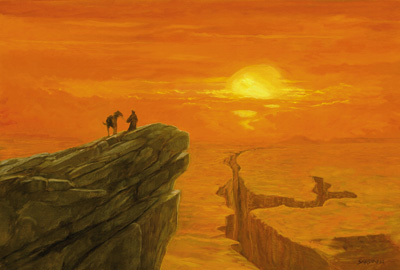
We also get stat block write-ups and backstories of Gilthas and Linsha Majere, a Solamnic Knight instrumental in Duntollik's formation.
Qualinesti is a forested nation in southwestern Ansalon, the traditional homeland of the Qualinesti elves. In the Age of Dreams a faction of Silvanesti elves were tired of their peoples' rigid society and created a more tolerant and progressive nation in the forests to the west. They maintained good relations with humans and dwarves during the Age of Might, but their society underwent significant hardship in the Age of Despair. They had to flee their homes during the War of the Lance, when the Red Dragonarmy invaded. During the Age of Dreams their nation was conquered by the Green Dragon Overlord Beryllanthranox. Eventually they were provided information that the dragon was planning on killing them all, and some dwarves and sympathetic Dark Knights helped smuggle elves out before she could destroy them, leaving the warriors among them behind to lead a joint attack on the Overlord in the capital city. The battle resulted in the dragons' death, but her massive formed crashed into the tunnels below and causing the nearby rivers to fill up a new lake. The northern reaches of the land are claimed by opportunistic human bandits, with a never-before-seen alliance of goblins to the south, who are believed to be a new nation formed during the social turmoil.
Sancrist is an island nation off the coast of western Ansalon. Its eastern half is a mountain range inhabited by gnomes, their greatest city of Mt. Nevermind containing technology leagues ahead of any other on the continent. The western section of Sancrist is home to forest and Solamnic settlers, who created the new nation of Gunthar in this region. Castle Uth Wistan is its capital, and home to the grandmaster of the Knights of Solamnia. A vicious red dragon Pyrothraxus lives among the gnomes of Mt. Nevermind, who are more than happy to pay him wealth and riches in exchange for the rare opportunity to research a living dragon.
Schallsea is an island nation off the coast of northern Abanasinia. It is home to the Wemitowuk people, who are related to the Abanasinian Plainsmen. It is home to the Citadel of Light, a preeminent center of learning for mystics, and is undergoing repair after the Green Dragon Overlord's assault on the building grounds. The island is home to the Garden of the Dead, a traditional place of punishment for the natives to send exiles who committed crimes against the community. The tunnel entrance became closed at the start of the Age of Mortals.
Silvanesti is the oldest elven nation and occupies a significant portion of southeast Ansalon. For the longest time it was a major superpower, with a rich magical history and valiant warriors. It has always been an isolated nation, closing itself off from the rest of the world after the Cataclysm. The Dragon Empire viewed them as a threat and fought against them before the War of the Lance. In recent years a minotaur invasion strengthened by the presence of Dark Knights. The great cities were occupied by forces, its inhabitants forced out. The minotaurs forced out the Dark Knights shortly afterwards; despite the elves' worst fears, the minotaurs have not destroyed or razed the cities, instead using them as new settlements for their forces.

Solamnia is a large and powerful nation covering a great portion of western Ansalon. The Knights of Solamnia served as the governing body since the Age of Dreams, but during the Age of Mortals the Blue Dragon Overlord Khellendros took over the city of Palanthas and much of northern Solamnia with the help of rogue Dark Knights. The Knights still rule Palanthas, and although society continues, some hope that one day the Knight of Solamnia drive them out.
During the Age of Despair many peasants blamed the Knights for failing to protect them during the Cataclysm and overthrew many of their counties. But the Knights' respect was restored when they played a contributing factor in the War of the Lance fighting Takhisis' forces. Bolstered by Sturm Brightblade's examples during the War, the formerly traditionalist and hidebound order became more progressive and open over time.
Solanthus is Solamnnia's traditional capital, but Palanthas is its greatest city (the Waterdeep, the Sharn, the Greyhawk of Dragonlance). A port town surrounded by mountains, Palanthas managed to escape the Cataclysm relatively unscathed and became the continent's cradle of civilization. Its Great Library is run by clerics of Gilean, led by the enigmatic Astinus who attempts to write down the collected knowledge of Krynn. It was also once home to a Tower of High Sorcery, and the High Clerist's Tower (once a holdover from the Age of Might) was home to a pivotal battle during the War of the Lance.
A dwarven nation of Kayolin supplies Solamnia with gems and precious metals, and the two nations get along very well.
Southern Ergoth is nominally part of the Empire of Ergoth, but this once-temperate land has been occupied by the White Dragon Overlord Gellidus and reshaped into an arctic nightmare. A legion of ogres and dragonspawn enforce his will from the city of Daltigoth, and the Solamnic outpost of Castle Eastwatch entered into an alliance with elven communities to fight them. During the War of the Lance the Qualinesti and Silvanesti elves moved here, and enslaved the native Kagonesti elves to build new communities. All three elves still live in Ergoth, not necessarily getting along but sharing a common enemy against Gellidus. The Solamnic Knights guard the Tomb of Huma, the resting place of the legendary hero. A natural pool of dragonmetal, along with the lore necessary to build the Dragonlances, gives the Solamnics an advantage against the dragonspawn.
Teyr is a new nation to the north of Neraka, formed by and for draconians. During the War of the Lance draconians were created from the eggs of good dragons in an unholy ritual. Only the male eggs were selected, both for population control and for the Dragon Empire to better control them. A draconian general named Kang discovered the location of the female draconian eggs, and managed to capture them with the help of his regiment after the Empire's collapse. Emboldened with the discovery that they were a true race, they found an abandoned dwarven city to form a new society. From there, Kang created a new autonomous nation for his people. And they're non-evil, too! Teyr is a military government overseen by civilian leaders, and military culture abounds even though draconians are adopting "civilian" occupations and adjusting to relative peace. The nation is very well-defended, with military outposts along the borders.
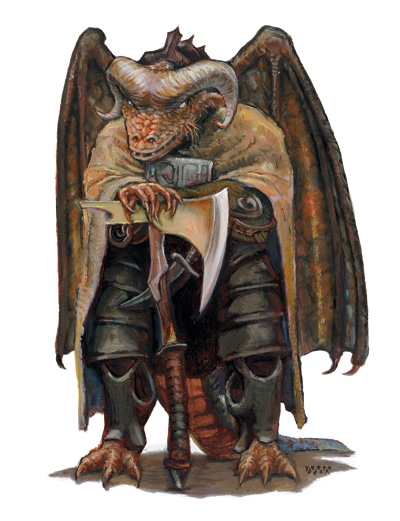
Thoradin is a dwarven nation located in the mountains of Neraka. Its sole city is Zhakar, which was ruled by dark dwarves who went insane from an insidious and poisonous mushroom colony. A particularly outspoken dwarf, Severus Stonehand, disagreed with his people's decision to seal off their kingdom from the world in light of the Dragon Overlords' arrival. He underwent a religious pilgrimage, he returned to his homeland and mounted an insurrection against the Council of Thanes. With divine magic he discovered a cure to the Zhakar's mushroom plague, and through this he earned the eternal gratitude and goodwill of the people, along with a new seat in government. He signed a trade and military agreement with the nearby Knights of Neraka, supplying them with fine dwarven weapons and armor in exchange for protection from the nearby ogre nations of Blode and Kern.
On that note, Blode and Kern are not detailed in this book.
Thorbadin is a dwarven nation located in the mountains of Kharolis in southwestern Ansalon. It is the grandest of dwarven realms: eight great cities, vast expanse of warrens, fortified gates, and a cold underground sea, it is larger than many surface realms. It is governed by a council of Thanes who vote on issues, with a High Thane as the leader of them. Traditionally there's a thane for each dwarven clan, even the gully dwarves, but there is no Neidar Thane due to the Dwarfgate Wars 400 years ago. The dwarves bury their nobles and heroes in the Valley of the Thanes, an above-ground natural valley accessible by tunnels, and whose tombs are sealed with doors which blend into the surrounding rock.
After the War of the Lance Thorbadin opened up relations with the outside world and gained the Qualinesti elves as allies. Thorbadin's finest soldiers were instrumental in the death of the Green Dragon Overlord.
Throtl is a buffer nation between Estwilde (to the east) and Solamnia (to the west). It is mostly plains, with some bogs impeding travel. The region is home mostly to hobgoblins, whose form of government is a system of anarchy where they live in moneyless, leaderless communes where decisions and disputes are resolved via community debates and direct democracy. Just kidding, the writer's definition of anarchy means roving gangs of bandit leaders. The hobgoblins do little trade with others, instead raiding nearby settlements and fighting rival tribes for territory and resources. The nation's sole great city of Throt is unique in the region and consider the smaller tribes to the primitive savages. After the Chaos War, the primordial Gods' creations roam the countryside, a threat to everyone.
Thoughts so far: And that's it for listed nations of Krynn! The ones not detailed here are Kayolin (dwarven nation in Solamnic territory), and the ogre nations of Blode (swampland) and Kern (mountains, forests, and plains where ogres live in great cities rebuilt from the Age of Dreams). They have more detail in the War of the Lance sourcebook, which extensively details the Age of Despair.
Next time, Chapter 6: The Dragonlance Campaign! Detailing Dragonlance's iconic themes and how to create a unique and authentic experience!
The Dragonlance Campaign
Original SA post
Sorry for the delay, folks, my main computer broke down with a lot of my material on it (that'll teach me not to frequently backup!). I'm currently using an older, inferior computer for the time being, but I still managed to crank out another part of the review. Enjoy!

Dragonlance Campaign Setting Five Six: The Dragonlance Campaign
This chapter is dedicated to helping the DM bring out the unique themes of Dragonlance into their game, from variant rules to a timeline of Krynn's history to tips of story-building.
The Laws of Krynn
The first part talks about the 3 major laws of Krynn, each held by one of the moral alignments: "Good Redeems Its Own," where the champions of Good seek to redeeming and recall the lost, that everyone is potentially worthy of salvation, even the wicked. It also mentions that one of the dangers of being good is arrogance, and that such folk can potentially fall into darkness. This stands in contradiction, actually, with some setting material, as the Kingpriest of Istar was never evil-aligned, nor are the Silvanesti.
Second law, Evil Feeds on Itself." Chaotic Evil people care only for themselves, no loyalty or care for anyone else. They feed off of one another for selfish ambition. Lawful Evil people adhere to a hierarchal system where they believe that Nature rewards the strong who dominate the weak. They have strict laws which dictate how people ought to live, and those who break said laws must be punished to serve as an example to others. Lawful Evil feeds off of itself in a cyclical pattern of obedience and punishment.
The third law, "Both Good and Evil Must Exist in Contrast," that of Neutrality. Basically it is a combination of the common Neutrality interpretations: the belief that light and darkness together bring meaning to the universe and that both sides predominating can be bad. And those who examine all laws and causes carefully and tend to think of their own selves and friends and family first, but aren't wickedly selfish and mean.
Given that alignment is a thorny issue in and of itself, Dragonlance's morality system is subject to a lot of arguing and consternation. Especially regarding the Balance. How does having more evil in the world be an overall benefit? Or too much "Good" being a bad thing?
Well, remember what I said about the Silvanesti Elves, the Istaran Empire, and good's arrogance? Yeah, well turns out being of Good alignment in Dragonlance means that you can be one nasty SOB. It's implied that such examples of "Good" in the book series are that way
because of this,
and not in spite of this. Slavery, blatant racism, stereotypical religious zealotry? All done by both the forces of Good and Evil in Dragonlance at various points in time. In a weird way, Neurality's stance makes sense, but only by making "Good" no really good, if you get my drift.
Flavor and Tone
We get a broad brush of Dragonlance's themes here. Basically, epic fantasy. Dragons are not mere monsters who skulk in caves, but guide the fate of nations indirectly and choose sides in legendary battles. Most humanoids of Krynn have a sense of greatness beyond their own individual lives: the elves have a great legacy and must struggle with the loss of their homelands; the draconians are now a free people with their own nation, free to make their own destiny; the dwarves re-conciliate old traditions with a changing world beyond their mountain homes. And lastly, the PCs should become embroiled in the fate of nations and embroiled in the gods' affairs, especially at higher levels. A sense of grandness permeates Dragonlance and its people.
Fallen Nations & Ruined Cities
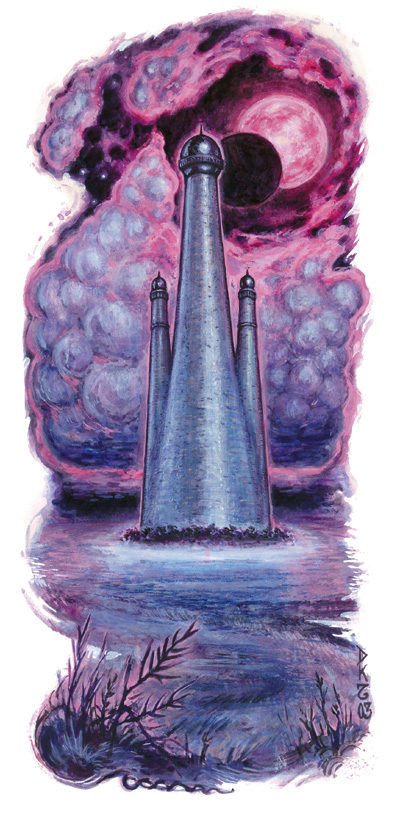
Weis and Hickman decided to work out much of the setting's history ahead of time before penning the first adventure, to give the campaign a "lived-in" sense and to make dungeon crawls a more exciting affair. Foreboding tombs of kings both great and terrible and the ruins of civilizations past are the dungeons of Dragonlance; in addition to monsters to defeat and treasure to acquire, the dungeon's history is written in its broken tablets and decaying homes. Shards of the past might hold great secrets to help propel adventurers in their quest. It advises to reveal information of the dungeon beyond just Knowledge checks, to show it in the tapestries in the boxed text, the legends written in the books of its library, and in its ancient relics.
Afterwards we get a list of known ruins of Ansalon. The more interesting ones include the corrupted Tower of High Sorcery of Palanthas (in the above picture), the Anvil of Time (home to a magical forge which simultaneously exists in all of Krynn's Ages), the underwater ruins of Istar's capital (home to many of its lost glories and now inhabited by sea elves), the magical fortress of Skullcap (home to the evil archwizard Fistandantalus which was partially consumed in a magical blast in the Dwarfgate Wars), and Xak Tsaroth (an old city of Istar present in the first Dragonlance adventure, from there the Heroes discovered the Disks of Mishakal and brought knowledge of the Gods back to the world).
Gods and their Champions
This section talks about how the Gods of Krynn keep a vested interest in the affairs of mortals. Their avatars take the disguises of simple folk, bringing indirect advice to people they believe can help further their interests. Still, the deities do not directly control mortals so much as influence them, by appealing to their better or baser natures. It advises that a god who takes an interest in the PC's affairs to be a rare, unique, and special event, but not to make it overt. Rather sprinkle clues in repeat visitations that the NPC might have more to them than meets the eye. A fighter guarding a pass might be Kiri-Jolith in disguise, challenging those who wish to pass to a non-lethal duel. PCs who react honorably and with grace might find themselves on the path of a Solamnic Knight.
Heroes of Mundane Origin
Most heroes in a Dragonlance campaign are not necessarily born and bred to the role. They often stem from humble origins only to find themselves thrust into some greater fate. They might start out as a blacksmith who must take up arms to defend his village from the Dragonarmies, or a traveling knight might embark to search for signs of the Gods with his childhood friends. They become legends through experience, often starting out with a simple and well-intentioned goal which is the further basis for heroism. That blacksmith might go on to learn the secrets of forging the Dragonlance for the forces of Good, and that knight's example in a climatic battle might bring honor back to his order.
Companions & Friends
The following section recommends that PC groups should be friends and know each other, both to create a shared group history and incentive to adventure together, and for character development. Even the best of friends may not get along, and the hard life of an epic quest can strain these bonds. Childhood friends know that they won't abandon each other in a forlorn dungeon, and a slight or wrong against the individual can earn the enmity of the entire group.
Unfortunately beyond these examples there is little information or advice on how one can practice collaborative character-building. It's often done in other RPG systems, but D&D is prone to having people design characters in a vacuum or by the roles of class. A sample selection of questions, like "how did PC 1 meet PC 2?" or "what secret did PC 2 share with PC 3?" would be a good way of doing this.
Secrets and Shadows of the Past
This section advises that DMs should hand out artifacts and magical items with a great history, especially if it ties into a PC's lineage. Not only does this add interesting dimensions to a character's backstory and ties them to the world of Krynn, it adds some spice to otherwise bland magic items. It suggests not making all of the item's powers known, instead having them be activated or accessed through study, completing a great trial, etc.
Campaign Crafting and Adventure Design
Below is a selection of advice for DMs running a Dragonlance Game:
Memorable Villains:
When creating a villain, make sure that they have good reasons for doing what they're doing. Nobody decides one day to become evil, it is usually a series of events or upbringing which pushes them into it. Also, Lawful Evil villains are more interesting because they're orderly and efficient, and tend to be zealots with overarching visions. Chaotic Evil villains, by contrast, are simple, reckless, and stupid. This is the book speaking, not me. While this may sound biased, 3rd Edition's definition of Chaotic Evil isn't very kind, either, going the Stupid Evil route as well.
The section also recommends giving villains complex personalities and redeeming qualities, as well as a backstory which the PCs might be able to discover and solve over time. It also says that evil people don't necessarily see themselves as being evil (despite there being an Army of Darkness, Gods of Evil, and objective morality in Dragonlance): to an ogre, the elves slaughtering his people are evil. Some of history's greatest villains believed that their actions were of benefit to the world.
This is all rather detailed advice, and seems more fitting for a major villain than an antagonist for a single adventure. The advice for moral relativism ("I'm not really evil!") sort of doesn't gel well with the setting's themes, or what has been established. However, it can oddly work out if you play with some setting tropes, and the books themselves have delved into this. Lord Soth (the archetypical death knight) has expressed regret for his actions but does not have enough faith in himself to move past his own follies. The Dragonarmies killed many people and took over many nations, but the Empire brought order and cohesion to a fractured Ansalon plagued with instability and a loss of magic. The Kingpriest of Istar's alignment has been debated in both the setting and the Dragonlance fandom. I get the feeling that at times Dragonlance has tried to go for a simplistic black and white view while still trying to analyze why evil people act evil. It's been a mixed result at times, as you can tell.
Story Awards in a Dragonlance Campaign:
Remember how in the Key of Destiny Adventure Path I made frequent mention to bonus experience points for good role-playing and acts of heroism? Well, this is where it comes from!
Story Awards is a new set of house rules and bonus avenues for experience point generation in Dragonlance campaigns. PCs can gain experience points for noncombat awards based upon the challenge type: simple, easy, average, formidable, and difficult. There are no hard and fast examples, only guidelines. An easy task might include a rogue climbing up a wall at night and avoiding sentries (doesn't sound easy to me!), while a difficult challenge might be convincing the Knights of Solamnia and Neraka to work together to fight the forces of a Dragon Overlord. A challenge type awards experience points equivalent to an encounter of a Challenge Rating from -2 (simple) to +2 (formidable) of the Average Party Level.
Mission goals are bonus experience in line with the aims of an individual PC or the party at large. They are separated into Personal and Party Goals, and those are separated into Minor and Major Goals. An exiled dwarf proving to the clan elders that he was falsely accused would be a major personal goal, while the discovery of a hidden mountain pathway into the Dragon Overlord's fortress would be a minor party goal. Experience generated depends upon the current amount of experience points generated during the adventure. A minor personal goal is equal to the current total experience divided by 8, major personal goals divided by 6, minor party goals divided by 4, and major personals divided by 2.
Finally we have Roleplaying Awards, where the DM hands out bonus experience points for when a player has a PC act in accordance with their established characterization but which does not result in a favorable outcome for the character. The experience awards earned are separated into mostly favorable (25 exp per level), unfavorable (50 exp per level), and extremely unfavorable (100 exp per level). This reminds me of the Hero Points rule from Mutants & Masterminds where a player gets a spendable token for when things don't go their way or they accomplish something in line with the character. Now handing out experience to get players to role-play is a very metagame concept, but in D&D it acts as a good incentive for them to do so. Since it's a good baseline for noncombat awards, I heartily recommend it.
Oh, and the experience awarded is for the whole party, so everyone benefits!
Next section details the languages of Ansalon. It's got the Common tongue, which is a trade language. The predominant human tongues are Abanasinian (spoken in the nation of the same name), Camptalk (mercenary slang), Ergot (Ergothians), Kalinese (Blood Sea Isles), Kharolian (Tarsis, Plains of Dust, Kharolis), Khur (Khur people), Nerakese (Nerakans), Nordmaarian (same nation), Saifhum (Saifhum island), and Solamnic (Solamnia). There is no giant language, instead being Ogre (and its long-dead High Ogre precursor), and Gnome is just Common but with highly-technical sciencespeak which might as well be a new language. Minotaurs speak Kothian, Kender Kenderspeak, Dwarves and Elves have the language of the same name, but Gully Dwarves have Gullytalk (a rapidly evolving language which takes words and dialect from all kinds of cultures) and the sea elves have their own languages (Dargonesti and Dimernesti). Dargoi is a generic trade tongue for underwater cultures, while Draconic is the only living language.
Also, all Wizards speak Magius, a spidery language which magical research notes and spellbooks are often written, and whose spoken form is used as verbal components for spells.
We get to
Coinage,
which mentions that gold fell out of use during the Age of Despair, where the loss of Istar and the Gods made the world a more savage and cruel place. Steel became the valued metal, and steel pieces the standard currency of Krynn. A steel piece is equivalent to one gold piece in other D&D settings, but copper pieces retain their base value. Gold pieces in Ansalson are worth 1/40th of a steel piece, silver 1/20th (why silver's more valuable than gold, I don't know. Lycanthropes, maybe). Platinum pieces are worth 5 steel pieces, and iron/bronze pieces are worth 1/2th a steel piece.
The River of Time
Our final section details the names of the hours, days, and months of Krynn, as well as a timeline of history.
Basically there are 24 hours in a day, 7 days to a week, 365 days to a year, and 12 months, just like our world. But they all have different names upon the racial and national cultures of Ansalon. The first month is known as Aelmont to Ergothians, Winter Night to the Elves, Snowfun to the Kender, and Famine to the Goblins. There is also a deity associated with each month.
Normally I'd post the tables from the core book, but seeing as how I had computer problems and lost my earlier material,
I'll instead provide a link at the Dragonlance Nexus.
Also, the hours of the day were developed by the city watch of Palanthas, based upon their watches. Midnight is Darkwatch, 6 AM is Morning Watch, 12 PM (lunchtime) is High Watch, etc.
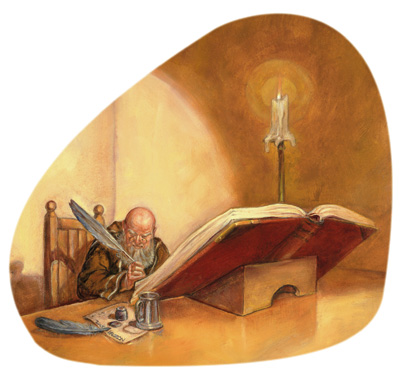
Dragonlance has a large timeline of Five Ages; instead of listing each event, I'll do an abbreviation of the major events here:
The world's history is divided into Five Ages by scholars. The
Age of Starbirth
was before the rise of civilization, beginning with a conclave of primordial entities known as deities working together to create the world of Krynn. During this era the spirits are given physical forms, creating the first dragons, elves, ogres, and humans. The Gods of Light grant them the ability to enjoy life's pleasures, the Gods of Darkness ambition and desire, and the Gods of Balance free will.
The
Age of Dreams
details the beginning of recorded mortal history, and sees the rise of the earliest civilizations. Lots of stuff happens in this era. Ogres, elves, and humans founded the first civilizations; the Graygem of Gargath (housing Chaos' essence) is cracked and unleashes wild magic into the world, resulting in the creation of many new monsters and races; elves war with dragons in the First and Second Dragon Wars, and the first mages use their magic against the serpents. The horrific loss of life from unrestrained magic leads to them forming the Order of High Sorcery, to act as a stewardship and regulator of those gifted with arcane magic to ensure Ansalon's safety. Takhisis attempts to conquer the continent with an army of dragons during the Third Dragon War, but is banished from Krynn by the legendary knight Huma Dragonbane and the silver dragon Heart.
The
Age of Might
sees the rise of the human nation of Istar, protected by the clerics of Paladine during the Third Dragon War. The elven nations impose an isolationist policy, while the dwarves forge underground kingdoms and war with the ogres. Istar becomes a theocracy and Ansalon's major power. In the Kingpriests' zeal to wipe out Evil, the church enacts increasingly oppressive measures, from enslaving "evil" races to outlawing arcane magic and worship of the Gods of Balance, and even managing an order of mind-reading inquisitors to punish those thinking evil thoughts. The Gods of Light become increasingly disgusted with this state of affairs, withdrawing their divine aid and spells, but they do not change. Eventually the Kingpriest views the Gods themselves as tolerating evil and sets forth on a magical ritual to ascend to godhood himself. Paladine sends thirteen prophetic warnings to the people of Istar, all of which are mistaken as the work of Evil. Istar's crimes are punished when the Gods of Light send a meteor down upon their capital city. Landmasses are torn asunder, freak weather spreads across the continent, innumerable lives are lost, and all the Gods withdraw their affairs from the world. This horrific tragedy becomes known as the Cataclysm.
The effects of the Cataclysm are felt for nearly four centuries in an era known as the
Age of Despair.
The Empire fractures into independent nation-states, plague and famine is endemic, governments and infrastructures disintegrate, banditry is rampant, and starvation among the dwarven nations leads to the Dwarfgate War as a significant portion of the above-ground population is denied entry into the nation, as food supplies are low. These exiled dwarves are now known as the Neidar (Nearest), or hill dwarves.
Takhisis brings the sunken temple of Istar to the surface and uses its Foundation Stone as a divine conduit to the world. As it is not whole, she cannot manifest on Krynn. She is the first deity to bring divine magic to mortals in this era, and her forces bring law and order to significant sections of eastern Ansalon under the banner of the Dragon Empire. Supplemented by magic, monsters, and dragons, they become an international power and set about conquering the rest of the continent. This event, which comes to be known as the War of the Lance, is part of the original Dragonlance Chronicles. The Heroes of the Lance bring knowledge of the Gods of Light and Balance back to Krynn and discover the secrets to forging the mighty Dragonlances. Eventually the Heroes lead an army against the Empire, kill Emperor Ariakas, and prevent Takhisis' summoning into the world.
The Empire dissolves, but the Blue Dragonarmy manages to hold onto a significant portion of territory. Ariakas' son creates an order known as the Knights of Takhisis and begin conquering much of Ansalon. The Irda ogres break open the Graygem of Gargath in desperation, unleashing Chaos into the world. Forces of good and evil alike are destroyed the primordial gods' spawned minions, and they unite against the monsters in an event known as the Chaos War. Eventually Chaos is banished from Krynn, and Takhisis moves the Material Plane away amid the confusion. Now she is the only deity with a connection to Krynn, beginning the Age of Mortals.
The
Age of Mortals
sees the absence of divine and arcane spellcasting, now that the Gods are gone. New forms of magic are discovered after Chaos' release, which draw upon one's inner power. They are primal sorcery and mysticism, respectively. No longer are mortals dependent upon deities for magic. Five titanic dragons from a neighboring plane enter Krynn and begin conquering significant sections of it. Takhisis takes the form of the One God and instills her power in a mortal named Mina, who joins the Dark Knights as a cleric and leads their forces against the Dragon Overlords and kills two of them with the aid of divine magic and a dragonlance. Raistlin Majere uses a time-traveling device to form a link to Krynn and help the Gods return. They strip Takhisis of her divinity, making her mortal, but so too to Paladine to keep the Balance. Takhisis attempts to kill Mina in anger but is killed by an elf in love with Mina. Mina takes the goddess' corpse in her arms and leaves, swearing vengeance upon the elven race. Clerical and wizardly magic return to the world (although primal sorcery and mysticism still remain), and only two Dragon Overlords yet live.
Yeah, it's a repost from my Dragonlance 101 section from Key of Destiny, but it's a good and useful one.
Thoughts so far:
This section of the book is more a series of generic information of varying quality and miscellaneous stuff which doesn't fit into the other chapters. Still, it's Story Awards system is top-notch, one surprisingly absent from many other D20 products during and after its time. It's really the only "non-combat experience" house rule I've seen which isn't entirely ad hoc by DM Fiat.
Next time, Chapter 7, Creatures of Ansalon!
Creatures of Ansalon
Original SA post
Dragonlance Campaign Setting Part 7: Creatures of Ansalon
This details the new monsters of the setting. Before we get into that, we have a list of creatures not suitable/native to Ansalon: driders, drow elves, halflings, lycanthropes (those three moons will drive'em crazy!), mind flayers, orcs and half-orcs, and titans. Otherwise the Monster Manual creatures can be used pretty freely.
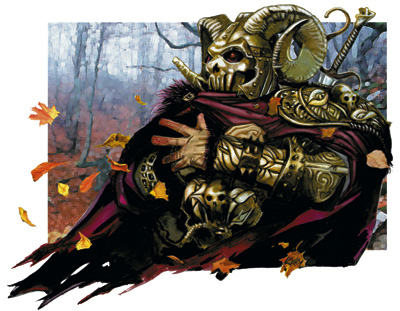
Our first entry's the Death Knight. Lord Soth serves as the most famous example of their kind. Basically, death knights were once champions of a god, usually one of the Gods of Light, before committing some horrible crime and being transformed into an undead warrior by the evil deities. Only a few death knights have existed in Krynn's history, with most being Knights of Solamnia.
Mechanics-wise, a Death Knight is a template which makes you undead, grants a negative energy touch attack, an Abyssal Blast (a ranged area of effect fire attack), can transform dead humanoids into skeletal warriors (new monster template), access to spell-like abilities related to pain and offense, spell resistance and the ability to see invisible creatures, and can summon undead mount and a legion of undead followers.
This template's a pretty good power boost: you get minions, a ranged attack, undead benefits, and an assortment of magical attacks. It grants a +3 to +5 CR (depending on Hit Dice) and a +5 Level Adjustment.
Next up we have the Draconians!
As a race, draconians of all varieties are of the Dragon type, are immune to all diseases, gain +1 morale bonus on saves/attacks/skills when serving under a chromatic dragon leader, have Spell Resistance which scales with Hit Dice (the higher CR ones have better values), and can survive on 1/10th the food and water of a regular human. All but the Aurak have wings which can grant limited flight in the form of gliding. All of them also have their own death throes.
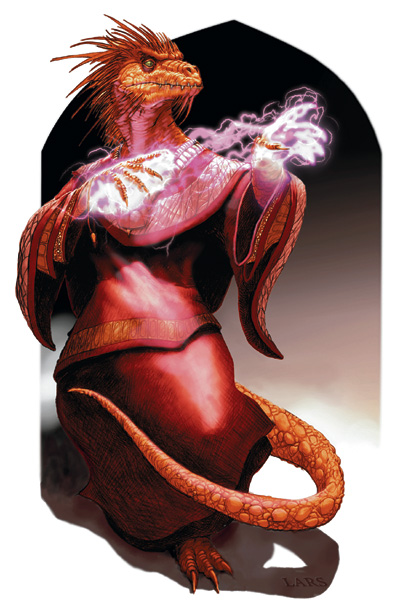
Aurak Draconians are created from Gold Dragon eggs, and are superb arcane spellcasters (they make for natural sorcerers). An aurak isn't very impressive physically, but they can fire energy rays (supernatural abilities which can be used infinitely) as ranged touch attacks, cast spells as 8th-level sorcerers, and 3 times per day each can cast disguise self, dimension door, or polymorph (small or medium animal only) as spell-like abilities. They can also use greater invisibility at will. Their breath weapon is a cone of noxious gas which saps strength, and their death throes are an explosion of magical energy. They're Challenge Rating 9, and quite suited to infiltration and stealth roles (mechanics-wise, the fluff text doesn't veer this way).
Baaz:
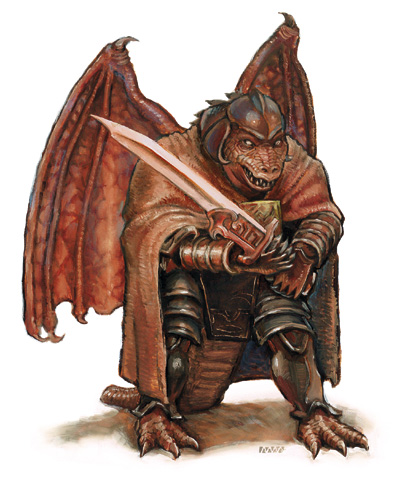
Kapak:

We also have stat blocks for Baaz and Kapak with no class levels, but there's nothing I haven't already covered in their racial entries way back in Chapter 1.
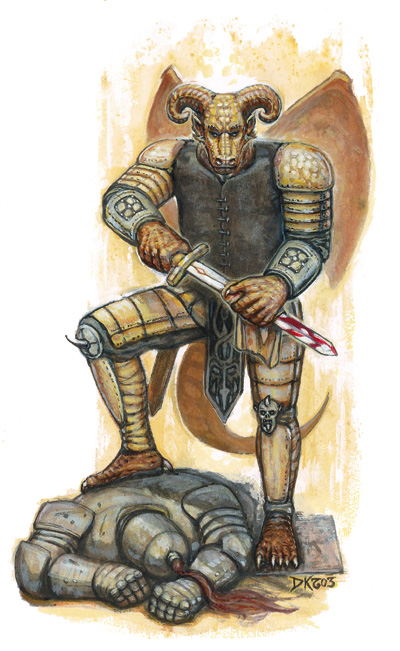
Bozak Draconians are created from bronze dragon eggs. They traditionally served as spellcasting officers in the Dragonarmies, naturally coming to primal sorcery. They are devoutly religious, serving Takhisis when she was still alive, and pursue divine spellcasting as well. Mechanics-wise they don't have much other than a big natural armor bonus (+8) and the ability to cast spells as a 4th-level sorcerer. Their death throes involve their body's skin crumbling to dust, revealing their bones which shortly explode. They are Challenge Rating 5, but their stats are pretty weak for this level of power.
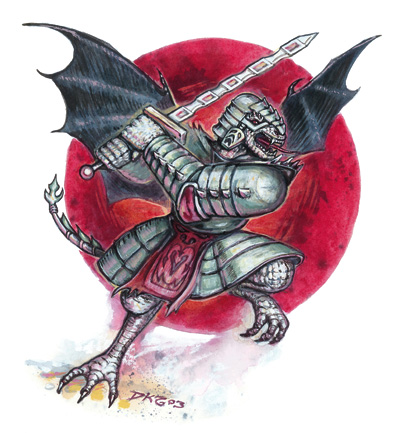
Sivak Draconians are the largest of the Draconians, clocking in at 8 1/2 to 9 feet tall. They served as infiltrators in the Dragonarmies due to their natural shapeshifting ability, and their natural strength and size made them excellent shock troopers in battle, and were naturally the leaders of draconian military units without aurak officers. Mechanics-wise Sivak are the only ones with true flight (60 feet poor maneuverability), have a tail attack which can trip opponents. A male sivak can assume the form of a large or smaller humanoid that it has just killed and can remain in the form indefinitely (but if they switch back they cannot assume that form again), while the females have natural camouflage (granting +10 on Hide checks). In the case of death throes, a male sivak's corpse takes the form of his killer before decomposing into black soot after 3 days (if the killer isn't humanoid then it bursts into flames). A female sivak's death throes just burst into flames.
The Sivak is Challenge Rating 6, and it's not really as strong as other creatures its size (Strength 16), but its natural flight is a nice addition. It can't hit as hard as a hill giant, and its melee attacks are rather weak. As far as draconians go only the aurak is really a match for its Challenge Rating.
There's no art for the Dragonspawn, sadly. These creatures are humanoids who've been warped into dragon-like monstrosities by the Dragon Overlords by infusing them with the mind and soul of a draconian. Regardless of the draconian used, dragonspawn take on the physical traits of their Overlord, such as colored scales, reptilian eyes, and other alterations. Mechanics-wise it is a template which can be added to a humanoid, monstrous humanoid, or giant from small to large size. They gain a fly speed, natural weapons (bite and claws), a breath weapon in line with its Overlord creator, and unique death throes which are explosions which deal the same type of energy damage. All of them can also cast spells as 1st-level sorcerers, which stack with existing sorcerer levels. They also gain widely varying bonuses to their ability scores depending upon the Overlord (white dragonspawn gain a piddly +2 Strength and Constitution, while the mighty Reds gain +8 Strength, +6 Constitution, +4 Charisma, and +2 everything else). It grants +1 to +3 Challenge Rating based upon the Overlord (from weakest to strongest type of dragon).
Overall Dragonspawn is a powerful template to add: flight, minor spellcasting, a breath weapon, and potentially big bonuses to ability scores is a nice package for most monsters.
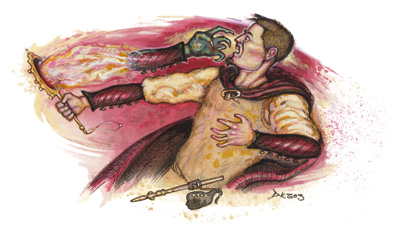
Fetches are evil outsiders from the Abyss which can only enter Krynn via reflective surfaces such as mirrors and ponds. In their natural forms they are black shadows which are nevertheless solid, and their very touch can drain energy (touch attack which deals 1d4 damage and 2 negative levels). They are also invisible and can only be seen by their intended victim (they usually hunt specific targets), and even then only in a reflective surface. They can also create more of their kind if they kill someone with their energy drain and take its corpse back to the Abyss. They can also create two-way portals between the planes in reflective surfaces (functions as a gate spell) which they can see and hear through. They are Challenge Rating 6 and do not have much going for them aside from their special qualities.
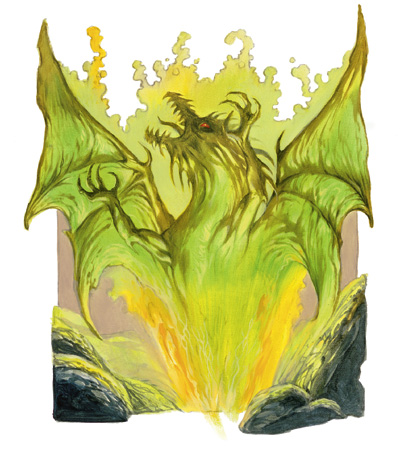
Fireshadows are also Abyssal denizens, except that they're undead and usually summoned into the Material Plane by evil spellcasters. They can take a variety of forms, but are always at least 30 feet tall and surrounded by green fire. Their mundane combat capabilities aren't very impressive (AC 20, natural attacks +9 to hit on average), but they are surrounded by a 10 foot radius of burning green flame which extends to their natural attacks, and deals fire damage and constitution damage every round as the flames slowly consume them (halted by holy water or a cure spell). A fireshadow can also shoot out an invisible Ray of Oblivion every 1d4 rounds which deals a massive amount of damage (13d6) and disintegrates creatures reduced to 0 hit points by it. Fireshadows also take damage in sunlight and have their actions slowed. It's Challenge Rating 10. The creature's rather underwhelming for its CR, with a small assortment of offensive capabilities going for it.
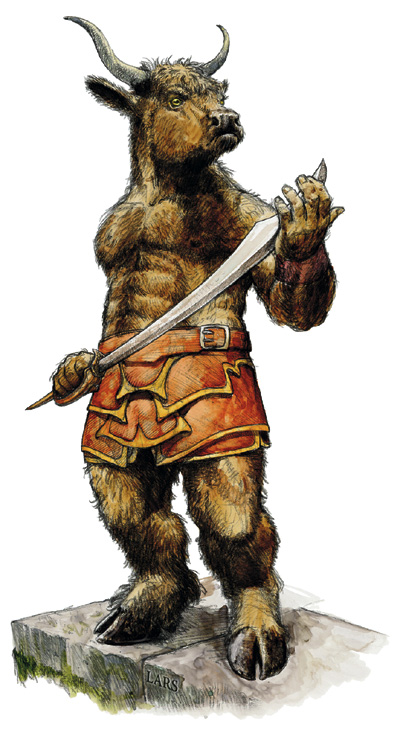
We also have a 1st-level Minotaur warrior statblock, which tells a little more of their society: most of them compete annually in the great Circus to prove their worth, their society is gender-egalitarian, a few rebellious ones worship Kiri-Jolith, and they enjoy art and leisurely activities once in a while.
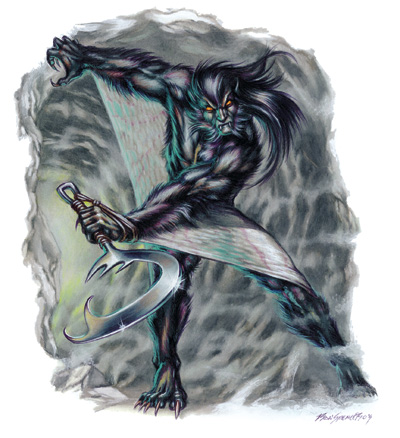
A shadowperson is a member of a reclusive race of underground folk in small, self-contained communities. They are mostly good-aligned and their kinds' existence is almost unknown by the other civilizations of Krynn (and they'd prefer to keep it that way). Their society is very communal, with the entire clan taking care of the young. They have two social roles for adults who came of age: the warrior caste or the counselor caste (spiritual advisors) depending upon their capabilities. Each clans' cave is located near vents with fresh water and air (and lave to dispose of refuse).
Mechanics-wise they are monstrous humanoids supernatural insight (+6 insight bonus to armor class, telepathy, constant detect thoughts, blindsense 30 feet) and can perform an hour-long ritual known as the mindweave which allows them to fight in perfect unison (+1 on attacks/saves/skills). They also have membrane between their limbs which grants limited flight, and wield shadowstaves as martial weapons (curved weapons which can hook into an opponents' flesh and deal continual weapon damage). Additionally, shadowpeople communities are led by disembodied entities known as the Revered Ancient One (one for each community), which is a disembodied entity which can cast cure serious wounds, greater teleport, legend lore, wall of force, and detect thoughts at will.
Shadowpeople are Challenge Rating 3.
These are my one of my favorite entries, if only because they're so unorthodox for Dungeons & Dragons. Good-aligned monstrous humanoids with telepathy-enhanced fighting abilities? Count me in!
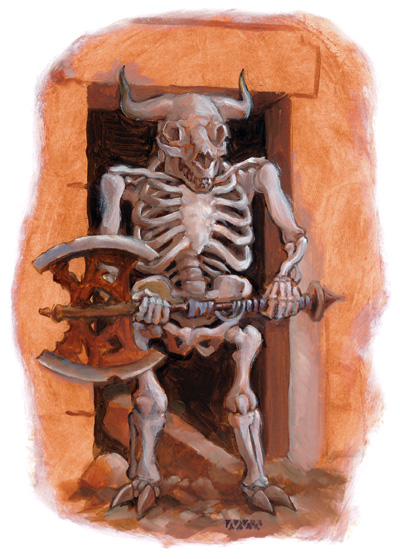
Skeletal Warriors are dangerous combatants forced to continue fighting after death. They are created by death knights who house the undead's souls in a golden circlet to command them to do their bidding. Mechanics-wise they have a lot of the typical skeleton traits, but are proficient with all martial weapons, have a negative energy touch attack, spell resistance (13 + character level), and are not mindless (retain mental ability scores). They add +1 CR to the existing creature. A pretty nice undead minion, too bad only death knights can make them.
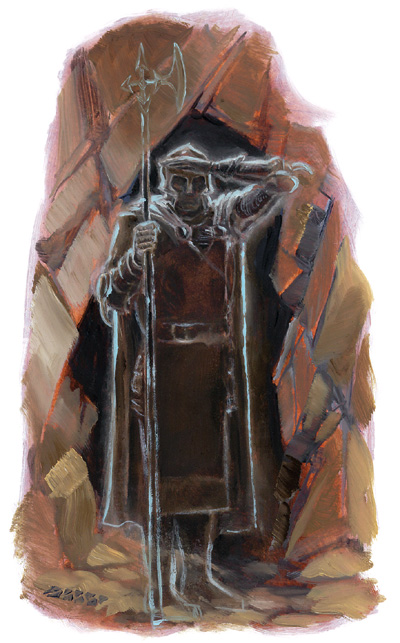
A Spectral Minion is the soul of an intelligent humanoid who died before they could fulfill an important vow and are bound to complete their duties even in death. They appear as they did in life, only more transparent, and possess all of their memories from their living days. However, the desire to fulfill their oaths dominates their mind, being the only thing preventing them from moving on in the River of Souls. Mechanics-wise they are incorporeal undead template, an incorporeal version of any weapons they possessed at the end of their life, spell resistance (12 + character level) and immunity to turn and rebuke undead. They lose any ability to cast spells or spell-like abilities if they had those qualities in life, and cannot attack unless they have an incorporeal weapon. They gain a +1 to their Challenge Rating, which doesn't make sense; if anything they lose far more in terms of combat potential and gain relatively little. They're also one of the few undead who can be of non-evil alignment.
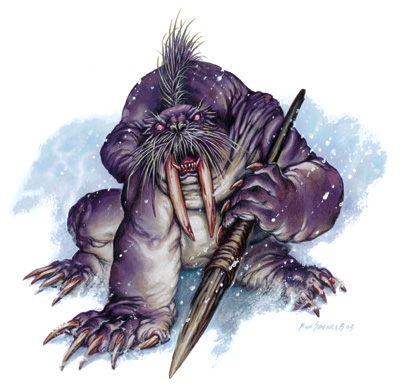
Tarmak are humans from a continent far to the east. They were recruited by the Knights of Neraka during the early 5th Age to help them conquer Ansalon. Tarmak have a complex, gutteral language and spellcasters among their number are unknown. In battle they decorate their skin in war paint which grants +5 natural armor and Fast Healing 5 (stops working once it's absorbed 20 points of damage). The war paint is alchemical and completely non-magical in nature (not sold, but has an effective cost of 500 gp and DC 25 Craft check to create). The text also makes mention of a tarmak leader stat block of a 5th-level barbarian, but it's mysteriously absent (editing error, I bet).
Rounding out our monster chapter are the Thanoi. A race of walrus people native to the far south of Ansalon, thanoi live a subsistence lifestyle and frequently war with each other and the Ice Folk. Ones with class levels are almost always barbarians, but a rare few females become kagogs (medicine givers) and have levels in Cleric or Mystic. Mechanics-wise they are monstrous humanoids who can swim (40 feet) and hold their breaths for a long time (30 minutes before making Constitution checks for drowning), have the Cold subtype, and are pretty heavy hitters with melee weapons (+7 with greatclub, 1d10+3 damage). They are Challenge Rating 2.
Thoughts so far: More than a few of the monsters' Challenge Ratings are a little off, but overall I liked the assortment of new monsters for Krynn. The draconians in particular are pretty cool, and the Death Knight template is perfect for a major NPC villain.
Next time, Chapter 8: Dragons of Krynn! That's right, dragons are so special that they get their own chapter!
Dragons of Krynn
Original SA post
Dragonlance Campaign Setting Part 8: Dragons of Krynn
Dragons are the oldest and grandest children of Krynn, formed during the Age of Starbirth from the world's elemental forces. Strongly aligned with either Good or Evil, as a race they have a history of meddling in the affairs of Krynn's people.
Chromatic Dragons
The chromatic dragons were once metallic (I can't find information on their original metals) and good-aligned children of Paladine, but Takhisis' corruption changed them. Throughout the Five Ages they've fought for Takhisis, who favored them higher than any other servants. As a whole they've often fought together in the three Dragon Wars and the War of the Lance.
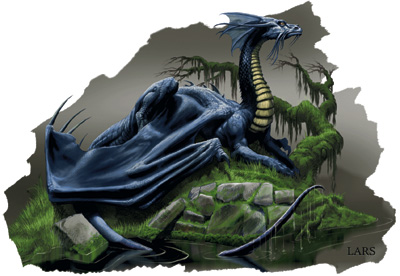
Black Dragons are socially isolated misanthropes who distrust everyone else who's not a black dragon. They prefer to live and fight in the swamps, for it provides plenty of concealment and is difficult to maneuver in for most creatures. They are not very fond of Takhisis, traditionally only serving her for fear of disobeying her, and even she did not really trust them. During the War of the Lance they were assigned roles which required little social interaction, such as guarding artifacts.
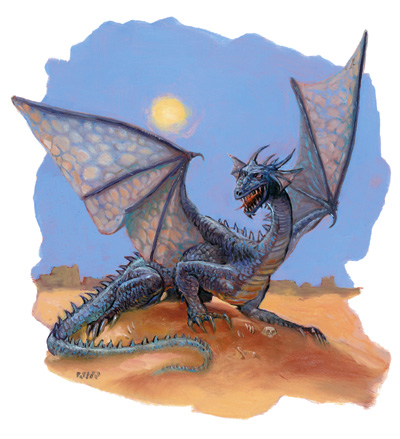
Blue Dragons are much more sociable than black dragons, and get along relatively well with humanoids who can prove their worth to them. They proudly served Takhisis throughout the ages, and even mourned the loss of dragonriders they bonded with in battle. However, to earn a blue dragon's respect is no mean feat, requiring tactical acumen and fearlessness. They adapt well to military life, and are very loyal to their mates, even going so far as to dedicate their lives to avenging the death of their mate's slayer.
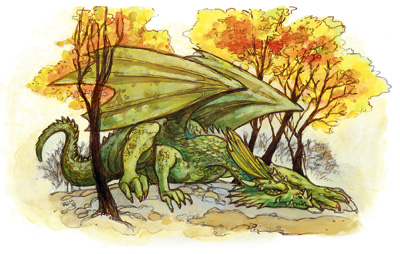
Green Dragons are incredibly arrogant who traditionally live in forests and don't work for others unless they can benefit materially from the arrangement. They prefer toying with their enemies, hoping to keep them alive to torture later, and have no compunctions with retreating as soon as the tide turns against them. They claim to be Takhisis' favorites and shower her with false praise, but in private they hate her (it's not explained why).
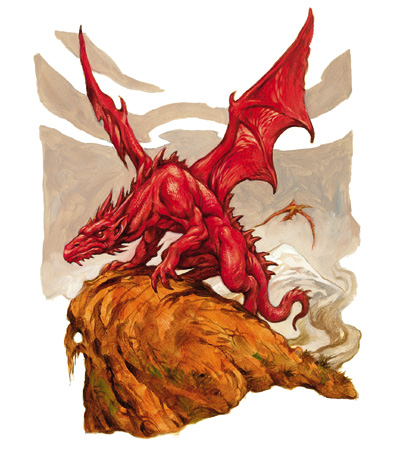
Red Dragons are the most feared dragons (and creatures) of Krynn. Their physical strength stands above all other dragons except the Gold, and they're skilled in magic. Their fire breaths can easily spread and lay waste to entire cities, and they have a fine grasp of military tactics. They are zealous followers of Takhisis and gladly cooperated with the Dragonarmies during the War of the Lance in spite of their otherwise solitary natures. They can also take humanoid form, and as such they have the greatest understanding of humanoids, being able to move among them unseen.
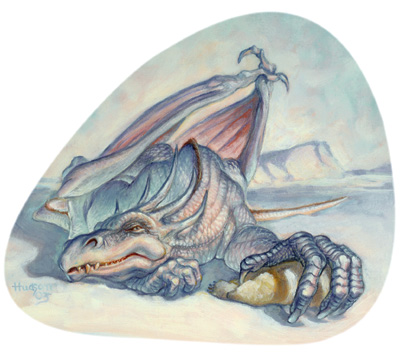
White Dragons are the most rare and reclusive of the chromatic dragons, sticking to the Icewall region of southern Ansalon. They have almost no interest in world affairs and are very anti-social, making them of limited use in military campaigns. During the War of the Lance the extent of their roles were as scouts and to guard the Icewall region against attack. Additionally, they hate the sunlight, and being exposed to it and warm temperatures over a prolonged period causes them to sicken and die (this is not reflected in game statistics, just flavor text).
Metallic Dragons
The good-aligned dragons revere the deities of Good and traditionally helped maintain the balance by preventing Evil from ruling the world. When Huma drove Takhisis from the world during the Third Dragon War, Paladine ordered the metallic dragons to depart the continent of Ansalon to maintain the balance. They fell into a long sleep on the Dragon Isles, and during the Age of Despair Takhisis' agents stole their eggs. Around this time the dragons woke up to discover them missing, and Takhisis promised that their children would come to no harm if they took no part in the coming war of Ansalon. They had no choice but to agree. However, some dragons could not abide as the Dark Queen's armies tore Ansalon apart in the War of the Lance, and Silvara helped bring back knowledge of the fabled dragonlances back into the world, and helped the Heroes of the Lance discover the true fate of the good dragon eggs. Upon hearing that their children were being warped into draconian soldiers, they entered the war with a vengeance and allied with the Whitestone forces against the Dragon Empire.
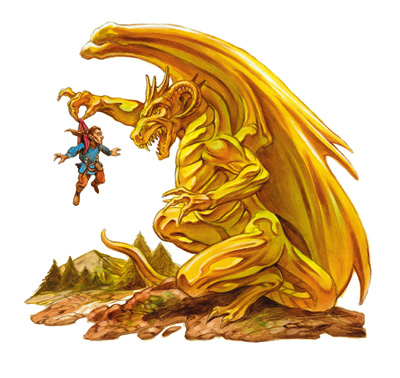
Brass Dragons love nothing better than to hear themselves talk, and can carry on conversations for hours on all manner of subjects. They'd almost rather talk than eat, and even pursue this habit into combat. They are fluent in most languages and reward those who teach them new ones. They do not revere any of the deities, and aren't very good at listening to others or taking orders. They live in the same general terrain as blue dragons (desert), and the two are mortal enemies.
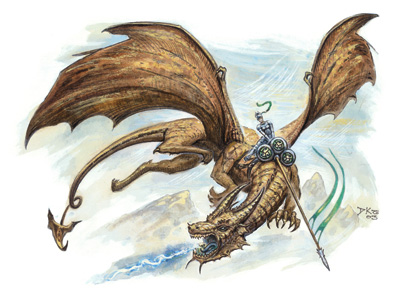
Bronze Dragons take in active interest in the affairs of humanoids and often integrate into their societies by taking the form of domestic pets. They go out of their way to avoid harming and killing animals and often confound the efforts of hunters, poachers, and butchers to trap and kill the animals. Oddly, they have an extreme interest in warfare and battle, studying military history of ancient battles and modern drilling instructions. They served admirably on the side of Good in the War of the Lance and earlier Dragon Wars, eagerly carrying dragonriders into battle and obeying orders from trusted humanoid commanders (and giving advice to military strategists as well).
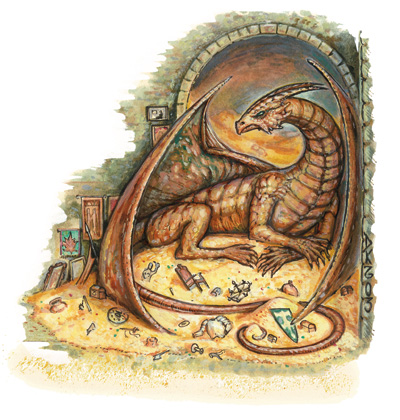
Copper Dragons are overall good-natured, but have the tendency to be collect and hoard wealth. They often approach situations or offers of help by asking what's in it for them, or by demanding financial compensation to those they help even when it was not asked for.
Personally this sounds less good-natured and more selfish to me. They do not participate in evil deeds, though, no matter how much wealth is to be gained. Copper dragons are fond of jokes, pranks, and tricks which they eagerly play on travelers, and grow annoyed when people don't find their antics amusing.
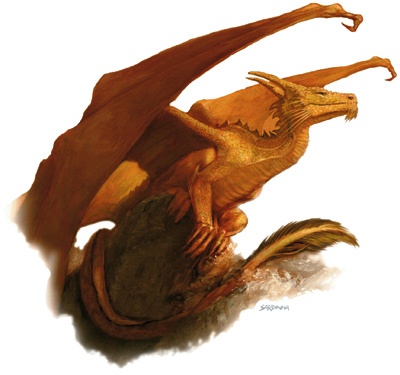
Gold Dragons are the most intelligent, powerful, and magically-inclined of all dragons. They are defenders of justice and fight for those unable to defend themselves. They only kill when there is no other option available, using restraint in all their actions. They can change into humanoid form, but rarely do so due to the form's relative fragility. They make their lairs anywhere and in any climate, and have been known to re-appropriate humanoid castles and fortresses once home to evildoers (which they either killed or drove off). They eagerly help people seeking their aid if the cause is just, but often use divination magic to ensure that people don't try to trick them.
With their doing good deeds for free and a code against killing except in the direst of circumstances, they're pretty much the Supermen of dragons.
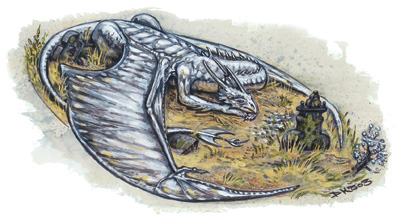
Silver Dragons are the most beloved and accessible of all the dragons on Krynn. They are fond of taking humanoid forms, particularly of humans and elves. Sometimes they even live among humanoid communities for years, even falling in love with them. They are not aggressive, but are willing to fight for just causes and get along well with dragonriders and the Knights of Solamnia, as the legend of Human and his silver dragon ally is well-known to both peoples. When it comes to battle, they prefer hiding in the clouds, then swooping down upon unaware opponents.
We also get a brief description of Dragon Overlords, who are basically titanic great wyrm dragons from an unknown plane. They are capable of building skull totems fashioned from the bones of other dragons, which they use to absorb their power and gain virtual age categories and Hit Dice. Dragon Overlords are capable of (and have) grown to hundreds of feet in length, looking like titanic beefed-up monsters of a dragon.
Aerial Combat
The second half of this chapter is devoted to aerial combat. Dragonlance is famous for this, and any campaign in it which doesn't involve the PCs riding into battle on dragonback are doing it wrong. Basically it's a sub-system of new rules to handle the complications of flying combat. Basically it's only used when the fly speed of opponents is fast enough (more than 60 feet) and most of the opponents in the combat are flying in an open-air space. Otherwise one uses normal scale.
In aerial combat, there is a normal scale (mentioned above) and chase scale, where one square equals 30 feet instead of 5 feet. To determine how many squares a creature can move in this square, divided its speed by 30 (round down). So a fly speed of 60 is 2 squares, 100 feet is 3 squares, etc.
Flying creatures who take off from the ground determine they altitude they gain in the round by a Jump check modified by their fly speed (basically +4 for every 10 feet of speed), and the creature is not penalized if they do not have a running start. The altitude at take-off is based upon their size category and and result of the check. They also must make a move action when landing, otherwise they crash-land and suffer some falling damage.
Additionally, most creatures (ones without perfect maneuverability) have their heads facing in the direction that they're flying, meaning that squares directly behind it are its "blind spot" and enemies don't provoke attacks of opportunity when moving through these squares. Mounted riders are exempt from this and can attack them normally.
Also, the faster one flies in a round the harder it is to perform some actions (hovering, landing safely, turning). A creature moving at half to normal speed can only perform a standard action, while flying double allows for only charge and dive attacks (as they're techincally running and doing a full-round action). Not that different than ground speed, honestly.
Creatures without good or perfect maneuverability must move at least half their fly speed in a round while in mid-air, or they enter into freefall. During a freefall, one descends at a rate of 600 feet per round.
There are also maneuvers a flying creature can take, which are free actions performed as part of a move action. A creature is limited by how many maneuvers it can perform per turn (a physical act of turning around in flight, which can take some time) based upon its speed. Maneuvers are different than a creature's maneuverability rating (clumsy, poor, average, etc), and the two do not interact. This is just to clear up confusion.
Maneuvers are simple and advanced. Advanced maneuvers count as 2 maneuvers used. Simple maneuvers include 45 degree turns, diving, "climbing" higher into the air, and performing a slide-slip maneuver where they dodge to the side without turning around completely. Advanced maneuvers include stuff like ramming into enemies, really tight turns, recover out of a freefall, performing a sudden stop (airbrake), and similar stuff. Advanced maneuvers require a Dexterity check by the creature, or they can substitute a mounted character's Ride check in their place (a good incentive for humanoid riders if I've seen any).
We also have an abstract "altitude" system which determines the effective range for attacks when aerial and ground-bound opponents fight each other. Altitudes range from 0 to 6. 0 is where you're practically on top of each other and can do melee. 1 is very low, where all spells, melee, thrown and ranged weapons are effective. 2 eliminates the use of melee and thrown weapons and short-range spells, 3 elimates cone-shaped breath weapons, 4 eliminates medium-ranged spells and all breath weapons, 5 eliminates all but long-range spells, and at 6 no attacks are possible. A rather good abstraction to use for on-the-fly stuff, but it's at odds with 3.X's reliance on battle grids and range increments.
Next section goes over existing PHB rules about aerial combat, while the final section details collision damage when flying creatures ram into each other or solid objects. Basically the damage die type is determined by the collider's speed (or the higher of the two), and the size category of the smallest creature or object. Ones smaller than Tiny deal no damage at all. For example, a Huge brass dragon flying at 120 feet (d8 die) ramming into a stationary Large Red Dragon (8 die) deals 8d8 damage to itself and the red dragon. The struck creature immediately enters freefall, so it can be a good way of dealing potentially a lot of falling damage if you're willing to take a few lumps yourself.
Thoughts so far: I like the write-ups on the dragon types. I feel that they are a little too similar in parts to the Monster Manual entries, but I enjoyed the explanations of how dragonkind performed in warfare historically. As for the Aerial Combat rules, I feel that they can be too much for an already-complicated game system, and I can see more than a few groups avoid taking to the skies to speed the game up. But the maneuvers and chase scale can be useful for open-air combat, and it is thematic to the Dragonlance experience.
Next time, Chapter 9: Other Eras of Play!
Other Eras of Play
Original SA post
Dragonlance Campaign Setting Part 9: Other Eras of Play
This is the last chapter of the Dragonlance Campaign Setting. After that we have a short appendix containing two adventures, one of which I already covered in the Key of Destiny Adventure Path. This chapter covers two historical eras in Dragonlance: the War of the Lance, during which the original 1984 Chronicles and modules were set, and the Early Age of Mortals, when the Dragon Overlords first came to Krynn and the gods fell silent again.
War of the Lance
As detailed in Krynn's history in Chapter 6, the War of the Lance was a 4 year conflict when Takhisis' Dragonarmies set about conquering much of Ansalon, aided by the might of chromatic dragons and the goddesses' priests. The Heroes of the Lance, originally a group of 8 friends reuniting at the Inn of the Last Home, played a vital role in saving Ansalon from the Dark Queen's forces. They helped restore knowledge of the Gods of Light and Balance with the discovery of the Disks of Mishakal, learned how to forge the legendary Dragonlances and united the forces of Good on Krynn under the Whitestone Council, unearthed the deadly secret of the draconians' creation and convinced the metallic dragons to enter into the war, and destroyed the temple of Takhisis in Neraka and killed Emperor Ariakas.
Games set during the War of the Lance are a different affair than the default 5th Age. For one, most of Krynn around this time does not follow any of the Gods, Takhisis' forces notwithstanding. The Wizards of High Sorcery still receive aid from the Gods of Magic, but otherwise the deities are silent, and the Wizards don't go around telling people that they gain their magic with the help of the gods. There is still much resentment over the Cataclysm, when they tossed a giant meteor onto Istar and wrought much death and destruction onto the continent. The Gods of Darkness return first to the world, but they are secretive and trust their aid to a select few clerics. Takhisis is the exception, as she begins recruiting humanoids and monsters to Neraka via divine guidance, to eventually form the Dragonarmies.
We get a detailed write-up of how each of the deities interacts with the world when they return to it. The evil ones had a 200-year head start, with the rest coming very recently (at the beginning of the War of the Lance). Branchala gives his spells to clerics with a knack for music and travel, and directed them to help combat Lorac's Nightmare, the force which is destroying Silvanesti. Habbukuk set about gathering clerics and druids to help heal nature and communities afflicted by the wars. Kiri-Jolith's faithful joined the Knights of Solamnia and helped the Order of the Sword reconnect with the deity. Majere's worship and knowledge was preserved in a few Ergothian monasteries, even if he did not grant spells, so it wasn't hard for them to recover. Mishakal first came when Goldmoon, a Hero of the Lance and daughter of an Abasinian Plains chieftian, discovered the Disks of Mishakal and helped spread the word of the Gods' return to the world along with Elistan. Paladine was instrumental in the spread of knowledge as well, often taking the form of a senile wizard named Fizban to subtly help out the Heroes of the Lance and others to help defeat the Dragonarmies. Solinari foresaw the coming war and instructed the head of the White Robes to find a "sword," or wizardly pupil to train, to help fight the evil. That sword was Raistlin, a Hero of the Lance.
For the deities of Neutrality, there's not really much that hasn't already been said, other than that Lunitari guided Raistlin into joining the Red Robes, Reorx was still worshiped by dwarves (although a lot of it was for show before the War), and Shinare's faith rose quickly during the war.
For the deities of evil, Chemosh's faith flourished in hopeless people willing to do anything to avoid death in this miserable Age, Hiddukel's priests quietly kept to the north, Morgion gained a following among the Zhakar dwarves who hoped that he could cure their fungal plague. As for Nuitari, the Black Robes were traditionally enemies of Takhisis' faithful, but they entered into an alliance with the Dragonarmies and helped them form the ritual to create draconians and flying citadels (airborne castles carrying troops which attack cities from the air) for military dominance. Takhisis, of course, had her faith grow exponentially with the power of the Dragonarmies. Zeboim's faith is small and secret, by fearful sailors placating her wrath.
We get a rundown of character classes and how they differ during the War of the Lance. Bards cannot cast spells due to them being of primal sorcery, mystics and sorcerers don't exist (except for fey and dragons), and divine spellcasters could not gain spells until their respective deities come back to the world. The Legion of Steel and Knights of Takhisis/Neraka don't exist yet in this era, and thus cannot be taken.
We also get a brief rundown on some countries and how they differed back during the War. Abanasinia was a theocracy ruled by the Seekers, worshipers of false deities who sought to exploit and control the populace before the Dragonarmies invaded and occupied many of the ruins and towns. Balifor was rugged country, but much more plentiful than the modern Desolation. Blode is an ogre country in the southern Khalkist mountains, and they live in the ruined cities of their ancient empire and view themselves as more "cultured" than their cousins in Kern. The Maelstrom, a giant red whirpool covering much of the open sea in the Blood Sea Isles, makes travel treacherous in the region. Estwilde was one of the first countries to be dominated by the Dragon Empire, and its more evil-inclined tribes joined the Dragonarmies. The kender of Goodlund was under siege by the Black Dragonarmy, but they managed to hold their ground. The ogres of the nation of Kern live lives as scavengers in their mountainous country and united under the Dragonarmies eager to recruit them. Kharolis is a relatively stable country, and some wizards living nearby used their magic to help them, earning them much goodwill among the populace (a rarity during this time). Qualinesti was evacuated during the early War of the Lance when the Red Dragonarmy invaded, and Silvanesti went to war about a decade before the War began. The Silvanesti king Lorac used a Dragon Orb to repel the Dragonarmy, only to unleash his nightmares into the world and turn his forest nation into a monstrous hellscape. The dragonarmies retreated out of Silvanesti along with most of the elven population, due to it becoming virtually uninhabitable. The Taman Busuk region is the heart of the Dragon Empire and home to the capital city of Neraka, which is thriving in this time. Here and in the city of Sanction the Dragonarmy forces are omnipresent, with clerics, draconians, and all manner of monstrous soldiers ready to be shipped off to far-away lands for conquest. Thorbadin's gates are closed off to the rest of the world, and internal politicking almost results in them being invaded by the Dragonarmies as the dark dwarves made a deal with them; the Heroes of the Lance help repel their efforts.
Admittingly, this is really a bare-bones description of the era. The War of the Lance sourcebook by Sovereign Press goes into far more detail on this era, as do the original Chronicles.
The Early Age of Mortals
This era is set after the devastating effects of the Chaos War, when Takhisis stole away the world and the Dragon Overlords discovered the Material Plane. Once again the gods lose touch with the world, except now even the Wizards cannot gain access to magic. With the appearance of the Dragon Overlords, people are desperate to find new forms of magic hinted at by Fizban in a note before he vanished. This magic was sorcery and mysticism.
There are actually rules which I forgot to cover in the Magic chapter, where a Wizard can become a Sorcerer, or a Cleric a Mystic, and vice versa. Basically spells in a spellbook become spells known and vice versa, and divine casters either gain or lose one domain (or both if a mystic becomes a cleric of a deity whose original domain is not among the selection). It's a process which happens during the next level up, and the convert is saddled with a -20% penalty on experience points gained until the new level.
We also get stast for Beryllanthranox, the Green Dragon Overlord. She is a Challenge Rating 26 dragon with some pretty beefed-up stats (893 hit points, 38 armor class, saving throws in the high 20s to high 30s, a 30d6 acidic breath weapon, and can cast 9th-level spells).
During this time the Dragon Overlords (as well as many chromatic dragons) set about stealing the essence of their own kind to gain power. In the Overlords' case it was to solidify their power base, while in the weaker kins' case it was a desperate struggle to find a way to survive. This horrific event resulted in a near-genocide of dragonkind, known as the Dragon Purge. All but one of the metallic dragons had no choice but to go into hiding to avoid death, but even then many died. Eventually Malystryx calls for an end to the purge, and sets up borders with the other Overlords of the land they ruled. The Dragon Overlords ruled entire countries at this time.
The five Dragon Overlords are: Malystryx (Red, ruler of the Desolation region, Khur, and Kern), Khellendros (Blue, ruler of much of Solamnia), Beryllinthranox (Green, ruler of Qualinesti), Onysablet (Black, ruler of Blode, Estwilde, and southern Nordmaar), and Gellidus (White, ruler of Southern Ergoth). All but the last two died by the time the current era came, and Onysablet got slain by a hero in a novel sometime after this book was published. As for Gellidus, well he's the final boss of the Key of Destiny Adventure Path, and has quite an epic showdown (I won't spoil things here).
After her theft of the world, Takhisis was too weak to grant divine spells or exert her influence upon Krynn, and the spirits of the dead could not move on to the afterlife. She promises the dead to free them in return for service, and sends them out to leech what little magic remains in the world. Over time she gains more power, and transfers a semblance of power into Mina, a young orphan girl. Mina originally washed up up on the shores of Schallsea and is adopted by mystics of the Citadel of Light. In reality she is a goddess who was put into a dreaming state around the Age of Starbirth to preserve the divine balance. Possessing the powers of a true cleric, she is a prophet of the One God, a god she claims never abandoned Krynn, who in reality is Takhisis (but she doesn't tell anyone this). She ends up joining the Knights of Takhisis (who are distraught over the apparent loss of their goddess) and quickly ascends to a leadership position. She forms an army of soldiers across Ansalon to fight the Dragon Overlords and kills Khellendros by turning his own breath weapon against him with Divine Retribution spell (mentioned back in Chapter Three), and uses a Dragonlance to slay Malystryx.
Takhisis comes to her end when the surviving Heroes of the Lance use the Device of Time Journeying to restore a connection between Krynn and the Gods. Furious, they punish Takhisis by cursing her with mortality, but Mina is still faithful to her. She is slain by an elf who loved Mina, and Mina takes her goddess' body to parts unknown, swearing vengeance upon elvenkind. Paladine becomes mortal to preserve the balance, and Krynn is once again reunited with its gods.
Naturally, there is also a sourcebook for the Age of Mortals. Unfortunately, it was developed by Fast Forward Entertainment, and wasn't very good.
Thoughts so far: This doesn't have much in the way of advice for playing in the era beyond a list of events and how they can be used for stories. Unfortunately, more detailed play will require additional materials to fully understand the era.
I also heavily recommend making your player's original PCs the Heroes of the Lance if gaming in the Age of Despair. Making your own heroes be the stars of the show is quite the rewarding experience, and playing your own characters with their own pasts is overall superior than using another group's pre-designed PCs or playing second fiddle to Raistlin and the gang.
On that note, there is a super-updated 3rd Edition version of the original Dragonlance Chronicles (D&D's very first Adventure Path), which I plan on reviewing after I complete the Key of Destiny. But all will come in due time...
Adventure: The Ghost Blade
Rounding out the book are two adventures. We will cover one of them, the Ghost Blade, a short little dungeon crawl for 4 PCs of 5th level.
Basically in times long ago, a Qualinesti princes named Enarathan wielded a blade which allowed him to stealthily approach his foes. Unfortunately this proved to be his undoing, as the magic of an ogre magic warned of the elf's presence when he tried ambushing an ogre patrol. Enarathan escaped, but was mortally wounded. He died and was buried with honors in a tomb by his people, his blade with him.
The adventure takes place in the village of Chisel in southern Solamnia, near the coast of the new sea.
Now a map to the tomb has been discovered by a group of rogue draconians. While preparing for some tomb-robbing in town, a kender managed to "find" the map laying around; the draconians pursue him, but the kender thinks it's all a game of tag, and the group runs right in to the PCs, and are willing to fight to get it. The draconians are baaz and six in number. Once the PCs kill them or drive them off, the kender introduces himself as Thorn Troublefinder, and shows the PCs the map ("I was trying to return it to its owner when these strange men started chasing me!"). Said map is in Evlish script, and if the PCs are reluctant to go to the tomb, Thorn will mention that the draconians already know where it is and are more than willing to raid and defile it. He will accompany them on the adventure if they so desire (he's a 2nd level Rogue).
Three more Draconians stalk the PCs on the way to the tomb. They will try hiding or ambushing the PCs when it's most convenient, but opposed rolls allow the party to detect their presence.
The tomb itself is located in a heavily overgrown forest, and is unimaginatively named the Ghost Blade Dungeon by the book, and consists of 6 rooms. An entryway covered by a tree's roots which can only be found via searching, an antechamber leading into 4 other rooms (north, south, east, west, last two are secret doors), and a pit trap in the middle. The western way leads to a former purification chamber, where visitors bathed in the waters; it is now home to a gray ooze. The eastern way leads into a shrine to the god E'li (Elven name for Paladine). The statue of the deity is magical, and bathes the room in a consecrate spell if set during an era where the Gods have returned to the world, and can be used to petition the Gods of Light to make a faithful person a cleric.
The northern way leads into a room full of tiles, of depictions of Enarathan in his life battling ferocious enemies (such as that ogre magi). On the far northern side of the room is a secret door leading to the actual coffin, and is sealed with a glyph of warding which scours fire on intruders who don't dispel the runes. Additionally, four wooden statues in the room will come to life and attack the party. They're very weak Challenge Rating 2 constructs, with slam attacks and minor hardness (deducts 5 points of physical damage).
The final room contains Enarathan's preserved corpse, along with Alurashean, the Ghost Blade. His silver breastplate is cursed specifically to deal with tomb robbers. It is a +1 Breastplate of Elven Rage, which grants morale bonuses on attacks against the wearer by elves and a -6 penalty on Charisma-based skill checks with elves. The Ghost Blade is a +1 longsword made of silver which grants a +10 on Hide and Move Silently checks when unsheathed, as it muffles the wearer's sounds and makes them appear shadowy. If the blade is used to strike an opponent, the bonuses are lost until it's sheathed and unsheathed again.
Once the PCs leave the tomb, more draconians, 3 baaz and 1 kapak ambush them. The kapak has a +1 short sword.
Regardles of whether the PCs take Enarathan's possessions or choose to preserve the sanctity of the tomb, the adventure is over.
Overall I feel that the monsters are a little too weak for a party of 5th-level PCs. It also feels out of place in Dragonlance, as a traditional dungeon crawl for loot, especially of a beloved elven prince, doesn't seem in line with earlier themes of the book. An adventure where the PCs have to protect a town from clerics of a deity of darkness, or help a knight's squire on a quest to prove his worth, would be more appropriate.
Concluding Thoughts: A wonderful book for a wonderful campaign setting. Dragonlance Campaign Setting does a great job of detailing the world and converting it to the 3rd Edition ruleset. It blends the fluff and crunch together so that they feel seamless and help tell a greater picture, as opposed to other sourcebooks which just dump new spells and prestige classes without giving a wider context to the world they're in. The game mechanics are rusty in parts, with unbalanced options, but overall this is a very comprehensive and entertaining book which really captures the feel of Dragonlance. Dragonlance has not made a resurgence in 4th Edition, and time will tell if D&D Next picks up the setting. Until then, this is one of the most informative and up to date sourcebooks for the world of Krynn and its people.
There's actually some unused artwork of the book on the Wizards of the Coast page for this adventure, as well as others. Here they are:
Enarathan's Rest:
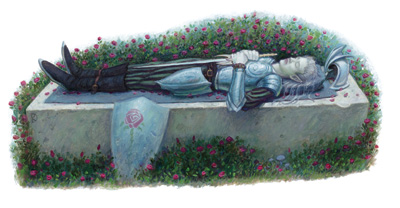
The Ghost Blade:
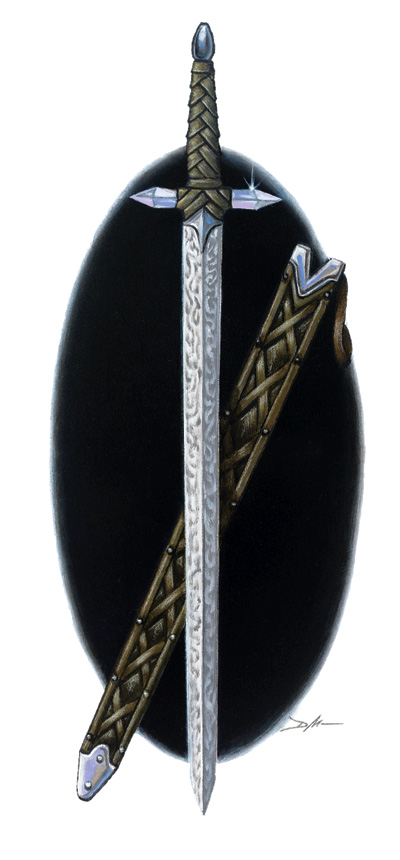
Tag and Chase:
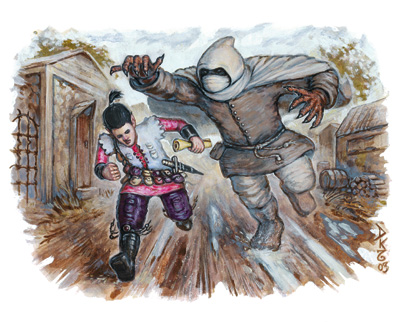
Gnome Work Crew:
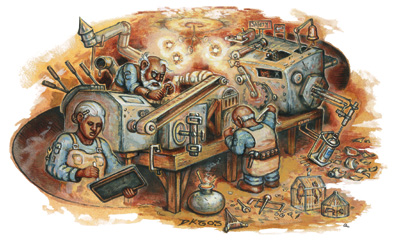
Mobile Bookshelf with Selector Arm (Gnome invention):
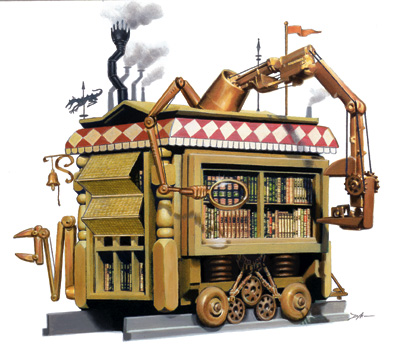
Dragon Mountain Monument:
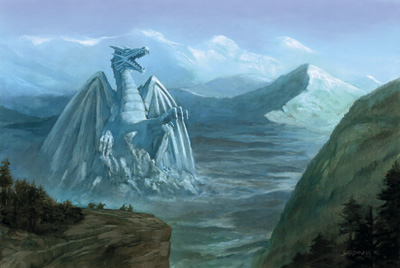
Untitled (Looks to be a Gnomish Contraption):
